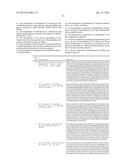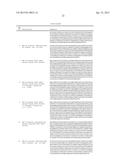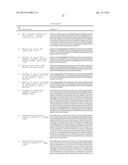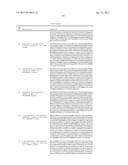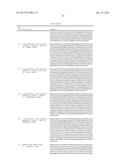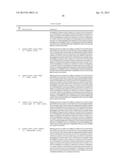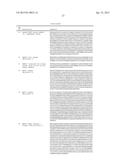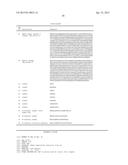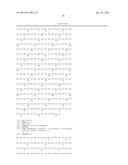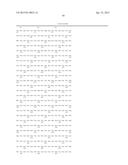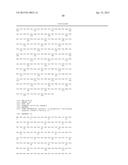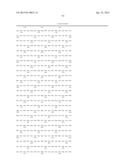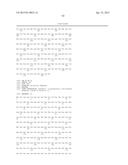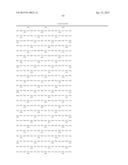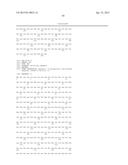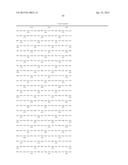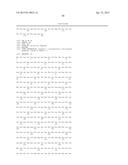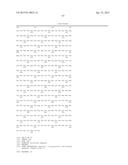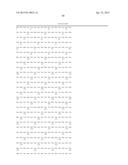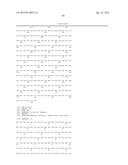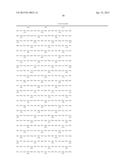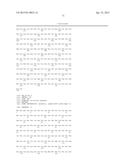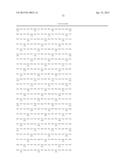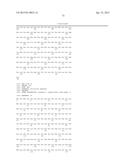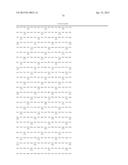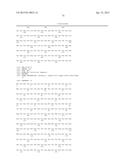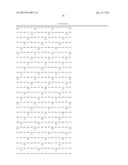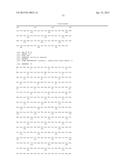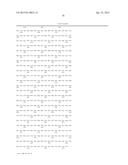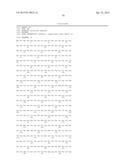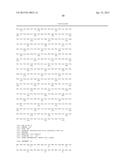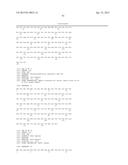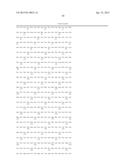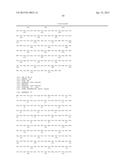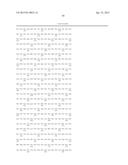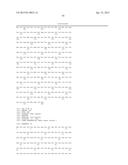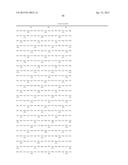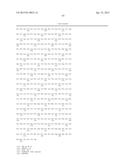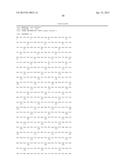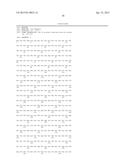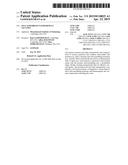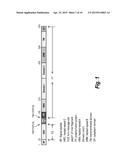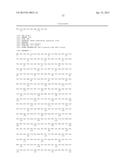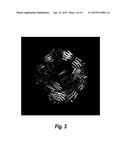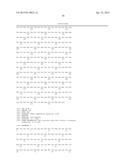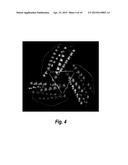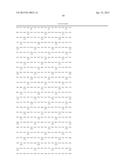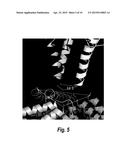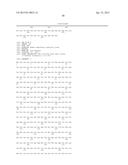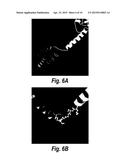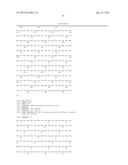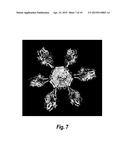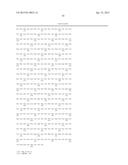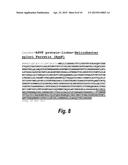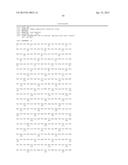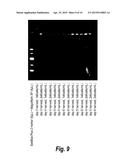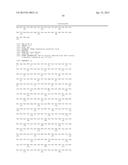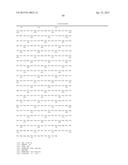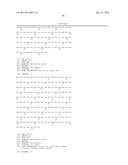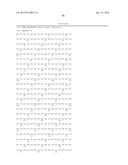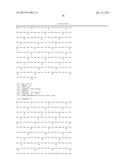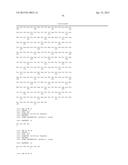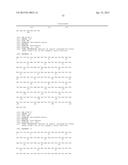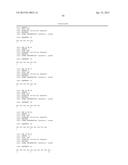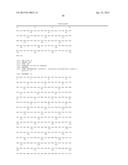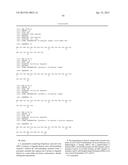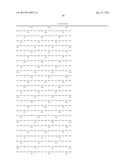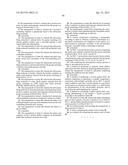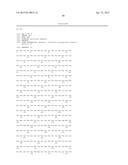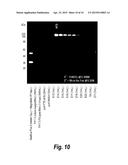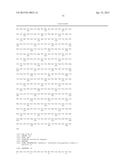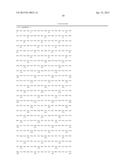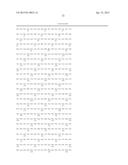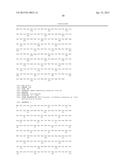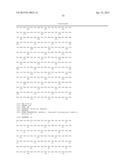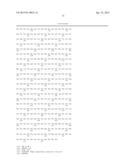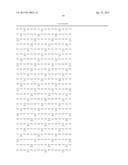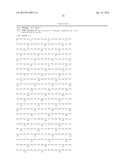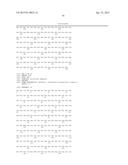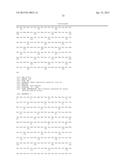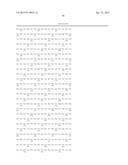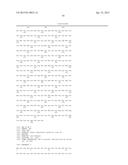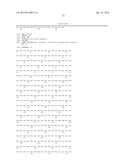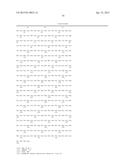Patent application title: SELF-ASSEMBLED NANOPARTICLE VACCINES
Inventors:
Ram Sasisekharan (Cambridge, MA, US)
Ram Sasisekharan (Cambridge, MA, US)
Aditya Raguram (Cambridge, MA, US)
Vidya Subramanian (Waltham, MA, US)
IPC8 Class: AA61K39155FI
USPC Class:
4241861
Class name: Antigen, epitope, or other immunospecific immunoeffector (e.g., immunospecific vaccine, immunospecific stimulator of cell-mediated immunity, immunospecific tolerogen, immunospecific immunosuppressor, etc.) amino acid sequence disclosed in whole or in part; or conjugate, complex, or fusion protein or fusion polypeptide including the same disclosed amino acid sequence derived from virus
Publication date: 2015-04-23
Patent application number: 20150110825
Abstract:
The present invention provides nanoparticles and compositions of various
constructs that combine meta-stable viral proteins (e.g., RSV F protein)
and self-assembling molecules (e.g., ferritin, HSPs) such that the
pre-fusion conformational state of these key viral proteins is preserved
(and locked) along with the protein self-assembling into a polyhedral
shape, thereby creating nanoparticles that are effective vaccine agents.
The invention also provides nanoparticles comprising a viral fusion
protein, or fragment or variant thereof, and a self-assembling molecule,
and immunogenic and vaccine compositions including the same.Claims:
1. A nanoparticle comprising Respiratory syncytial virus (RSV) F protein,
or fragment thereof, and a self-assembling molecule, wherein the
self-assembling molecule forms a polymeric assembly that captures the F
protein or fragment thereof in a meta-stable pre-fusion conformation,
thereby forming the nanoparticle.
2. The nanoparticle of claim 1, wherein the F protein comprises (a) an F1 and F2 heterodimer, (b) an ectodomain, (c) a heptad-repeat A domain (HRA) and a heptad-repeat C domain (HRC), (d) an HRA domain, an HRC domain, and F1 domains I and II, (e) an HRA domain, an HRC domain, F1 domains I and II, and a heptad-repeat B domain (HRB), or (f) one or more homotrimers of F1 and F2.
3-7. (canceled)
8. The nanoparticle of claim 1, wherein the F protein comprises an amino acid sequence selected from the group consisting of SEQ ID NOs: 1-12.
9. The nanoparticle of claim 1, wherein the F protein is covalently attached or genetically fused to the self-assembling molecule.
10. (canceled)
11. The nanoparticle of claim 1, wherein the self-assembling molecule is selected from the group consisting of a protein, peptide, nucleic acid, a virus-like particle, a viral capsid, lipid, and carbohydrate.
12. The nanoparticle of claim 11, wherein the self-assembling molecule assembles into a shell with polyhedral symmetry.
13. The nanoparticle of claim 12, wherein the shell has an octahedral symmetry.
14. The nanoparticle of claim 13, wherein the shell comprises twenty four monomers of the self-assembling molecule.
15. The nanoparticle of claim 11, wherein the self-assembling molecule is a protein selected from the group consisting of ferritin, heat shock protein, and Dsp.
16. (canceled)
17. The nanoparticle of claim 15, wherein the self-assembling molecule is ferritin, wherein the ferritin comprises an amino acid sequence selected from the group consisting of SEQ ID NOs: 13-17.
18. The nanoparticle of claim 15, wherein the self-assembling molecule is a heat shock protein, selected from the group consisting of, sHSP (small heat shock protein), HSP100, HSP90, HSP70, and HSP60.
19. The nanoparticle of claim 15, wherein the self-assembling molecule is a heat shock protein, wherein the heat shock protein comprises an amino acid sequence selected from the group consisting of SEQ ID NOs: 36-42.
20. The nanoparticle of claim 1, wherein the F protein and self-assembling molecule are attached by means of a linker.
21. The nanoparticle of claim 20, wherein the linker is of sufficient length to prevent steric hindrance between the self-assembling molecule and F protein.
22. The nanoparticle of claim 20, wherein the linker is a gly-ser linker.
23. (canceled)
24. The nanoparticle of claim 1, wherein the amino acid sequence of the F protein further comprises an N-terminal leader that facilitates secretion from cells.
25. The nanoparticle of claim 24, wherein the N-terminal leader comprises an amino acid sequence selected from the group consisting of SEQ ID NOs: 51-53.
26. An immunogenic composition comprising the nanoparticle of claim 1 and a pharmaceutically acceptable carrier, optionally further comprising an adjuvant.
27. (canceled)
28. A vaccine composition comprising a nanoparticle according to claim 1, wherein F protein homotrimers in a pre-fusion conformation are displayed on the surface of a shell formed by polymeric assembly of the self-assembly molecule, optionally further comprising an adjuvant.
29. (canceled)
30. An RSV F protein-ferritin fusion protein comprising the amino acid sequence selected from the group consisting of SEQ ID NOs: 18-21, 24-27, and 30-33.
31. An RSV F protein-heat shock protein fusion protein comprising the amino acid sequence selected from the group consisting of SEQ ID NO: 22, 23, 28, 29, 34, and 35.
32. A kit comprising the nanoparticle or fusion protein of claim 1, and instructions for use.
33. A method of producing an antibody which inhibits and/or prevents RSV infection comprising administering to a subject the nanoparticle of claim 1, optionally comprising isolating the antibody from the subject.
34. (canceled)
35. A method of producing a vaccine against RSV, the method comprising a) expressing a complex comprising a monomeric self-assembly molecule and an RSV F protein under conditions such that F protein trimers in a pre-fusion conformation are displayed on the surface of a shell formed by polymerization of the self-assembly molecule, and b) recovering the shell displaying the F protein.
36. A method of vaccinating a subject against RSV comprising administering to the subject a vaccine produced according to the method of claim 35.
37. The method of claim 36, wherein the linker attachment point on the F protein is leucine at position 513 of SEQ ID NO: 1, and the linker attachment point on ferritin is aspartic acid at position 5 of SEQ ID NO: 13.
38. An isolated nucleic acid encoding the nanoparticle or fusion protein of claim 1.
39. A vector comprising the nucleic acid of claim 38.
40. An isolated cell comprising the nucleic acid of claim 39.
Description:
RELATED APPLICATIONS
[0001] This application claims priority to and the benefit of U.S. Provisional Patent Application No. 61/881,848, filed Sep. 24, 2013, the entire contents of which is herein incorporated by reference.
BACKGROUND
[0002] Human respiratory syncytial virus (RSV) is a negative-sense, single-stranded RNA virus of the family Paramyxoviridae and a member of the paramyxovirus subfamily Pneumovirinae. RSV is a major cause of lower respiratory tract infections in young children, and often results in multiple hospital visits during the first few years of a child's life. In fact, because the protective immunity produced following natural infection with RSV wanes over time, it is possible to be infected with RSV multiple times and some infants can become infected with RSV more than once a season. Although prophylactic treatment for RSV in young children is available, previous efforts to produce a vaccine against RSV have been unsuccessful. Due to the complexity of RSV proteins, it is difficult to obtain homogeneous immunogenic preparations of the proteins. Accordingly, there is a need for improved RSV protein compositions and vaccines, and improved methods of producing the same.
SUMMARY OF THE INVENTION
[0003] One of the major challenges to vaccine development for several viruses (e.g., RSV, Flaviviruses (e.g., Dengue, West Nile), and HIV) is to `capture` their key viral protein in the `pre-fusion` state which is critical as it `presents` important residues on the viral protein that are critical for virus fusion with host cells. It is usually difficult to capture these viral proteins in this state, as they quickly fuse and undergo conformational changes. Thus, creating a mechanism that preserves and `locks` the pre-fusion state of these `meta-stable` viral proteins would enable the development of more effective vaccines against these viral agents. Accordingly, methods that allow for locking meta-stable viral proteins in their pre-fusion state are highly desirable.
[0004] The concept of self-assembling nanoparticles has been applied to create new vaccine technologies. Molecules such as ferritin and heat shock proteins (HSPs) are known to naturally assemble into polyhedral shapes. By genetically attaching a meta-stable viral proteins to a self-assembling protein, various polyhedral nanoparticles are created. A protein-based nanoparticle that incorporates meta-stable viral proteins in their pre-fusion states can be used as an effective vaccine against these viral agents. However, there are major limitations or challenges to the use self-assembling systems for meta-stable viral proteins as it is not obvious that just linking such proteins via their N or C terminus to a self-assembly molecule such as ferritin or a heat shock protein would preserve the proper orientation or lock the meta-stable viral protein conformation for effective vaccine design. Therefore, an important consideration in the creation of the meta-stable viral protein based nanoparticles is how to attach the meta-stable protein to the self-assembling molecule such that it does not interfere with the self-assembly of the molecule and lock the meta-stable protein in its pre-fusion conformation.
[0005] This invention outlines nanoparticles and compositions of various constructs that combine exemplary meta-stable viral proteins (e.g., RSV F protein) and self-assembling molecules (e.g., ferritin, HSPs) such that the pre-fusion conformational state of these key viral proteins is preserved (and locked) along with the protein self-assembling into a polyhedral shape, thereby creating nanoparticles that are effective vaccine agents.
[0006] The present invention, in general, relates to nanoparticles comprising a viral fusion protein, or fragment or variant thereof, and a self-assembling molecule, and immunogenic and vaccine compositions including the same.
[0007] Accordingly, in one aspect, the invention relates to a nanoparticle comprising a viral fusion protein, such as Respiratory syncytial virus (RSV) F protein, or fragment (e.g., truncation) thereof, and a self-assembling molecule, wherein the self-assembling molecule forms a polymeric assembly that captures the viral fusion protein (e.g., F protein) or fragment thereof in a meta-stable pre-fusion conformation, thereby forming the nanoparticle.
[0008] In some aspects, the invention relates to an immunogenic composition comprising a nanoparticle of the invention and a pharmaceutically acceptable carrier. In some embodiments, the immunogenic composition comprises an adjuvant.
[0009] In some aspects, the invention relates to a vaccine composition comprising a nanoparticle of the invention, wherein the viral fusion protein homotrimers, such as F protein homotrimers, in a pre-fusion conformation are displayed on the surface of a shell formed by polymeric assembly of the self-assembly molecule. In some embodiments, the vaccine comprises an adjuvant.
[0010] In some embodiments, the viral fusion protein is a class I, II or III fusion protein. In some embodiments, the viral fusion protein adopts a dimeric or trimeric quaternary structure.
[0011] In some embodiments, the viral fusion protein is a Paramyxoviridae, Flaviviridae, or Retroviridae viral fusion protein. In some embodiments, the Flavivirdae viral fusion protein is a Flavivirus. In some embodiments, the Flavivirus is West Nile virus, Dengue virus or yellow fever virus. In other embodiments, the virus is Dengue virus and the fusion protein is E protein. In some embodiments, the Paramyxoviridae viral fusion protein is a Paramyxovirinae or Pneumonvirinae virus, such as Avularvirus, Respirovirus, and Pneumovirus. In some embodiments, the virus is New Castle disease virus, Sendai virus, and Respiratory syncytial virus (RSV). In other embodiments, the virus is RSV and the fusion protein is F protein.
[0012] In some embodiments, the F protein, or fragment thereof, lacks the transmembrane domain and cytotail domain (amino acids 1-524; SEQ ID NO: 2). In some embodiments, the F protein, or fragment thereof, lacks the transmembrane domain and cytotail domain and a portion of the HRB domain (amino acids 1-513; SEQ ID NO: 3). In some embodiments, the F protein comprises an F1 and F2 heterodimer. In some embodiments, the F protein, or fragment thereof, comprises the F1 domain (e.g., from about amino acid 137 to about amino acid 524 (SEQ ID NO: 5), or from about amino acid 137 to about amino acid 513 (SEQ ID NO: 6)). In some embodiments, the F protein, or fragment thereof, comprises an F protein, or fragment thereof, without the N-terminal sequence MELLILKANAITTILTAVTFCFASG (SEQ ID NO: 54). In some embodiments, the F protein fragment comprises an ectodomain. In some embodiments, the F protein fragment comprises a heptad-repeat A domain (HRA) and a heptad-repeat C domain (HRC). In some embodiments, the F protein fragment comprises an HRA domain, an HRC domain, and F1 domains I and II. In some embodiments, the F protein fragment comprises an HRA domain, an HRC domain, F1 domains I and II, and a heptad-repeat B domain (HRB). In some embodiments, the nanoparticle comprises one or more homotrimers of F1 and F2.
[0013] In some embodiments, the F protein comprises an amino acid sequence set forth in SEQ ID NOs:1-12.
[0014] In some embodiments, the viral fusion protein, such as the F protein, is covalently attached to the self-assembling molecule.
[0015] In some embodiments, the viral fusion protein, such as the F protein (e.g., an F protein from SEQ ID NOs: 1-12), is genetically fused to the self-assembling molecule.
[0016] In some embodiments, the self-assembling molecule is proteinaceous or non-proteinaceous. In some embodiments, the self-assembling molecule is a protein, peptide, nucleic acid, a virus-like particle, a viral capsid, lipid, or carbohydrate. In some embodiments, the self-assembling molecule assembles into a shell with polyhedral symmetry, such as octahedral symmetry. In some embodiments, the shell comprises twenty four monomers of the self-assembling molecule.
[0017] In some embodiments, self-assembling molecule is ferritin, heat shock protein, Dsp, lumazine synthase or MrgA. In some embodiments, the ferritin protein comprises an amino acid sequence set forth in SEQ ID NOs:13-17. In some embodiments, the self-assembling molecule is a heat shock protein, such as sHSP (small heat shock protein), HSP100, HSP90, HSP70, and HSP60. In some embodiments, the heat shock protein comprises an amino acid sequence set forth in SEQ ID NOs:36-42.
[0018] In some embodiments, the viral fusion protein (e.g., F protein) and self-assembling molecule are attached by means of a linker, such as an amino acid linker (e.g., a gly-ser linker). In some embodiments, the linker is a (GlySer)n linker. In some embodiments, the linker is of sufficient length to prevent steric hindrance between the self-assembling molecule and the viral fusion protein (e.g., F protein). For example, in some embodiments, the linker is about 5 to 7 amino acids long. In some embodiments, the linker attachment point on the F protein is leucine at position 513 of SEQ ID NO: 1, and the linker attachment point on ferritin is aspartic acid at position 5 of SEQ ID NO: 13.
[0019] In some embodiments, the viral fusion protein (e.g., F protein) further comprises an N-terminal leader in order to facilitate effective secretion of recombinant proteins from transfected cells (e.g., 293 cells) into the culture medium. Non-limiting N-terminal leader sequences include those set forth in SEQ ID NOs: 51-53.
[0020] In another aspect, the invention relates to an RSV F protein-ferritin fusion protein comprising the amino acid sequence set forth in SEQ ID NOs: 18-21, 24-27, or 30-33.
[0021] In another aspect, the invention relates to RSV F protein-heat shock protein fusion protein comprising the amino acid sequence set forth in SEQ ID NOs: 22, 23, 28, 29, 34, or 35.
[0022] In another aspect, the invention relates to a method of producing an antibody which inhibits and/or prevents RSV infection comprising administering to a subject the nanoparticle, immunogenic composition, vaccine composition, or fusion protein of the invention. In some embodiments, the antibody is isolated from the subject.
[0023] In another aspect, the invention relates to a method of producing a vaccine against RSV, the method comprising a) expressing a complex comprising a monomeric self-assembly molecule and an RSV F protein under conditions such that F protein trimers in a pre-fusion conformation are displayed on the surface of a shell formed by polymerization of the self-assembly molecule, and b) recovering the shell displaying the F protein. In some embodiments, the subject is vaccinated against RSV with the vaccine of the present invention.
[0024] In yet another aspect, the invention relates to isolated nucleic acids encoding the nanoparticle or fusion protein of the invention, vectors comprising the nucleic acids, and isolated cells comprising the nucleic acids.
[0025] In yet another aspect, the invention relates to a kit comprising the nanoparticle or fusion protein of the invention and instructions for use.
BRIEF DESCRIPTION OF THE FIGURES
[0026] FIG. 1 shows a schematic representation of the RSV F protein. The protein domains are designated in the figure.
[0027] FIG. 2 shows the structure of a ferritin shell (ferritin cage) composed of twenty-four ferritin monomers that occupy each of the twenty-four symmetry domains of an octahedral symmetry.
[0028] FIG. 3 shows the structure of a heat shock protein shell (HSP cage) composed of twenty-four monomers that self assemble into a shell with octahedral symmetry.
[0029] FIG. 4 shows the three "equivalent" points on a ferritin monomer. Connecting these points yields a triangle whose centroid lies on the three-fold axis of symmetry.
[0030] FIG. 5 shows the process of orienting the RSV F protein trimers and ferritin trimers along the same three-fold axis. Each RSV F protein monomer is linked at Leu513 to the Asp5 residue of a ferritin monomer. Connecting each of these sets of residues forms two equilateral triangles with side lengths of 12.1 angstroms for the RSV F protein trimer and 28.7 angstroms for the ferritin trimer.
[0031] FIG. 6A shows the structure of a RSV F protein monomer linked to a ferritin monomer via a linker. FIG. 6B shows a zoomed in version of the linker shown in FIG. 6A.
[0032] FIG. 7 shows an octahedral ferritin-F protein nanoparticle with twenty-four F proteins in total oriented about the three-fold axes.
[0033] FIG. 8 shows the amino acid sequence of an exemplary RSVF protein-linker-Helicobacter pylori ferritin (HypF) ("RSVF-HypF") fusion protein (SEQ ID NO: 30). The leader sequence (a human CD5 leader sequence) is in regular font, the RSV F domain is bolded, the linker is in italics, and the HypF domain is bolded/underlined.
[0034] FIG. 9 shows the expression over time of a RSVF-HypF fusion protein in 293F cells plated at two different cell densities by Western blot. Supernatants were harvested on days 3, 4, 5, and 6. The D25 antibody, which specifically detects the pre-fusion state of the RSV F protein, was used for detection. The molecular weight suggests the band corresponds to a trimer and that the protein is expressed in the pre-fusion state.
[0035] FIG. 10 shows the purification of the RSVF-HypF fusion protein from FIG. 9. Proteins were eluted off the column using a NaCl gradient. All elution fractions were detected using the monoclonal D25 antibody.
DETAILED DESCRIPTION
Definitions
[0036] Terms used in the claims and specification are defined as set forth below unless otherwise specified. In the case of direct conflict with a term used in a parent provisional patent application, the term used in the instant specification shall control.
[0037] "Amino acid" refers to naturally occurring and synthetic amino acids, as well as amino acid analogs and amino acid mimetics that function in a manner similar to the naturally occurring amino acids. Naturally occurring amino acids are those encoded by the genetic code, as well as those amino acids that are later modified, e.g., hydroxyproline, γ-carboxyglutamate, and O-phosphoserine. Amino acid analogs refers to compounds that have the same basic chemical structure as a naturally occurring amino acid, i.e., an α carbon that is bound to a hydrogen, a carboxyl group, an amino group, and an R group, e.g., homoserine, norleucine, methionine sulfoxide, methionine methyl sulfonium. Such analogs have modified R groups (e.g., norleucine) or modified peptide backbones, but retain the same basic chemical structure as a naturally occurring amino acid. Amino acid mimetics refers to chemical compounds that have a structure that is different from the general chemical structure of an amino acid, but that function in a manner similar to a naturally occurring amino acid.
[0038] Amino acids can be referred to herein by either their commonly known three letter symbols or by the one-letter symbols recommended by the IUPAC-IUB Biochemical Nomenclature Commission. Nucleotides, likewise, can be referred to by their commonly accepted single-letter codes.
[0039] An "amino acid substitution" refers to the replacement of at least one existing amino acid residue in a predetermined amino acid sequence (an amino acid sequence of a starting polypeptide) with a second, different "replacement" amino acid residue. An "amino acid insertion" refers to the incorporation of at least one additional amino acid into a predetermined amino acid sequence. While the insertion will usually consist of the insertion of one or two amino acid residues, the present larger "peptide insertions," can be made, e.g. insertion of about three to about five or even up to about ten, fifteen, or twenty amino acid residues. The inserted residue(s) may be naturally occurring or non-naturally occurring as disclosed above. An "amino acid deletion" refers to the removal of at least one amino acid residue from a predetermined amino acid sequence.
[0040] "Polypeptide," "peptide", and "protein" are used interchangeably herein to refer to a polymer of amino acid residues. The terms apply to amino acid polymers in which one or more amino acid residue is an artificial chemical mimetic of a corresponding naturally occurring amino acid, as well as to naturally occurring amino acid polymers and non-naturally occurring amino acid polymer.
[0041] "Nucleic acid" refers to deoxyribonucleotides or ribonucleotides and polymers thereof in either single- or double-stranded form. Unless specifically limited, the term encompasses nucleic acids containing known analogues of natural nucleotides that have similar binding properties as the reference nucleic acid and are metabolized in a manner similar to naturally occurring nucleotides. Unless otherwise indicated, a particular nucleic acid sequence also implicitly encompasses conservatively modified variants thereof (e.g., degenerate codon substitutions) and complementary sequences and as well as the sequence explicitly indicated. Specifically, degenerate codon substitutions can be achieved by generating sequences in which the third position of one or more selected (or all) codons is substituted with mixed-base and/or deoxyinosine residues (Batzer et al., Nucleic Acid Res. 19:5081, 1991; Ohtsuka et al., J. Biol. Chem. 260:2605-2608, 1985); and Cassol et al., 1992; Rossolini et al., Mol. Cell. Probes 8:91-98, 1994). For arginine and leucine, modifications at the second base can also be conservative. The term nucleic acid is used interchangeably with gene, cDNA, and mRNA encoded by a gene. Polynucleotides of the present invention can be composed of any polyribonucleotide or polydeoxribonucleotide, which can be unmodified RNA or DNA or modified RNA or DNA. For example, polynucleotides can be composed of single- and double-stranded DNA, DNA that is a mixture of single- and double-stranded regions, single- and double-stranded RNA, and RNA that is mixture of single- and double-stranded regions, hybrid molecules comprising DNA and RNA that can be single-stranded or, more typically, double-stranded or a mixture of single- and double-stranded regions. In addition, the polynucleotide can be composed of triple-stranded regions comprising RNA or DNA or both RNA and DNA. A polynucleotide can also contain one or more modified bases or DNA or RNA backbones modified for stability or for other reasons. "Modified" bases include, for example, tritylated bases and unusual bases such as inosine. A variety of modifications can be made to DNA and RNA; thus, "polynucleotide" embraces chemically, enzymatically, or metabolically modified forms.
[0042] As used herein, the terms "linked," "fused," or "fusion," in the context of joining together of two more elements or components or domains by whatever means including chemical conjugation or recombinant means (e.g., by genetic fusion) are used interchangably. Methods of chemical conjugation (e.g., using heterobifunctional crosslinking agents) are known in the art. More specifically, as used herein, "viral fusion protein-self-assembling molecule complex or fusion" refers to the genetic or chemical conjugation of a meta-stable viral fusion protein (e.g., RSV F protein) to a self-assembling molecule, which may or may not be proteinaceous. As used herein, "viral fusion protein-self-assembling molecule fusion protein" refers to the genetic or chemical conjugation of a meta-stable viral fusion protein (e.g., RSV F protein) to a proteinaceous self-assembling molecule (e.g., ferritin, HSP). In a preferred embodiment, the viral fusion protein is fused to a proteinaceous self-assembling molecule, such as ferritin or HSP, via a linker, such as a glycine-serine (gly-ser) linker.
[0043] As used herein, the term "gly-ser linker" refers to a peptide that consists of glycine and serine residues.
[0044] As used herein, the term "proline-alanine (pro-ala)" linker refers to a peptide that consists of proline and alanine residues.
[0045] A polypeptide or amino acid sequence "derived from" a designated polypeptide or protein refers to the origin of the polypeptide. Preferably, the polypeptide or amino acid sequence which is derived from a particular sequence has an amino acid sequence that is essentially identical to that sequence or a portion thereof, wherein the portion consists of at least 10-20 amino acids, preferably at least 20-30 amino acids, more preferably at least 30-50 amino acids, or which is otherwise identifiable to one of ordinary skill in the art as having its origin in the sequence.
[0046] Polypeptides derived from another peptide may have one or more mutations relative to the starting polypeptide, e.g., one or more amino acid residues which have been substituted with another amino acid residue or which has one or more amino acid residue insertions or deletions.
[0047] A polypeptide can comprise an amino acid sequence which is not naturally occurring. Such `variants` necessarily have less than 100% sequence identity or similarity with the starting molecule. In a preferred embodiment, the variant will have an amino acid sequence from about 75% to less than 100% amino acid sequence identity or similarity with the amino acid sequence of the starting polypeptide, more preferably from about 80% to less than 100%, more preferably from about 85% to less than 100%, more preferably from about 90% to less than 100% (e.g., 91%, 92%, 93%, 94%, 95%, 96%, 97%, 98%, 99%) and most preferably from about 95% to less than 100%, e.g., over the length of the variant molecule.
[0048] In one embodiment, there is one amino acid difference between a starting polypeptide sequence and the sequence derived therefrom. Identity or similarity with respect to this sequence is defined herein as the percentage of amino acid residues in the candidate sequence that are identical (i.e., same residue) with the starting amino acid residues, after aligning the sequences and introducing gaps, if necessary, to achieve the maximum percent sequence identity.
[0049] In an embodiment, the peptides of the invention are encoded by a nucleotide sequence. Nucleotide sequences of the invention can be useful for a number of applications, including: cloning, gene therapy, protein expression and purification, mutation introduction, DNA vaccination of a host in need thereof, antibody generation for, e.g., passive immunization, PCR, primer and probe generation, and the like.
[0050] It will also be understood by one of ordinary skill in the art that the viral fusion protein or self-assembling proteins (an results protein fusions) may be altered such that they vary in sequence from the naturally occurring or native sequences from which they were derived, i.e., referred to as "variants," while retaining the desirable activity (e.g., folding or self-assembly) of the native sequences. For example, nucleotide or amino acid substitutions leading to conservative substitutions or changes at "non-essential" amino acid residues may be made. Mutations may be introduced by standard techniques, such as site-directed mutagenesis and PCR-mediated mutagenesis.
[0051] A "conservative amino acid substitution" is one in which the amino acid residue is replaced with an amino acid residue having a similar side chain. Families of amino acid residues having similar side chains have been defined in the art, including basic side chains (e.g., lysine, arginine, histidine), acidic side chains (e.g., aspartic acid, glutamic acid), uncharged polar side chains (e.g., glycine, asparagine, glutamine, serine, threonine, tyrosine, cysteine), nonpolar side chains (e.g., alanine, valine, leucine, isoleucine, proline, phenylalanine, methionine, tryptophan), beta-branched side chains (e.g., threonine, valine, isoleucine) and aromatic side chains (e.g., tyrosine, phenylalanine, tryptophan, histidine). Thus, a nonessential amino acid residue in a binding polypeptide is preferably replaced with another amino acid residue from the same side chain family. In another embodiment, a string of amino acids can be replaced with a structurally similar string that differs in order and/or composition of side chain family members.
[0052] As used herein, the term "infectious agent" refers to microorganisms that cause an infection in a vertebrate. Usually, the organisms are viruses, bacteria, parasites, protozoa and/or fungi.
[0053] As used herein, the term "antigenic formulation" or "antigenic composition" or "immunogenic composition" refers to a preparation which, when administered to a vertebrate, especially a bird or a mammal, will induce an immune response.
[0054] Enveloped viruses penetrate the host cells by a process of fusion between the viral and cell membranes. This process is catalyzed by a fusiongenic activity of a viral surface glycoprotein. A characteristic feature of the fusion glycoproteins for many membrane-enveloped viruses is that they are synthesized as inactive precursors which undergo several post-transitional modifications to be displayed on virions in metastable forms.
[0055] As used herein, the term "meta-stable", as used in the context of a protein (e.g., a viral fusion protein such as the RSV F protein), refers to a labile conformational state that rapidly converts to a more stable conformational state upon a change in conditions. For example, the pre-fusion RSV F protein is in a labile meta-stable conformation, and converts to the more stable post-fusion conformation upon, e.g., fusion to a host cell.
[0056] As used herein, the term "self-assembling molecule" refers to a molecule that undergoes spontaneous or induced assembly into defined, stable, noncovalently bonded assemblies that are held together by intermolecular forces. Self-assembling molecules include protein, peptides, nucleic acids, virus-like particles, lipids and carbohydrates. Non-limiting examples of self-assembling molecules include ferritin, heat shock protein, DSP, lumazine synthase, and DNA.
[0057] As used herein, the term "protein cage" or "protein shell` refers to a composition of a proteinaceous shell that self-assembles to form a protein cage (a structure with an interior cavity which is either naturally accessible to the solvent or can be made to be so by altering solvent concentration, pH, equilibria ratios, etc.)
[0058] As used herein, the term "nanoparticle" encompasses a protein cage, but also includes cages that are not proteinaceous, which includes both the shell (e.g., protein cage) and the nanoparticle core, which may or may not be loaded with cargo (e.g., adjuvant, therapeutic agent, imaging agent).
[0059] As used herein, the term "RSV F protein" and "F protein" and "Fusion protein" and "F protein polypeptide" and "Fusion protein polypeptide" are used interchangeably and refer to a polypeptide or protein having all or part of an amino acid sequence of an RSV Fusion protein polypeptide. Numerous RSV Fusion proteins, and variants (e.g., naturally occurring variants) have been described and are known to those of skill in the art (see, e.g., WO2008/114149 corresponding to US 20100203071, the contents of which are incorporated herein by reference). FIG. 4 of US 20100203071 shows an alignment of a number of RSV F protein variants which can be used in the present invention.
[0060] The term "pre-fusion," as used in the context of an infectious agent, refers to the conformation of a protein of the infectious agent prior to fusion to a host cell. The term "post-fusion," in this context, refers to the conformation of a protein of the infectious agent after fusion to a host cell.
[0061] The "post-fusion conformation" of RSV F protein is a trimer characterized by the presence of a six-helix bundle comprising 3 HRB and 3HRA regions. The post-fusion conformation of RSV F protein is typically characterized as having a "crutch" or "golf tee" conformation.
[0062] The "pre-fusion conformation" of RSV F protein is a conformation characterized by a trimer that contains a triple helix comprising 3 HRB regions. The post-fusion conformation of RSV F protein is typically characterized as having a "lollipop" or "ball and stem" conformation.
[0063] As used herein, "RSV F ecto-domain polypeptide" refers to an RSV F protein polypeptide that contains substantially the extracellular portion of mature RSV F protein, with or without the signal peptide (e.g., about amino acids 1 to about amino acid 524 (SEQ ID NO: 2), or about amino acid 22 to about amino acid 524), but lacks the transmembrane domain and cytoplasmic tail of naturally occurring RSV F protein. In some embodiments, the RSV F protein polypeptide contains substantially the extracellular portion of mature RSV F protein, with or without the signal peptide, and lacking the transmembrane domain, cytoplasmic tail, and part of the HRB domain (e.g., about amino acids 1 to about amino acid 513 (SEQ ID NO: 3), or about amino acid 22 to about amino acid 513, for example, 26-513 (SEQ ID NO: 4).
[0064] As used herein, "cleaved RSV F ecto-domain polypeptide" refers to a RSV F ectodomain polypeptide that has been cleaved at one or more positions from about 101/102 to about 160/161 to produce two subunits, in which one of the subunits comprises F1 and the other subunit comprises F2.
[0065] As used herein, "C-terminal uncleaved RSV F ecto-domain polypeptide" refers to an RSV F ectodomain polypeptide that is cleaved at one or more positions from about 101/102 to about 131/132, and is not cleaved at one or more positions from about 132/133 to about 160/161, to produce two subunits, in which one of the subunits comprises F1 and the other subunit comprises F2.
[0066] As used herein, "uncleaved RSV F ecto-domain polypeptide" refers to an RSV F ectodomain polypeptide that is not cleaved at one or more positions from about 101/102 to about 160/161. An uncleaved RSV F ecto-domain polypeptide can be, for example, a monomer or a trimer.
[0067] As used herein, the term "immunogens" or "antigens" refer to substances such as proteins, peptides, peptides, nucleic acids that are capable of eliciting an immune response. Both terms also encompass epitopes, and are used interchangeably.
[0068] As used herein, the term "vaccine" refers to a formulation which contains the fusion proteins or nanoparticles of the present invention, which is in a form that is capable of being administered to a vertebrate and which induces a protective immune response sufficient to induce immunity to prevent and/or ameliorate an infection and/or to reduce at least one symptom of an infection and/or to enhance the efficacy of another dose of the fusion proteins or nanoparticles. Typically, the vaccine comprises a conventional saline or buffered aqueous solution medium in which the composition of the present invention is suspended or dissolved. In this form, the composition of the present invention can be used conveniently to prevent, ameliorate, or otherwise treat an infection. Upon introduction into a host, the vaccine is able to provoke an immune response including, but not limited to, the production of antibodies and/or cytokines and/or the activation of cytotoxic T cells, antigen presenting cells, helper T cells, dendritic cells and/or other cellular responses. Vaccines can be administered in conjunction with an adjuvant.
[0069] As used herein, the term "adjuvant" refers to a compound that, when used in combination with a specific immunogen in a formulation, will augment or otherwise alter or modify the resultant immune response. Modification of the immune response includes intensification or broadening the specificity of either or both antibody and cellular immune responses. Modification of the immune response can also mean decreasing or suppressing certain antigen-specific immune responses.
[0070] As used herein, the term "pharmaceutically acceptable vaccine" refers to a formulation which contains a fusion protein, or nanoparticles of the present invention, which is in a form that is capable of being administered to a vertebrate and which induces a protective immune response sufficient to induce immunity to prevent and/or ameliorate an infection or disease, and/or to reduce at least one symptom of an infection or disease, and/or to enhance the efficacy of another dose of a fusion protein or nanoparticle. In one embodiment, to a formulation which contains a fusion protein, or nanoparticle, of the present invention. Typically, the vaccine comprises a conventional saline or buffered aqueous solution medium in which the composition of the present invention is suspended or dissolved. In this form, the composition of the present invention can be used conveniently to prevent, ameliorate, or otherwise treat an infection. Upon introduction into a host, the vaccine is able to provoke an immune response including, but not limited to, the production of antibodies and/or cytokines and/or the activation of cytotoxic T cells, antigen presenting cells, helper T cells, dendritic cells and/or other cellular responses.
[0071] As used herein, the term "ameliorating" refers to any therapeutically beneficial result in the treatment of a disease state, e.g., viral infection, including prophylaxis, lessening in the severity or progression, remission, or cure thereof.
[0072] As used herein, the term "in vivo" refers to processes that occur in a living organism.
[0073] The term "mammal" or "subject" or "patient" as used herein includes both humans and non-humans and include but is not limited to humans, non-human primates (e.g., chimpanzees, monkeys, baboons), canines, felines, mice, rats (e.g., cotton rats), bovines (e.g., calves), equines, porcines, guinea pigs, ferrets and hamsters.
[0074] As used herein, the term percent "identity," in the context of two or more nucleic acid or polypeptide sequences, refer to two or more sequences or subsequences that have a specified percentage of nucleotides or amino acid residues that are the same, when compared and aligned for maximum correspondence, as measured using one of the sequence comparison algorithms described below (e.g., BLASTP and BLASTN or other algorithms available to persons of skill) or by visual inspection. Depending on the application, the percent "identity" can exist over a region of the sequence being compared, e.g., over a functional domain, or, alternatively, exist over the full length of the two sequences to be compared.
[0075] For sequence comparison, typically one sequence acts as a reference sequence to which test sequences are compared. When using a sequence comparison algorithm, test and reference sequences are input into a computer, subsequence coordinates are designated, if necessary, and sequence algorithm program parameters are designated. The sequence comparison algorithm then calculates the percent sequence identity for the test sequence(s) relative to the reference sequence, based on the designated program parameters.
[0076] Optimal alignment of sequences for comparison can be conducted, e.g., by the local homology algorithm of Smith & Waterman, Adv. Appl. Math. 2:482 (1981), by the homology alignment algorithm of Needleman & Wunsch, J. Mol. Biol. 48:443 (1970), by the search for similarity method of Pearson & Lipman, Proc. Natl. Acad. Sci. USA 85:2444 (1988), by computerized implementations of these algorithms (GAP, BESTFIT, FASTA, and TFASTA in the Wisconsin Genetics Software Package, Genetics Computer Group, 575 Science Dr., Madison, Wis.), or by visual inspection (see generally Ausubel et al., infra).
[0077] One example of an algorithm that is suitable for determining percent sequence identity and sequence similarity is the BLAST algorithm, which is described in Altschul et al., J. Mol. Biol. 215:403-410 (1990). Software for performing BLAST analyses is publicly available through the National Center for Biotechnology Information website.
[0078] A "therapeutic antibody" is an antibody, fragment of an antibody, or construct that is derived from an antibody, and can bind to a cell-surface antigen on a target cell to cause a therapeutic effect. Such antibodies can be chimeric, humanized or fully human antibodies. Methods are known in the art for producing such antibodies. Such antibodies include single chain Fc fragments of antibodies, minibodies and diabodies. Therapeutic antibodies may be monoclonal antibodies or polyclonal antibodies. In preferred embodiments, the therapeutic antibodies target viral fusion proteins (e.g., RSV F protein) in the pre-fusion conformation.
[0079] As used herein, the term "sufficient amount" or "amount sufficient to" means an amount sufficient to produce a desired effect, e.g., an amount sufficient to inhibit viral fusion to a cell.
[0080] As used herein, the term "therapeutically effective amount" is an amount that is effective to ameliorate a symptom of a disease. A therapeutically effective amount can be a "prophylactically effective amount" as prophylaxis can be considered therapy.
[0081] As used herein, "about" will be understood by persons of ordinary skill and will vary to some extent depending on the context in which it is used. If there are uses of the term which are not clear to persons of ordinary skill given the context in which it is used, "about" will mean up to plus or minus 10% of the particular value.
[0082] It must be noted that, as used in the specification and the appended claims, the singular forms "a," "an" and "the" include plural referents unless the context clearly dictates otherwise.
I. Overview
[0083] The concept of self-assembling nanoparticles has been applied to create new vaccine technologies. Molecules such as ferritin and heat shock proteins (HSPs) are known to naturally assemble into polyhedral shapes. By genetically attaching a meta-stable viral protein to a self-assembling molecule, such as a protein or polypeptide, various polyhedral nanoparticles are created. A protein-based nanoparticle that incorporates meta-stable viral proteins in their pre-fusion states can be used as an effective vaccine against these viral agents. However, major limitations and challenges exist regarding the use of self-assembling systems for meta-stable viral proteins, as it is not obvious that just linking such proteins via their N or C terminus to self-assembling molecules such as ferritin or heat shock proteins would preserve the proper orientation or lock the meta-stable viral protein conformation for effective vaccine design. The present invention addresses important considerations in the creation of the meta-stable viral protein-based nanoparticles, in particular (1) how to attach the meta-stable protein to the self-assembling protein such that it does not interfere with the self-assembly of the protein into a polyhedral shape, while (2) locking the meta-stable protein in its pre-fusion conformation.
[0084] The present invention, in general, relates to nanoparticles comprising a viral fusion protein, or fragment (e.g., truncation) or variant thereof, and a self-assembling molecule, and immunogenic and vaccine compositions including the same.
[0085] Accordingly, in one aspect, the invention relates to a nanoparticle comprising a viral fusion protein, or fragment thereof, and a self-assembling molecule, wherein the self-assembling molecule forms a polymeric assembly that captures the viral fusion protein in a meta-stable pre-fusion conformation thereby forming the nanoparticle. In some embodiments, the viral fusion protein is a class I, II, or III fusion protein.
[0086] In some aspects, the invention relates to an immunogenic composition comprising a nanoparticle of the invention and a pharmaceutically acceptable carrier.
[0087] In some aspects, the invention relates to a vaccine composition comprising a nanoparticle as described herein, wherein viral fusion protein homotrimers, such as RSV F protein homotrimers (e.g., homotrimers of the ectodomain or fragments thereof, e.g., SEQ ID NOs: 1-12), in a pre-fusion conformation are displayed on the surface of a shell formed by polymeric assembly of the self-assembly molecule. In some embodiments, the vaccine composition comprises an adjuvant.
[0088] In some embodiments, the viral fusion protein adopts a dimeric or trimeric quaternary structure.
[0089] In some embodiments, the viral fusion protein is a Paramyxoviridae fusion protein. In some embodiments, the Paramyxoviridae viral fusion protein is a Paramyxoviridae or Pneumonviridae fusion protein of Avulavirus, Respirovirus, or Pneumovirus. In some embodiments, the viral fusion protein is from a virus selected from the group consisting of New Castle disease virus, Sendai virus, and Respiratory syncytial virus (RSV). In some embodiments, the virus is RSV and the fusion protein is F protein.
[0090] In some embodiments, the Flaviviridae viral fusion protein is from a Flavivirus, such as West Nile virus, Dengue virus, or yellow fever virus. In some embodiments, the virus is Dengue virus and the fusion protein is E protein.
[0091] In another aspect, the invention relates to a nanoparticle comprising Respiratory Syncytial Virus (RSV) F protein, or fragment thereof, and a self-assembling molecule, wherein the self-assembling molecule forms a polymeric assembly that captures the F protein or fragment thereof in a meta-stable pre-fusion conformation, thereby forming the nanoparticle.
[0092] In some embodiments, the F protein, or fragment thereof, lacks the transmembrane domain and cytotail domain (amino acids 1-524; SEQ ID NO: 2). In some embodiments, the F protein, or fragment thereof, lacks the transmembrane domain, cytotail domain, and a portion of the HRB domain (amino acids 1-513; SEQ ID NO: 3). In some embodiments, the F protein, or fragment thereof, comprises the F1 domain (e.g., from about amino acid 137 to about amino acid 524 (SEQ ID NO: 5), or from about amino acid 137 to about amino acid 513 (SEQ ID NO: 6)). In some embodiments, the F protein, or fragment thereof, comprises an F protein, or fragment thereof, without the N-terminal sequence MELLILKANAITTILTAVTFCFASG (SEQ ID NO: 54). In some embodiments, the F protein comprises an F1 and F2 heterodimer. In some embodiments, the F protein fragment comprises an ectodomain. In some embodiments, the F protein fragment comprises a heptad-repeat A domain (HRA) and a heptad-repeat C domain (HRC). In some embodiments, the F protein fragment comprises an HRA domain, and HRC domain, and F1 domains I and II. In some embodiments, the F protein fragment comprises an HRA domain, an HRC domain, F1 domains I and II, and a heptad-repeat B domain (HRB). In some embodiments, the nanoparticle comprises one or more homotrimers of F1 and F2.
[0093] In some embodiments, the F protein comprises an amino acid sequence set forth in SEQ ID NOs: 1-12.
[0094] In some embodiments, the viral fusion protein or RSV F protein is covalently attached to the self-assembling molecule via an amino acid linker, such as a (GlySer)n linker. In some embodiments, the linker is about 4 to 7 amino acids long. In some embodiments, the linker is of sufficient length to prevent steric hindrance between the self-assembling molecule and viral fusion protein. In some embodiments, the viral fusion protein or RSV F protein (e.g., an F protein of SEQ ID NOs: 1-12) is genetically fused to the self-assembling molecule. In one embodiment, the linker attachment point on the F protein is leucine at position 513 of SEQ ID NO: 1, and the linker attachment point on ferritin is aspartic acid at position 5 of SEQ ID NO: 13.
[0095] In some embodiments, the self-assembling molecule is proteinaceous or non-proteinaceous. In some embodiments, the self-assembling molecule is a protein, peptide, nucleic acid, a virus-like particle, a viral capsid, lipid, or carbohydrate. In some embodiments, the self-assembling molecule assembles into a shell with polyhedral symmetry, such as an octahedral symmetry. In some embodiments, the shell comprises twenty four monomers of the self-assembling molecule.
[0096] In some embodiments, the self-assembling molecule is ferritin, heat shock protein, Dsp, lumazine synthase, DNA, or those described infra. In some embodiments, the ferritin protein comprises an amino acid sequence set forth in SEQ ID NOs: 13-17. In some embodiments, the heat shock protein comprises an amino acid sequence set forth in SEQ ID NOs: 36-42.
[0097] In another aspect, the invention relates to an RSV F protein-ferritin fusion protein comprising the amino acid sequence set forth in SEQ ID NO: 18-21, 24-27, and 30-33.
[0098] In another aspect, the invention relates to an RSV F protein-heat shock protein fusion protein comprising the amino acid sequence set forth in SEQ ID NO: 22, 23, 28, 29, 34, and 35.
[0099] In some embodiments, the RSV F protein sequence is preceded by an N-terminal leader, e.g., a human CD5 leader (SEQ ID NO: 51), in order to facilitate effective secretion of the recombinant protein from transfected cells (e.g., 293 cells) into the culture medium. Exemplary leader sequence include those set forth in SEQ ID NOs: 51-53, and can be used in conjunction with any of the RSV F protein-self assembling molecule fusion proteins disclosed herein. Exemplary RSV F-ferritin fusion proteins comprising an N-terminal leader are set forth in SEQ ID NOs: 30-33. It will be understood by those of ordinary skill that the N-terminal leader can be any sequence known in the art to facilitate secretion of a protein from cells.
[0100] In another aspect, the invention relates to a method of producing an antibody which inhibits and/or prevents RSV infection comprising administering to a subject the nanoparticle, immunogenic composition, vaccine composition, or fusion protein of the present invention. In some embodiments, the antibody is isolated from the subject.
[0101] In another aspect, the invention relates to a method of producing a vaccine against RSV, the method comprising a) expressing a complex comprising a monomeric self-assembly molecule and an RSV F protein under conditions such that F protein trimers in a pre-fusion conformation are displayed on the surface of a shell formed by polymerization of the self-assembly molecule, and b) recovering the shell displaying the F protein. In some embodiments, a subject is vaccinated with the vaccine of the present invention.
[0102] In another aspect, the invention relates to a kit comprising the nanoparticle or fusion protein of the invention and instructions for use.
[0103] In yet other aspects, the invention relates to isolated nucleic acids encoding the nanoparticles or fusion proteins of the invention, vectors comprising the nucleic acids, and isolated cells comprising the nucleic acids.
II. Meta-Stable Protein-Self Assembling Molecule Fusions
[0104] The nanoparticles of the present invention comprise a meta-stable protein fused to a proteinaceous or non-proteinaceous self-assembling molecule. The present invention can be applied to any meta-stable protein (e.g., a meta-stable viral fusion protein) for which it is beneficial to retain the meta-stable protein in the higher energy, less stable, conformation, i.e., preventing the meta-stable protein from adopting the lower energy stable conformation. In the context of one exemplary meta-stable viral protein, the RSV F protein, the F protein is locked into a higher energy pre-fusion state upon formation of the F protein trimer and polymeric assembly of the self-assembling molecule to which it is fused. Accordingly, the nanoparticle surface displays the trimeric F protein in the pre-fusion state, for example, as assessed by an antibody which specifically recognizes the pre-fusion state (e.g., mAb D25), as described in Example 2.
[0105] The F glycoprotein of RSV directs viral penetration by fusion between the virion envelope and the host cell plasma membrane. It is a type I single-pass integral membrane protein having four general domains: N-terminal ER-translocating signal sequence (SS), ectodomain (ED), transmembrane domain (TM), and a cytoplasmic tail (CT). The cytoplasmic tail contains a single palmitoylated cysteine residue. Although the sequence of the F protein is highly conserved among RSV isolates, it is constantly evolving. The F protein in RSV differs from the F protein of other paramyxoviruses because it can mediate entry and syncytium formation independent of the other viral proteins (HN is usually necessary in addition to F in other paramyxoviruses).
[0106] The RSV F mRNA is translated into a 574 amino acid precursor protein designated F0, which contains a signal peptide sequence at the N-terminus that is removed by a signal peptidase in the endoplasmic reticulum. F0 is cleaved at two sites (aa 109/110 and 136/137) by cellular proteases (e.g., furin) in the trans-Golgi, removing a short glycosylated intervening sequence and generating two subunits designated F1 (about 50 kDa; C-terminus; residues 137-574) and F2 (about 20 kDa; N-terminus; residues 1-109). F1 contains a hydrophobic fusion peptide at its N-terminus and also two hydrophobic heptad-repeat regions (HRA and HRB). HRA is near the fusion peptide and HRB is near to the transmembrane domain. The F1-F2 heterodimers are assembled as homotrimers in the virion.
[0107] RSV exists as a single serotype but has two antigenic subgroups: A and B. The F glycoproteins of the two groups are about 90% identical. The A subgroup, the B subgroup, or a combination or hybrid of both can be used in the invention. An example sequence for the A subgroup is SEQ ID NO: 1 (A2 strain; GenBank GI: 138251; Swiss Prot P03420), and for the B subgroup is SEQ ID NO: 7 (18537 strain; GI: 138250; Swiss Prot P13843). SEQ ID NO:1 and SEQ ID NO:7 are both 574 amino acid sequences. The signal peptide in the A2 strain is aa 1-21, but in the 18537 strain it is 1-22. In both sequences the TM domain is from about aa 530-550, but has alternatively been reported as 525-548. Either the A and/or B subgroups are suitable for use in the nanoparticles of the present invention. Also suitable for use in the nanoparticles described herein are fragments of the F protein from A2 and 18537 strains (e.g., SEQ ID NOs: 1 and 7, respectively).
[0108] The RSV F protein is known to exist in three conformations: the pre-fusion, post-fusion, and intermediate-fusion conformations. The "post-fusion conformation" of RSV F protein is believed to be a low energy conformation of native RSV F, and is a trimer characterized by the presence of a six-helix bundle comprising 3 HRB and 3HRA regions. The post-fusion conformation has a characteristic "crutch" or "golf tee" shape by electron microscopy. The "pre-fusion conformation" of RSV F protein is a meta-stable conformation characterized by a trimer that contains a coiled coil comprising 3 HRB regions. The fusion peptide is not exposed in the pre-fusion conformation and, therefore, pre-fusion conformations generally do not form rosettes, and have a "lollipop" or "ball and stem" shape by electron microscopy.
[0109] As discussed supra, the present invention relates to locking the RSV F protein, or a fragment thereof, in the higher energy "pre-fusion," or "meta-stable," conformation by fusion to a self-assembling molecule such that the trimeric F protein is locked in the pre-fusion conformation within the polymeric assembly of the self-assembling molecule; (see Example 1). For example, the F-glycoprotein of RSV adopts a trimeric quaternary structure in its pre-fusion conformation. The epitopes of the pre-fusion conformation may be better able to elicit antibodies that can recognize and neutralize natural virions. Without wishing to be bound by any particular theory, it is believed that the pre-fusion conformation may contain epitopes similar or identical to those expressed on natural RSV virions, and therefore provide advantages for eliciting neutralizing antibodies. An epitope specific to the pre-fusion conformation F protein is an epitope that is not presented in the intermediate-fusion or post-fusion conformation. It is preferred that the at least one epitope of the pre-fusion conformation F protein is stably presented, e.g., the epitope is stably presented in solution for at least twelve hours, at least one day, at least two days, at least four days, at least six days, at least one week, at least two weeks, at least four weeks, or at least six weeks.
[0110] The basic unit of the nanoparticles of the present invention is the meta-stable protein monomer fused to a self-assembling molecule monomer via a linker (e.g., a monomeric RSV F protein-linker-ferritin monomer polypeptide). For simplicity, the RSV F protein-linker-ferritin fusion protein is an exemplary meta-stable protein-self-assembling molecule fusion protein. The precise points of attachment of the linker (as well as the optimal length of the linker) to the meta-stable viral fusion protein (e.g., RSV F protein) and self-assembling molecule (e.g., ferritin) can be determined computationally, as described in Example 1, and ensures that the viral fusion protein is able to adopt its native pre-fusion conformation when assembled into trimeric form, while not interfering with the polymeric assembly of the self-assembling molecule. With respect to the RSV F protein and ferritin, the next structural level is the trimeric assembly of the RSV F protein and trimeric assembly of ferritin. In this embodiment, the fusion protein is designed such that neither assembly of the RSV F protein in its pre-fusion conformation nor polymeric assembly of the ferritin is hindered. Trimeric ferritin then assembles into a shell with octahedral symmetry, thereby forming the nanoparticle, wherein eight ferritin trimers and RSV F protein trimers are aligned, and wherein the RSV F protein trimers are stably displayed on the surface in the pre-fusion conformation.
[0111] As would be understood by one of ordinary skill, the present invention can be applied to other viral proteins sharing similar features with the RSV F protein, i.e., those having both a pre- and post-fusion conformations. In some embodiments, the viral fusion protein is a class I fusion protein (e.g., paramyxovirus F protein, influenza HA). In other embodiments, the viral fusion protein is a class II fusion protein (e.g., TBEV E protein, SFV E1/E2). In yet other embodiments, the viral fusion protein is a class III fusion protein (e.g., VSV G). Class I-III viral fusion proteins are described extensively in detail in the literature (see, e.g., Colman and Lawrence. Nature Reviews Molecular Cell Biology 2003; 4:309-19; White et al., Crit Rev Biochem Mol Biol 2008; 43:189-219) incorporated herein by reference. In other embodiments, the fusion protein is a class I viral fusion protein with the exception of influenza HA protein. Further exemplary viral proteins exhibiting this characteristic include, but are not limited to, pneumoviridae, paramyxoviridae, flaviviridae, and retroviridae viral fusion proteins. Accordingly, in some embodiments, the viral fusion protein is that of New Castle disease virus, Sendai virus, flavivirus (e.g., West Nile virus, Dengue virus, yellow fever virus, and the like), and human immunodeficiency virus (HIV). In one embodiment, the virus is Dengue virus and the fusion protein is E protein.
[0112] The meta-stable protein for use in the invention can be fused to a self-assembling molecule known in the art. As described in further detail infra, the self-assembling molecule can be proteinaceous or non-proteinaceous. In a preferred embodiment, the self-assembling molecule is proteinaceous. In some embodiments, the self-assembling molecule assembles into a shell with polyhedral symmetry. In one embodiment, the shell has an octahedral symmetry. In yet another embodiment, the shell comprises 24 monomers of the self-assembling molecule. In some embodiments, the self-assembling molecule is ferritin (which has octahedral symmetry and forms a shell with 24 monomers). In other embodiments, the self-assembling molecule is a heat shock protein (HSP), e.g., small HSP20 (sHSP20: SEQ ID NOs: 36 or 37), HSP100 (SEQ ID NO: 42), HSP90 (SEQ ID NOs: 40 or 41), HSP70 (SEQ ID NO: 39), and HSP60 (SEQ ID NO: 38), or a fragment thereof.
[0113] In some embodiments, the meta-stable protein is chemically fused to the self-assembling molecule. In preferred embodiments, the meta-stable protein is genetically fused to the self-assembling molecule, with or without a linker, such as a polypeptide linker. A linker sequence can be inserted so that the RSV F protein is positioned in such a way to maintain the ability to elicit an immune response to RSV. In one embodiment, the meta-stable RSV F protein is linked to ferritin in a manner that will preserve the proper orientation and/or lock the meta-stable viral protein in its pre-fusion conformation. For example, the meta-stable viral protein may be attached to the self-assembling protein (e.g., ferritin) such that it does not hinder the self-assembly of the protein into a polyhedral shape. For example, to orient the RSV F protein trimers and ferritin trimers about the same three-fold axis, the Leu-513 residue of the RSV F protein may be linked to the Asp-5 residue of ferritin. In one embodiment, the Leu-513 residue of the RSV F protein is linked to the Asp-5 residue of ferritin through the use of a 4-7 amino acid linker. The linker may comprise a mixture of glycine and serine residues (a ser-gly linker).
[0114] Linker sequences of the present invention comprise amino acids. Preferable amino acids to use are those having small side chains and/or those which are not charged. Such amino acids are less likely to interfere with proper folding and activity of the fusion protein. Accordingly, preferred amino acids to use in linker sequences, either alone or in combination are serine, glycine and alanine. The composition of the linker may be alternating serine and glycine residues. Alternating serine and glycine residues may allow for flexibility in the conformation. Examples of linker sequences include, but are not limited to, SGG, GSG, SGS, GG, SGSG (SEQ ID NO: 43), NGTGGSG (SEQ ID NO: 44), SGGSG (SEQ ID NO: 45), GGSGSG (SEQ ID NO: 46), SGSGSG (SEQ ID NO: 47), SGGSGSG (SEQ ID NO: 48), SGSGSGSGS (SEQ ID NO: 49) and SGSGSGSGSG (SEQ ID NO: 50). Amino acids can be added or subtracted as needed. For instance, the linker may be 1, 2, 3, 4, 5, 6, 7, 8, 9, 10, 11, 12, 15, 20 or more amino acids in length. For example, the linker may be 4-7, 5-8, 5-9, 5-10, 6-10, 7-10, 8-10, or 9-10 amino acids in length. Those skilled in the art are capable of determining appropriate linker sequences, as well as the appropriate linker length, for fusion proteins of the present invention. For example, the approach described in Example 1 can be used to design suitable linkers to separate the meta-stable protein from the self-assembling molecule.
[0115] In some embodiments, the nanoparticles of the present invention include a meta-stable protein variant and/or self-assembling molecule variant and/or meta-stable protein-self-assembling molecule fusion variant. For example, the meta-stable protein variant and/or a self-assembling molecule variant and/or meta-stable protein-self-assembling molecule fusion variant can be 50%, 60%, 70%, 80%, 85%, 90%, 95%, 98%, or 100% identical to the corresponding wild-type meta-stable protein and/or wild-type self-assembling molecule and/or wild-type meta-stable protein-self-assembling molecule fusion. Accordingly, in some embodiments, the present invention relates to a nanoparticle which includes an RSV F protein variant and/or self-assembling molecule variant and/or RSV F protein-self-assembling molecule fusion protein variant that is at least about 50%, at least about 60%, at least about 70%, at least about 80%, at least about 85%, at least about 90%, at least about 95%, at least about 98%, at least about 99%, or 100% identical to the wild-type RSV F protein and/or wild-type self-assembling molecule and/or wild-type RSV F protein-self-assembling molecule fusion protein. Thus, in some embodiments, the present invention provides polypeptides that are at least about 50%, at least about 60%, at least about 70%, at least about 80%, at least about 85%, at least about 90%, at least about 95%, at least about 98%, at least about 99% identical to any one of SEQ ID NOs: 1-42. In some embodiments, the meta-stable protein variant and/or a self-assembling molecule variant and/or meta-stable protein-self-assembling molecule fusion variant can have at least one mutation (e.g., deletion, addition, or substitution of 1, 2, 3, 4, 5, 6, 7, 8, 9, 10, 11, 12, 13, 14, 15, 16, 17, 18, 19, 20, or more amino acid residues). Accordingly, in some embodiments, the present invention relates to a nanoparticle which includes an RSV F protein variant and/or self-assembling molecule variant and/or RSV F protein-self-assembling molecule fusion protein variant having at least one mutation (e.g., deletion, addition, or substitution of 1, 2, 3, 4, 5, 6, 7, 8, 9, 10, 11, 12, 13, 14, 15, 16, 17, 18, 19, 20, or more amino acid residues) relative to the wild type RSV F protein and/or wild-type self-assembling molecule and/or wild-type RSV F protein-self-assembling molecule fusion protein. Preferably, the mutations do not alter the pre-fusion conformation of the trimeric RSV F protein or the self-assembling ability of the self-assembling molecule. Various assays are available, as described infra, to assess whether nanoparticles comprising the variants retain the ability to elicit the production of RSV neutralizing antibodies that target the F protein in the pre-fusion conformation.
[0116] In the variants described above which have amino acid substitutions, the substituted amino acid residue(s) can be, but are not necessarily, conservative substitutions, which typically include substitutions within the following groups: glycine, alanine; valine, isoleucine, leucine; aspartic acid, glutamic acid; asparagines, glutamine; serine, threonine; lysine, arginine; and phenylalanine, tyrosine.
[0117] In some embodiments, a fragment of the meta-stable protein may be used in place of the entire meta-stable protein sequence, provided that an epitope of the meta-stable protein that elicits the production of an antibody that specifically recognizes the meta-stable protein conformation is available and displayed. In the context of RSV F protein, in one embodiment, a fragment of the RSV F protein can be fused to a self-assembly molecule, e.g., via a linker, provided that, when in the form of a nanoparticle, a pre-fusion F protein conformational epitope is displayed and can elicit the production of antibodies against the epitope. Accordingly, in some embodiments, the RSV F protein fragment can comprise at least 25 amino acids, at least 50 amino acids, at least 75 amino acids, at least 100 amino acids, at least 150 amino acids, at least 200 amino acids, at least 300 amino acids, at least 400 amino acids, or at least 500 amino acids from an RSV F protein, wherein the RSV F protein fragment elicits the production of neutralizing antibodies against the RSV F protein in the pre-fusion conformation.
[0118] In some embodiments, the RSV F fragment comprises one or more domains of the RSV F protein, such as an ectodomain, a heptad-repeat A domain (HRA) and a heptad-repeat C domain (HRC); an HRA domain, an HRC domain, and F1 domains I and II; or an HRA domain, an HRC domain, F1 domains I and II, and a heptad-repeat B domain (HRB). As discussed infra, various assays are available to one of ordinary skill to determine whether a candidate nanoparticle comprising an RSV F protein fragment-self-assembling molecule fusion elicits neutralizing antibodies that specifically recognize the pre-fusion conformation of the RSV F protein.
[0119] For example, the RSV F fragment may comprise one or more domains of the RSV F protein (FIG. 1), such as an ectodomain (e.g., as disclosed in US 2011/0305727, the contents of which are incorporated herein by reference) a heptad-repeat A domain (HRA) and a heptad-repeat C domain (HRC) (amino acids 22-214 of SEQ ID NO:1); an HRA domain, an HRC domain, and F1 domains I and II (amino acids 22-476 of SEQ ID NO:1); or an HRA domain, an HRC domain, F1 domains I and II, and a heptad-repeat B domain (HRB) (amino acids 22-524 of SEQ ID NO: 1). One of ordinary skill in the art can readily determine the domains of other RSV F proteins or antigenic subgroups.
[0120] In general, the fusion proteins used in the practice of the instant invention will be synthetic, or produced by expression of a recombinant nucleic acid molecule. In the event the polypeptide is an RSV F protein-ferritin fusion or RSV F protein-HSP fusion, it can be encoded by a hybrid nucleic acid molecule containing one sequence that encodes RSV F protein and a second sequence that encodes all or part of ferritin or HSP. In preferred embodiments, a linker will separate the first and second sequences.
[0121] The techniques required to make the meta-stable protein-self-assembling molecule fusion, or a variant thereof, are routine in the art, and can be performed without resort to undue experimentation. For example, a mutation that consists of a substitution of one or more of the amino acid residues in the meta-stable protein (e.g., RSV F protein) can be created using a PCR-assisted mutagenesis technique (as known in the art). Mutations that consist of deletions or additions of amino acid residues to a meta-stable protein polypeptide and/or a self assembling molecule polypeptide and/or a meta-stable protein-self-assembling molecule fusion polypeptide can also be made with standard recombinant techniques. In the event of a deletion or addition, the nucleic acid molecule encoding the meta-stable protein is simply digested with an appropriate restriction endonuclease. The resulting fragment can either be expressed directly or manipulated further by, for example, ligating it to a second fragment. The ligation may be facilitated if the two ends of the nucleic acid molecules contain complementary nucleotides that overlap one another, but blunt-ended fragments can also be ligated. PCR-generated nucleic acids can also be used to generate various mutant sequences.
[0122] In addition to generating meta-stable protein variant-self-assembling molecule fusions via expression of nucleic acid molecules that have been altered by recombinant molecular biological techniques, they can also be chemically synthesized. Chemically synthesized polypeptides are routinely generated by those of skill in the art.
[0123] As noted above, the meta-stable protein (e.g., RSV F protein) can be prepared as fusion or chimeric polypeptides that include the meta-stable protein and a self-assembling molecule. In some embodiments, the chimeric polypeptide can include the meta-stable protein, self-assembling molecule, and a polypeptide that functions as an antigenic tag, such as a FLAG sequence. FLAG sequences are recognized by biotinylated, highly specific, anti-FLAG antibodies, as described herein (see also Blanar et al., Science 256:1014, 1992; LeClair et al., PNAS 89:8145, 1992). Methods for adding antigenic tags and constructing chimeric polypeptides are well known and can be performed with conventional molecular biological techniques, which are well within the ability of those of ordinary skill in the art to perform.
III. Self-Assembling Molecules
[0124] The fusions and fusion proteins of the present invention comprise a meta-stable viral protein (e.g., RSV F protein) and a self-assembling molecule. In some embodiments, the self-assembling molecule is a protein or peptide based molecule (e.g., ferritin, heat shock protein, DNA-binding proteins, and viral capsid proteins, or variants thereof). In other embodiments, the self-assembling molecule is not a protein or peptide-based molecule (e.g., nucleic acid, lipid, liposomes, dextran, polysaccharides, metal, etc). Any art-recognized molecule, whether proteinaceous or not, is suitable for use in the present invention, provided that the molecule self-assembles into a polyhedral symmetry which allows for the meta-stable protein to which it is fused to be stabilized and locked in its pre-fusion conformation. Moreover, it is known in the art that some variation in a protein sequence can be tolerated without significantly affecting the activity of the protein.
[0125] Thus, in one embodiment, fragments of self-assembling molecules are contemplated, so long as they retain the ability to undergo polymeric assembly and are able to present the meta-stable protein in the higher energy conformation, e.g., the pre-fusion conformation of the RSV F protein. In the context of a ferritin protein, for example, portions, or regions, of the monomeric ferritin subunit protein can be utilized so long as the portion comprises an amino acid sequence that directs self-assembly of monomeric ferritin subunits into the globular form of the protein. One example of such a region is located between amino acids 5 and 167 of the Helicobacter pylori ferritin protein. More specific regions are described in Zhang, Y. Self-Assembly in the Ferritin Nano-Cage Protein Super Family. 2011, Int. J. Mol. Sci., 12, 5406-5421, which is incorporated herein by reference in its entirety. Moreover, given the structural considerations that go into designing a suitable nanoparticle of the invention, as described in Example 1, use of a ferritin fragment may be preferred. For example, in the RSV F protein-ferritin fusion proteins described in Example 1 (i.e., SEQ ID NOs: 18-21, 24-27, and 30-33) comprise an RSV F protein fused via a linker to a ferritin fragment spanning amino acids 5-167 of Helicobacer pylori ferritin. That is, the linker is linked to the Asp-5 residue of the Helicobacer pylori ferritin. Similarly, with respect to the RSV F protein-sHSP20 fusion protein described in Example 2 (i.e., SEQ ID NOs: 22, 23, 28, 29, 34, and 35), the RSV F protein is fused via a linker to an sHSP20 fragment spanning amino acids 24-147 of sHSP20. That is, the linker is linked to the Thr-24 residue of sHSP20.
[0126] In some embodiments, the self-assembling molecules serve as delivery vehicles for various therapeutics, adjuvants, imaging agents, or molecules. For example, the various therapeutics, adjuvants, imaging agents, or molecules can be loaded into the interior space of the self-assembled molecule, or may be attached to the self-assembled molecule.
Ferritin
[0127] Ferritin is a globular protein found in all animals, bacteria, and plants, that acts primarily to control the rate and location of polynuclear Fe(III)2O3 formation through the transportation of hydrated iron ions and protons to and from a mineralized core. The globular form of ferritin is made up of monomeric subunit proteins (also referred to as monomeric ferritin subunits), which are polypeptides having a molecule weight of approximately 17-20 kDa. An example of the sequence of one such monomeric ferritin subunit is represented by SEQ ID NO: 13. Each monomeric ferritin subunit has the topology of a helix bundle which includes a four antiparallel helix motif, with a fifth shorter helix (the c-terminal helix) lying roughly perpendicular to the long axis of the 4 helix bundle. According to convention, the helices are labeled "A, B, C, and D & E" from the N-terminus respectively. The N-terminal sequence lies adjacent to the capsid threefold axis and extends to the surface, while the E helices pack together at the four-fold axis with the C-terminus extending into the particle core. The consequence of this packing creates two pores on the capsid surface. It is expected that one or both of these pores represent the point by which the hydrated iron diffuses into and out of the capsid. Following production, these monomeric ferritin subunit proteins self-assemble into the globular ferritin protein (i.e., a shell with polyhedral symmetry). Thus, the globular form of ferritin (i.e., ferritin shell) comprises twenty-four monomeric, ferritin subunit proteins, and has a capsid-like structure having 432 symmetry (i.e., octahedral symmetry). The twenty-four ferritin monomers occupy each of the twenty-four symmetry domains.
[0128] A monomeric ferritin subunit of the present invention is a full length, single polypeptide of a ferritin protein, or any portion thereof, which is capable of directing self-assembly of monomeric ferritin subunits into the globular form of the protein. Amino acid sequences from monomeric ferritin subunits of any known ferritin protein can be used to produce fusion proteins of the present invention, so long as the monomeric ferritin subunit is capable of self-assembling into a nanoparticle displaying RSV F on its surface in the pre-fusion conformation. Whether the F protein is expressed in the pre-fusion conformation can be determined using, e.g., an antibody that specifically recognizes the pre-fusion conformation (e.g., the D25 mAb), as described, e.g., in Example 2. In one embodiment, the monomeric subunit is from a ferritin protein selected from the group consisting of a bacterial ferritin protein, a plant ferritin protein, an algal ferritin protein, an insect ferritin protein, a fungal ferritin protein and a mammalian ferritin protein. In one embodiment, the ferritin protein is from Helicobacter pylori. In another embodiment, the ferritin protein is from Homo sapiens.
Heat Shock Proteins
[0129] Heat shock proteins (HSPs) are known to self-assemble with a polyhedral symmetry. Suitable heat shock proteins for use in the present invention include HspG41C (see, e.g., Kaiser et al. Int J Nanomedicine 2007; 2:715-33) and the sHSP homologue of Methanococcus jannaschii, which forms a homogeneous multimer of 24 monomers with octahedral symmetry (Kim et al., PNAS 1998; 95:9129-33; Kim et al., Nature 1998; 394:595-9; US2007/0258889; Flenniken et al., Nano Lett 2003; 3:1573-6). Additional heat shock proteins that are suitable for use in the invention include, but are not limited to, HSP60, HSP70, HSP90, and HSP100, or fragments thereof which retain the ability to self-assemble.
[0130] In a preferred embodiment, the meta-stable protein of the invention (e.g., RSV F protein) is fused to sHSP (SEQ ID NOs: 36 or 37). In one embodiment, the RSV F protein-sHSP fusion has the sequence set forth in SEQ ID NOs: 22, 23, 28, 29, 34, or 35. Other suitable HSPs for use as self-assembling molecules include, but are not limited to, HSP60 (SEQ ID NO: 38), HSP70 (SEQ ID NO: 39), HSP90 (SEQ ID NOs: 40-41), and HSP100 (SEQ ID NO: 42).
Viruses
[0131] Given their highly organized repeating motifs and symmetry, viruses also present suitable cages for use in the present invention. Suitable, but non-limiting, viruses include Cowpea chlorotic mottle virus (CCMV) (Speir et al., Structure 1995; 3:63-78; Gillitzer et al., Chem Common (Camb) 2002; 21:2390-1, Gillitzer et al., Small 2006; 2:962-6; Brumfield et al., J Gen Virol 2004; 85:1049-53; US2007/0258889); Cowpea mosaic virus (CPMV) (Brennan et al., Mol Biotechnol 2001; 17:15-26; Chatterji et al., Intervirology 2002; 45:362-70); Raja et al., Biomacromolecules 2003; 4:472-6; Blum et al., Nano Letters 2004; 4:867-70; Rae et al., Virology 2005; 343:224-35; Lewis et al., Nat Med 2006; 12:354-60), potato virus X (PVX; Marusic et al., J Virol 2001; 75:8434-9); MS2 virus (US2007/0258889); and tobacco mosaic virus (Koo et al. PNAS 1999; 96:7774-9; Smith et al. Virology 2006; 348:475-88).
Dps and Dps-Like Proteins
[0132] Also suitable for use as protein cages in the present invention are Dps and Dps-like proteins, such as those from E. coli (Almiron et al. Genes Dev 1992; 6:2646-54; Ilari et al. JBC 2002:277: 27619-623), Helicobacter pylori (Tonello et al. Mol Microbiol 1999; 34:238-46), Halobacterium salinarum (Zeth et al. PNAS 2004; 101:13780-5), Bacillus anthracis (Papinuttto et al. PNAS 2002; 277:15093-8), Sulfolobus solfataricus, Pyrococcus furiosus, and Listeria innocua (Iari et al. Acta crystallogr 1999; D55:552-3; Stefanini et al. Biochem J 1999; 338:71-75; Bozzi et al. JBC 1997; 272:3259-265; Su et al. Biochemistry 2005; 44:5572-8).
Others
[0133] Other art-recognized self-assembling molecules include lumazine synthase (Shenton et al. Angewandte Chemie-International Edition 2001; 40:442-5); liposomes (Lee and Low Biochim biophys Acta 1995; 1233:134-44; Muller et al. Cancer Gene Ther 2001; 8:107-17; Barratt et al. Cell Mol Life Sci 2003; 60:21-37); micelles (Roy et al. J Am Chem Soc 2003; 125:7860-5; polyamidoamine dendrimer clusters (Choi et al. Chem Biol 2005; 12:35-43; Gurdag et al. Bioconjug Chem 2006; 17:375-83); poly (D, L-lactic-co-glycolic acid nanoparticles (Yoo et al. Pharm Res 1999; 16:1114-8; Yoo et al. J Control Release 2000; 68:419-31); hydrogel dextran nanoparticles (Jana et al. FEBS Lett 2002; 515:184-8; Na and Bae. Pharm Res 2002; 19:681-8); polysaccharide nanoparticles (Janes et al. Adv Drug Deliv Rev 2001; 47:83-97); polyalkylcyanoacrylate nanocapsules (Damge et al. Diabetes 1998; 87:246-51); lipid nanoparticles (Fundaro et al. Pharmacol Res 2000; 42:337-43); metal nanoshells (Loo et al. Opt Lett 2005; 30:1012-4; Loo et al. Technol Cancer Res Treat 2004; 3:33-40); amphiphilic core-shell nanoparticles (Sun et al. Biomacromolecules 2005; 6:2541-54); other protein cage-based nanostructures (Hooker et al. J Am Chem Soc 2004; 126:3718-9); silica nanoparticles, and albumin.
IV. Nucleic Acid Molecules Encoding Meta-Stable Protein-Self-Assembling Molecule Fusion Proteins
[0134] The present invention also relates to nucleic acids which encode the meta-stable protein-self-assembling molecule fusion proteins of the invention. The meta-stable protein-self-assembling molecule fusion proteins, such as those described above, can be obtained by expression of a nucleic acid molecule. Thus, nucleic acid molecules encoding polypeptides containing a meta-stable protein-self-assembling molecule fusion are considered within the scope of the invention. Just as meta-stable protein variants-self-assembling molecule fusion proteins can be described in terms of their identity with a wild-type meta-stable protein-self-assembling molecule fusion protein (i.e., the meta-stable protein and/or self-assembling molecule is wild-type), the nucleic acid molecules encoding them will necessarily have a certain identity with those that encode the wild-type meta-stable protein (e.g., RSV F protein) and/or self-assembling molecule (e.g., ferritin, HSP). For example, the nucleic acid molecule encoding an meta-stable protein variant and/or self-assembling molecule variant and/or meta-stable protein-self-assembling molecule fusion variant can be at least 50%, at least 65%, preferably at least 75%, more preferably at least 85%, and most preferably at least 95% (e.g., 99%) identical to the nucleic acid encoding wild-type meta-stable protein and/or wild-type self-assembling molecule and/or meta-stable protein-self-assembling molecule fusion variant, respectively.
[0135] The nucleic acid molecules of the invention can contain naturally occurring sequences, or sequences that differ from those that occur naturally, but, due to the degeneracy of the genetic code, encode the same polypeptide. These nucleic acid molecules can consist of RNA or DNA (for example, genomic DNA, cDNA, or synthetic DNA, such as that produced by phosphoramidite-based synthesis), or combinations or modifications of the nucleotides within these types of nucleic acids. In addition, the nucleic acid molecules can be double-stranded or single-stranded (i.e., either a sense or an antisense strand).
[0136] The nucleic acid molecules are not limited to sequences that encode polypeptides; some or all of the non-coding sequences that lie upstream or downstream from a coding sequence can also be included. Those of ordinary skill in the art of molecular biology are familiar with routine procedures for isolating nucleic acid molecules. They can, for example, be generated by treatment of genomic DNA with restriction endonucleases, or by performance of the polymerase chain reaction (PCR). In the event the nucleic acid molecule is a ribonucleic acid (RNA), molecules can be produced, for example, by in vitro transcription.
[0137] The isolated nucleic acid molecules of the invention can include fragments not found as such in the natural state. Thus, the invention encompasses recombinant molecules, such as those in which a nucleic acid sequence is incorporated into a vector (e.g., a plasmid or viral vector) or into the genome of a heterologous cell (or the genome of a homologous cell, at a position other than the natural chromosomal location).
V. Methods of Expression/Methods of Making
[0138] The nucleic acid molecules described above can be contained within a vector that is capable of directing their expression in, for example, a cell that has been transduced with the vector. Accordingly, expression vectors containing a nucleic acid molecule encoding a meta-stable protein-self-assembling molecule fusion protein (e.g., RSV F protein-ferritin fusion, RSV F protein-HSP fusion) and cells transfected with these vectors are among the preferred embodiments.
[0139] Vectors suitable for use in the present invention include T7-based vectors for use in bacteria (see, for example, Rosenberg et al., Gene 56:125, 1987), the pMSXND expression vector for use in mammalian cells (Lee and Nathans, J. Biol. Chem. 263:3521, 1988), and baculovirus-derived vectors (for example the expression vector pBacPAK9 from Clontech, Palo Alto, Calif.) for use in insect cells. The nucleic acid inserts, which encode the polypeptide of interest in such vectors, can be operably linked to a promoter, which is selected based on, for example, the cell type in which expression is sought. For example, a T7 promoter can be used in bacteria, a polyhedrin promoter can be used in insect cells, and a cytomegalovirus or metallothionein promoter can be used in mammalian cells. Also, in the case of higher eukaryotes, tissue-specific and cell type-specific promoters are widely available. These promoters are so named for their ability to direct expression of a nucleic acid molecule in a given tissue or cell type within the body. Skilled artisans are well aware of numerous promoters and other regulatory elements which can be used to direct expression of nucleic acids.
[0140] In addition to sequences that facilitate transcription of the inserted nucleic acid molecule, vectors can contain origins of replication, and other genes that encode a selectable marker. For example, the neomycin-resistance (neor) gene imparts G418 resistance to cells in which it is expressed, and thus permits phenotypic selection of the transfected cells. Those of skill in the art can readily determine whether a given regulatory element or selectable marker is suitable for use in a particular experimental context.
[0141] Viral vectors that can be used in the invention include, for example, retroviral, adenoviral, and adeno-associated vectors, herpes virus, simian virus 40 (SV40), and bovine papilloma virus vectors (see, for example, Gluzman (Ed.), Eukaryotic Viral Vectors, CSH Laboratory Press, Cold Spring Harbor, N.Y.).
[0142] Prokaryotic or eukaryotic cells that contain and express a nucleic acid molecule that encodes a meta-stable protein-self-assembling molecule fusion protein (e.g., RSV F protein-ferritin fusion, RSV F protein-HSP fusion), or a variant thereof, are also features of the invention. A cell of the invention is a transfected cell, i.e., a cell into which a nucleic acid molecule, for example a nucleic acid molecule encoding meta-stable protein-self-assembling molecule fusion protein (e.g., RSV F protein-ferritin fusion, RSV F protein-HSP fusion), or a variant thereof, has been introduced by means of recombinant DNA techniques. The progeny of such a cell are also considered within the scope of the invention.
[0143] The precise components of the expression system are not critical. For example, a meta-stable protein-self-assembling molecule fusion protein (e.g., RSV F protein-ferritin fusion, RSV F protein-HSP fusion), or variant thereof, can be produced in a prokaryotic host, such as the bacterium E. coli, or in a eukaryotic host, such as an insect cell (e.g., an Sf21 cell), or mammalian cells (e.g., COS cells, NIH 3T3 cells, or HeLa cells). These cells are available from many sources, including the American Type Culture Collection (Manassas, Va.). In selecting an expression system, it matters only that the components are compatible with one another. Artisans or ordinary skill are able to make such a determination. Furthermore, if guidance is required in selecting an expression system, skilled artisans may consult Ausubel et al. (Current Protocols in Molecular Biology, John Wiley and Sons, New York, N.Y., 1993) and Pouwels et al. (Cloning Vectors: A Laboratory Manual, 1985 Suppl. 1987).
[0144] The expressed polypeptides can be purified from the expression system using routine biochemical procedures, and can be used, e.g., as therapeutic/prophylactic agents (e.g., vaccines), as described herein.
[0145] In some aspects, the meta-stable protein-self-assembling molecule fusion proteins can be made by synthetic methods. For example, solid phase synthesis techniques may be used. Suitable techniques are well known in the art, and include those described in Merrifield (1973), Chem. Polypeptides, pp. 335-61 (Katsoyannis and Panayotis eds.); Merrifield (1963), J. Am. Chem. Soc. 85: 2149; Davis et al. (1985), Biochem. Intl. 10: 394-414; Stewart and Young (1969), Solid Phase Peptide Synthesis; U.S. Pat. No. 3,941,763; Finn et al. (1976), The Proteins (3rd ed.) 2: 105-253; and Erickson et al. (1976), The Proteins (3rd ed.) 2: 257-527.
[0146] Other methods of molecule expression/synthesis are generally known in the art to one of ordinary skill.
VI. In Vivo Assays/Models
[0147] The invention provides methods for assaying the immunogenicity of the candidate nanoparticle comprising the RSV F-ferritin fusion-based vaccines described herein in a subject. In one embodiment, the subject may be a primate (e.g., humans, chimpanzees, monkeys, baboons), rats (e.g., cotton rats), mice, calves, guinea pigs, ferrets and hamsters. In some embodiments, the subject may be immunocompromised.
[0148] The subject may be vaccinated intramuscularly with various doses of the fusion protein. The subject may be vaccinated one, two, three, four or more times with the fusion protein. For example, the subject may be vaccinated on day 0 and day 21. Alternatively, the subject may be vaccinated on day, 0, day 14 and day 28, or the subject may be vaccinated on day 0, day 21 and day 35, or the subject may be vaccinated on day 0, day 14, day 28 and day 42. The subject may also be vaccinated with a later booster shot.
[0149] The serum anti-RSV F antibody titers may be measured after each vaccination and control serum titers may also be measured prior to immunization. In some embodiments, serum anti-RSV F antibody titers are measured two or three weeks after the first vaccination and two or three weeks after the second vaccination. In other embodiments, serum anti-RSV F antibody titers are measured two or three weeks after the second, third and/or fourth vaccination. Antibody titers may be determined by methods known in the art. For example, antibody titers may be assayed by ELISA, Immunoblot assays or indirect immunofluorescence. The antigen used in these assays may be an RSV-F protein, such as a trimeric RSV F protein in the pre-fusion conformation. Specificity of the generated antibodies for the RSV F protein pre-fusion conformation over the RSV F post-fusion conformation can be determined by, e.g., ELISA assays which use trimeric RSV F protein in the pre-fusion conformation or the post-fusion conformation as the antigen. A candidate nanoparticle vaccine can be considered a pre-fusion trimeric F protein targeting antibody inducing vaccine if the antibodies isolated from the vaccinated subject binds with a greater affinity to the trimeric RSV F protein in the pre-fusion conformation compared to trimeric RSV F protein in the post-fusion conformation by at least 1.5-fold, such as at least 2-fold, at least 2.5-fold, at least 3-fold, at least 3.5-fold, at least 4-fold, at least 4.5-fold, at least 5-fold or greater.
[0150] In some embodiments, the vaccinated subjects may be challenged intranasally with RSV after the final immunization to determine whether neutralizing antibodies were generated in the vaccinated subject. For example, the subjects may be challenged with RSV three, four or five weeks after the final immunization. In some embodiments, control unvaccinated subjects are challenged with RSV concurrently with the vaccinated subjects.
[0151] Serum samples from vaccinated subjects may be tested for the presence of neutralizing antibodies by microneutralization assay. Microneutralization assays may be performed by methods known in the art. The number of infectious virus particles may be determined by detection of syncytia formation by immunostaining. The neutralization titer may be defined as the reciprocal of the serum dilution producing at least a 60% reduction in number of synctia per well, relative to controls (no serum).
[0152] Viral load in the lung of the subjects may be determined by plaque assay. The lungs of the subjects may be harvested post RSV infection and a plaque assay may be used to test for infectious virus. Plaques may be counted to determine the viral load.
[0153] An alternative method for determining viral load is quantitative real-time PCR (qRT-PCR). Viral load can be determined by qRT-PCR using oligonucleotide primers specific for the RSV-F gene as described (I. Borg et al, Eur Respir J 2003; 21:944-51); the oligonucleotide primers may comprise some modifications. Methods for performing qRT-PCR are known in the art.
VII. Immunogenic Compositions/Vaccines and Modes of Administration
[0154] Meta-stable protein-self-assembling molecule fusions (e.g., RSV F-ferritin fusion proteins) and nanoparticles of the present invention are capable of eliciting an immune response against the meta-stable protein, or infectious agent expressing the meta-stable protein. In one embodiment, the meta-stable protein is the RSV F protein in the pre-fusion conformation, and the self-assembling molecule is ferritin. Thus, these fusion proteins can be used as vaccines to protect individuals against, e.g., RSV infection. For exemplary purposes only, the passages below refer to an RSV F-ferritin fusion protein, but it will be understood by those of ordinary skill that the immunogenic compositions, vaccines, and modes of administration apply to any meta-stable protein-self-assembling molecule fusion of the present invention.
[0155] According to the present invention, a RSV F-ferritin fusion protein or nanoparticle can be used in an immunogenic composition to generate a vaccine. Thus, one embodiment of the present invention is a vaccine which includes a nanoparticle comprising an RSV F-ferritin fusion protein. Vaccines of the present invention can also contain other components such as adjuvants, buffers and the like. Adjuvants are described in further detail infra.
[0156] In one embodiment, the invention relates to a method of producing a vaccine against RSV, the method comprising a) expressing a complex comprising a monomeric self-assembly molecule and an RSV F protein under conditions such that F protein trimers in a pre-fusion conformation are displayed on the surface of a shell formed by polymerization of the self-assembly molecule, and b) recovering the shell displaying the F protein.
[0157] In one aspect, the invention relates to a method of vaccinating a subject against RSV, in particular, by targeting the virus before fusion to the host cell occurs. Such methods employ the vaccines of the present invention. Accordingly, in one embodiment, the method comprises administering a nanoparticle of the invention to a subject such that an immune response against RSV virus is produced in the subject, wherein the nanoparticle comprises RSV F protein, or fragment thereof, and a ferritin, wherein the ferritin forms a polymeric assembly that captures the RSV F protein or fragment thereof in a meta-stable pre-fusion conformation, wherein RSV F protein homotrimers in a pre-fusion conformation are displayed on the surface of a shell formed by polymeric assembly of the ferritin.
[0158] In one embodiment, the nanoparticle is comprised of a self-assembling molecule which assembles into a shell with polyhedral symmetry, such as an octahedral symmetry (as in, e.g., ferritin and HSP). In some embodiments, the shell comprises twenty four monomers of the self-assembling molecule.
[0159] In one embodiment, the RSV F protein is capable of eliciting neutralizing antibodies to RSV prior to fusion to a host cell by targeting the RSV F protein in the pre-fusion conformation.
[0160] Vaccines of the present invention can be used to vaccinate individuals using a prime/boost protocol. Such a protocol is described in U.S. Patent Publication No. 2011/0177122, which is incorporated herein by reference in its entirety. In such a protocol, a first vaccine composition may be administered to the individual (prime) and then after a period of time, a second vaccine composition may be administered to the individual (boost). Administration of the boosting composition is generally weeks or months after administration of the priming composition, preferably about 2-3 weeks or 4 weeks, or 8 weeks, or 16 weeks, or 20 weeks, or 24 weeks, or 28 weeks, or 32 weeks. In one embodiment, the boosting composition is formulated for administration about 1 week, or 2 weeks, or 3 weeks, or 4 weeks, or 5 weeks, or 6 weeks, or 7 weeks, or 8 weeks, or 9 weeks, or 16 weeks, or 20 weeks, or 24 weeks, or 28 weeks, or 32 weeks after administration of the priming composition
[0161] The first and second vaccine compositions can be, but need not be, the same composition. Thus, in one embodiment of the present invention, the step of administering the vaccine comprises administering a first vaccine composition, and then at a later time, administering a second vaccine composition. In one embodiment, the first vaccine composition comprises a nanoparticle comprising an RSV F-ferritin fusion protein of the present invention. In one embodiment, the RSV-F of the first vaccine composition comprises a nanoparticle comprising an RSV F-ferritin fusion protein which has an amino acid sequence at least about 80% identical, such as at least 85% identical, at least 90% identical, at least 95% identical, at least 97% identical or at least 99% identical to an amino acid sequence selected from the group consisting of SEQ ID NOs: 18-21, 24-27, and 30-33, wherein the nanoparticle elicits an immune response against RSV. In one embodiment, second vaccine composition comprises a nanoparticle comprising an identical RSV F-ferritin fusion protein as that of the first vaccine.
[0162] In one embodiment, the individual is at risk for infection with RSV. In one embodiment, the individual has been exposed to RSV. For example, the individual may be an elderly individual, a child, an infant or an immunocompromised individual. As used herein, the terms exposed, exposure, and the like, indicate the subject has come in contact with a person or animal that is known to be infected with RSV. Vaccines of the present invention may be administered using techniques well known to those in the art. Techniques for formulation and administration may be found, for example, in "Remington's Pharmaceutical Sciences", 18th ed., 1990, Mack Publishing Co., Easton, Pa. Vaccines may be administered by means including, but not limited to, traditional syringes, needleless injection devices, or microprojectile bombardment gene guns. Suitable routes of administration include, but are not limited to, parenteral delivery, such as intramuscular, intradermal, subcutaneous, intramedullary injections, as well as, intrathecal, direct intraventricular, intravenous, intraperitoneal, intranasal, or intraocular injections, just to name a few. For injection, the compounds of one embodiment of the invention may be formulated in aqueous solutions, preferably in physiologically compatible buffers such as Hanks' solution, Ringer's solution, or physiological saline buffer.
[0163] In one embodiment, vaccines, or nanoparticles, of the present invention can be used to protect s subject against infection by RSV. That is, a vaccine made using RSV-F protein from one strain of RSV is capable of protecting an individual against infection by different strains, e.g., mutant strains, of RSV.
[0164] In one embodiment, vaccines, or nanoparticles, of the present invention can be used to protect an individual against infection by an antigenically divergent RSV. Antigenically divergent refers to the tendency of a strain of RSV to mutate over time, thereby changing the amino acids that are displayed to the immune system.
VIII. Adjuvants
[0165] The immunogenic compositions and vaccine compositions of the invention can be administered with one or more adjuvants. The use of adjuvants is routine in vaccine biology and one of ordinary skill would readily understand which adjuvant or combination of adjuvants are appropriate for a given vaccine.
[0166] Suitable adjuvants include, but are not limited to, those described in US2011/0305727 (herein incorporated by reference in its entirety).
[0167] In some embodiments, the adjuvant is a mineral-containing composition. Mineral-containing compositions suitable for use as adjuvants in the invention include mineral salts, such as calcium salts and aluminum salts (or mixtures thereof). The invention includes mineral salts such as hydroxides (e.g. oxyhydroxides), phosphates (e.g. hydroxyphosphates, orthophosphates), sulphates, etc., or mixtures of different mineral compounds, with the compounds taking any suitable form (e.g. gel, crystalline, amorphous, etc.), and with adsorption being preferred. Calcium salts include calcium phosphate (e.g., the "CAP" particles disclosed in US6355.271). Aluminum salts include hydroxides, phosphates, sulfates, and the like. The mineral containing compositions may also be formulated as a particle of metal salt (WO00/23105). Aluminum salt adjuvants are described in detail in US2011/0305727.
[0168] In some embodiments, the adjuvant is an oil emulsion compositions (described in detail in US2011/0305727). Oil emulsion compositions suitable for use as adjuvants in the invention include squalene-water emulsions, such as MF59 (5% Squalene, 0.5% Tween 80 and 0.5% Span, formulated into submicron particles using a microfluidizer).
[0169] In some embodiments, the adjuvant is a cytokine-inducing agent (described in detail in US2011/0305727). Cytokine-inducing agents suitable for use in the invention include toll-like receptor 7 (TLR7) agonists (e.g. benzonaphthyridine compounds disclosed in WO 2009/111337.
[0170] In some embodiments, the adjuvant is a saponin (chapter 22 of Vaccine Design: the Subunit and Adjuvant Approach (eds. Powell & Newman) Plenum Press 1995 (ISBN 0-306-44867-X)), which are a heterologous group of sterol glycosides and triterpenoid glycosides that are found in the bark, leaves, stems, roots and even flowers of a wide range of plant species. Saponin from the bark of the Quillaia saponaria Molina tree have been widely studied as adjuvants. Saponin can also be commercially obtained from Smilax ornata (sarsaprilla), Gypsophilla paniculata (brides veil), and Saponaria officianalis (soap root). Saponin adjuvant formulations include purified formulations, such as QS21, as well as lipid formulations, such as ISCOMs. QS21 is marketed as STIMULON®. Saponin compositions have been purified using HPLC and RP-HPLC. Specific purified fractions using these techniques have been identified, including QS7, QS17, QS18, QS21, QH-A, QH-B and QH-C. Preferably, the saponin is QS21. A method of production of QS21 is disclosed in U.S. Pat. No. 5,057,540. Saponin formulations may also comprise a sterol, such as cholesterol (WO96/33739). Combinations of saponins and cholesterols can be used to form unique particles called immunostimulating complexes (ISCOMs). ISCOMs typically also include a phospholipid such as phosphatidylethanolamine or phosphatidylcholine. Any known saponin can be used in ISCOMs. Preferably, the ISCOM includes one or more of QuilA, QHA & QHC. ISCOMs are further described in WO96/33739, EP-A-0109942, and WO96/11711. Optionally, the ISCOMS may be devoid of additional detergent (WO00/07621). A review of the development of saponin based adjuvants can be found in Barr et al. (Advanced Drug Delivery Reviews 1998; 32:247-71) and Sjolanderet et al. (Advanced Drug Delivery Reviews 1998; 32:321-38).
[0171] In some embodiments, the adjuvant is a lipid-based adjuvant (described in detail in US2011/0305727), including oil-in-water emulsions, modified natural lipid As derived from enterobacterial lipopolysaccharides, phospholipid compounds (such as the synthetic phospholipid dimer, E6020) and the like.
[0172] In some embodiments, the adjuvant is a bacterial ADP-ribosylating toxin (e.g., the E. coli heat labile enterotoxin "LT", cholera toxin "CT", or pertussis toxin "PT") and detoxified derivatives thereof, such as the mutant toxins known as LT-K63 and LT-R72 (Pizza et al., Int J Med Microbiol 2000; 290:455-61). The use of detoxified ADP-ribosylating toxins as mucosal adjuvants is described in WO95/17211 and as parenteral adjuvants in WO98/43275.
[0173] In some embodiments, the adjuvant is a bioadhesives or mucoadhesives, such as esterified hyaluronic acid microspheres (Singh et al., J Cont Release 2001; 70:267-76) or chitosan and its derivatives (WO99/27960).
[0174] In some embodiments, the adjuvant is a microparticle (i.e., a particle of .sup.˜100 nm to .sup.˜150 μm in diameter, more preferably .sup.˜200 nm to .sup.˜30 μm in diameter, or .sup.˜500 nm to .sup.˜10 μm in diameter) formed from materials that are biodegradable and non-toxic (e.g., a poly(α-hydroxy acid), a polyhydroxybutyric acid, a polyorthoester, a polyanhydride, a polycaprolactone, and the like), with poly(lactide-co-glycolide) being preferred, optionally treated to have a negatively-charged surface (e.g., with SDS) or a positively-charged surface (e.g., with a cationic detergent, such as CTAB).
[0175] In some embodiments, the adjuvant is a liposome (Chapters 13 & 14 of Vaccine Design: the Subunit and Adjuvant Approach (eds. Powell & Newman) Plenum Press 1995 (ISBN 0-306-44867-X)). Examples of liposome formulations suitable for use as adjuvants are described in U.S. Pat. No. 6,090,406, U.S. Pat. No. 5,916,588, and EP-A-0626169.
[0176] In some embodiments, the adjuvant is a polyoxyethylene ethers or polyoxyethylene ester (WO99/52549). Such formulations further include polyoxyethylene sorbitan ester surfactants in combination with an octoxynol (WO01/21207) as well as polyoxyethylene alkyl ethers or ester surfactants in combination with at least one additional non-ionic surfactant such as an octoxynol (WO01/21152). Preferred polyoxyethylene ethers are selected from the following group: polyoxyethylene-9-lauryl ether (laureth 9), polyoxyethylene-9-steoryl ether, polyoxytheylene-8-steoryl ether, polyoxyethylene-4-lauryl ether, polyoxyethylene-35-lauryl ether, and polyoxyethylene-23-lauryl ether.
[0177] In some embodiments, the adjuvant is a muramyl peptide, such as N-acetylmuramyl-L-threonyl-D-isoglutamine ("thr-MDP"), N-acetyl-normuramyl-L-alanyl-D-isoglutamine (nor-MDP), N-acetylglucsaminyl-N-acetylmuramyl-L-Al-D-isoglu-L-Ala-dipalmitoxy propylamide ("DTP-DPP", or "Theramide®), N-acetylmuramyl-L-alanyl-D-isoglutaminyl-L-alanine-2-(1'-2' dipalmitoyl-sn-glycero-3-hydroxyphosphoryloxy)-ethylamine ("MTP-PE").
[0178] In some embodiments, the adjuvant is an outer membrane protein proteosome preparation prepared from a first Gram-negative bacterium in combination with a liposaccharide preparation derived from a second Gram-negative bacterium, wherein the outer membrane protein proteosome and liposaccharide preparations form a stable non-covalent adjuvant complex. Such complexes include "IVX-908", a complex comprised of Neisseria meningitidis outer membrane and lipopolysaccharides.
[0179] In some embodiments, the adjuvant is a polyoxidonium polymer (Dyakonova et al., Int Immunopharmacol 2004; 4:1615-23; FR-2859633) or other N-oxidized polyethylene-piperazine derivative.
[0180] In some embodiments, the adjuvant is methyl inosine 5'-monophosphate ("MIMP") (Signorelli & Hadden. Int Immunopharmacol 2003; 3:1177-86).
[0181] In some embodiments, the adjuvant is a polyhydroxlated pyrrolizidine compound described in WO2004/064715
[0182] In some embodiments, the adjuvant is a CD1d ligand, such as an α-glycosylceramide (De Libero et al. (Nature Reviews Immunology 2005; 5:485-96; U.S. Pat. No. 5,936,076; Oki et al. (J Clin Invest 2004; 113:1631-40); US2005/0192248; Yang et al. (Angew Chem Int Ed. 2004; 43:3818-22; WO2005/102049; Goffet et al. (Am Chem Soc 2004; 126:13602-3; WO03/105769) (e.g., α-galactosylceramide), phytosphingosine-containing α-glycosylceramides, OCH, KRN7000 [(2S,3S,4R)-1-O-(α-D-galactopyranosyl)-2-(N-hexacosanoylamino)-1,3,- 4-octadecanetriol], CRONY-101, 3''-O-sulfo-galactosylceramide, etc.
[0183] In some embodiments, the adjuvant is a gamma inulin (Cooper et al. Pharm Biotechnol 1995; 6:559-80) or derivative thereof, such as algammulin.
[0184] In some embodiments, the adjuvant is a virosome or virus-like particle (VLP). These structures generally contain one or more proteins from a virus optionally combined or formulated with a phospholipid. They are generally non-pathogenic, non-replicating and generally do not contain any of the native viral genome. The viral proteins may be recombinantly produced or isolated from whole viruses. These viral proteins suitable for use in virosomes or VLPs include proteins derived from influenza virus (such as HA or NA), Hepatitis B virus (such as core or capsid proteins), Hepatitis E virus, measles virus, Sindbis virus, Rotavirus, Foot-and-Mouth Disease virus, Retrovirus, Norwalk virus, human Papilloma virus, HIV, RNA-phages, Qβ-phage (such as coat proteins), GA-phage, fr-phage, AP205 phage, and Ty (such as retrotransposon Ty protein p1). Accordingly, in some embodiments, the protein cage itself may also function as the adjuvant.
[0185] These and other adjuvant-active substances are discussed in more detail in. e.g., Vaccine Design: The Subunit and Adjuvant Approach (eds. Powell & Newman) Plenum Press 1995 (ISBN 0-306-44867-X) and Vaccine Adjuvants: Preparation Methods and Research Protocols (Volume 42 of Methods in Molecular Medicine series). ISBN: 1-59259-083-7. Ed. O'Hagan.
[0186] The immunogenic compositions of the present invention may include two, three, four or more adjuvants. For example, compositions of the invention may advantageously include both an oil-in-water emulsion and a cytokine-inducing agent, or both a mineral-containing composition and a cytokine-inducing agent, or two oil-in-water emulsion adjuvants, or two benzonaphthyridine compounds, etc.
[0187] The use of an aluminum hydroxide and/or aluminum phosphate adjuvant is useful, particularly in children, and antigens are generally adsorbed to these salts. Squalene-in-water emulsions are also preferred, particularly in the elderly. Useful adjuvant combinations include combinations of Th1 and Th2 adjuvants such as CpG and alum, or resiquimod and alum. A combination of aluminum phosphate and 3dMPL may be used. Other combinations that may be used include: alum and a benzonapthridine compound or a SMIP, a squalene-in-water emulsion (such as MF59) and a benzonapthridine compound or a SMIP, and E6020 and a squalene-in-water emulsion, such as MF59) or alum.
[0188] Additional suitable adjuvants include: genetic adjuvants such as IL-2 gene or fragments thereof, the granulocyte macrophage colony-stimulating factor (GM-CSF) gene or fragments thereof, the IL-18 gene or fragments thereof, the chemokine (C-C motif) ligand 21 (CCL21) gene or fragments thereof, the IL-6 gene or fragments thereof; and other immune stimulatory genes; protein adjuvants such IL-2 or fragments thereof, the granulocyte macrophage colony-stimulating factor (GM-CSF) or fragments thereof, IL-18 or fragments thereof, the chemokine (C-C motif) ligand 21 (CCL21) or fragments thereof, IL-6 or fragments thereof, lipid adjuvants such as cationic liposomes, N3 (cationic lipid), monophosphoryl lipid A (MPL1); other adjuvants including Fms-like tyrosine kinase-3 ligand (Flt-3L), bupivacaine, marcaine, and levamisole.
[0189] The compositions of the invention may elicit both a cell mediated immune response as well as a humoral immune response. A TH1 immune response may be elicited using a TH1 adjuvant. A TH1 adjuvant will generally elicit increased levels of IgG2a production relative to immunization of the antigen without adjuvant. TH1 adjuvants suitable for use in the invention may include for example saponin formulations, virosomes and virus like particles, non-toxic derivatives of enterobacterial lipopolysaccharide (LPS), immunostimulatory oligonucleotides. Immunostimulatory oligonucleotides, such as oligonucleotides containing a CpG motif, are preferred TH1 adjuvants for use in the invention. A TH2 immune response may be elicited using a TH2 adjuvant. A TH2 adjuvant will generally elicit increased levels of IgG1 production relative to immunization of the antigen without adjuvant. TH2 adjuvants suitable for use in the invention include, for example, mineral containing compositions, oil-emulsions, and ADP-ribosylating toxins and detoxified derivatives thereof. Mineral containing compositions, such as aluminium salts are preferred TH2 adjuvants for use in the invention.
[0190] A composition may include a combination of a TH1 adjuvant and a TH2 adjuvant. Preferably, such a composition elicits an enhanced TH1 and an enhanced TH2 response, i.e., an increase in the production of both IgG1 and IgG2a production relative to immunization without an adjuvant. Still more preferably, the composition comprising a combination of a TH1 and a TH2 adjuvant elicits an increased TH1 and/or an increased TH2 immune response relative to immunization with a single adjuvant (i.e., relative to immunization with a TH1 adjuvant alone or immunization with a TH2 adjuvant alone).
IX. Methods of Prophylaxis and Treatment
[0191] Methods of preparing and administering immunogenic compositions to a subject in need thereof are well known in the art or readily determined by those skilled in the art. The dosage and frequency of administration may depend on whether the treatment is prophylactic or therapeutic.
[0192] The immunogenic composition and nanoparticles of the invention are suitable for administration to mammals (e.g., primates, (e.g., humans, chimpanzees, monkeys, baboons), rats (e.g., cotton rats), mice, cows (e.g., calves), guinea pigs, ferrets and hamsters). In one embodiment, the invention provides a method of inducing an immune response in a mammal, comprising the step of administering a composition (e.g., an immunogenic composition) of the invention to the mammal. The compositions (e.g., an immunogenic composition) can be used to produce a vaccine formulation for immunizing a mammal. The mammal is typically a human, and the immunogenic composition typically comprises an RSV F-ferritin fusion protein or an RSV F-HSP fusion protein. However, the mammal can be any other mammal that is susceptible to infection with RSV, such as a cow that can be infected with bovine RSV.
[0193] The invention also provides a composition of the invention for use as a medicament, e.g., for use in immunizing a patient against RSV infection.
[0194] The invention also provides the use of a polypeptide as described above in the manufacture of a medicament for raising an immune response in a patient.
[0195] The immune response raised by these methods and uses will generally include an antibody response, preferably a protective antibody response. Methods for assessing antibody responses after RSV vaccination are well known in the art.
[0196] Compositions of the invention can be administered in a number of suitable ways, such as intramuscular injection (e.g., into the arm or leg), subcutaneous injection, intranasal administration, oral administration, intradermal administration, transcutaneous administration, transdermal administration, and the like. The appropriate route of administration will be dependent upon the age, health and other characteristics of the mammal A clinician will be able to determine an appropriate route of administration based on these and other factors.
[0197] Immunogenic compositions, and vaccine formulations, may be used to treat both children and adults, including pregnant women. Thus a subject may be less than 1 year old, 1-5 years old, 5-15 years old, 15-55 years old, or at least 55 years old. Preferred subjects for receiving the vaccines are the elderly (e.g., >50 years old, >60 years old, >65 years, and preferably >75 years), the young (e.g., <6 years old, such as 4-6 years old, <5 years old), and pregnant women. The vaccines are not limited to these groups, however, and may be used more generally in a population.
[0198] Treatment can be by a single dose schedule or a multiple dose schedule. Multiple doses may be used in a primary immunization schedule and/or in a booster immunization schedule. In a multiple dose schedule the various doses may be given by the same or different routes, e.g., a parenteral prime and mucosal boost, a mucosal prime and parenteral boost, etc. Administration of more than one dose (typically two doses) is particularly useful in immunologically naive patients. Multiple doses will typically be administered at least 1 week apart (e.g., about 2 weeks, about 3 weeks, about 4 weeks, about 6 weeks, about 8 weeks, about 10 weeks, about 12 weeks, about 16 weeks, and the like.)
[0199] Vaccine formulations produced using a composition of the invention may be administered to patients at substantially the same time as (e.g., during the same medical consultation or visit to a healthcare professional or vaccination center) other vaccines.
X. Kits
[0200] The immunogenic composition or nanoparticle of the invention can be provided in a kit. In one embodiment, the kit includes (a) a container that contains a composition that includes one or more unit doses of the immunogenic composition or nanoparticle, and optionally (b) informational material. The unit doses of the immunogenic composition or nanoparticle are sufficient to cause an immunogenic response (e.g., antibody production) in a subject. The informational material can be descriptive, instructional, marketing or other material that relates to the methods described herein and/or the use of the agents for therapeutic benefit. The kit can also include reagents and instructions useful in the testing (assaying) for an immunogenic response. Such methods of assaying for an immunogenic response include, but are not limited to, any of the testing methods described herein. In one embodiment, the kit includes one or more additional agents for treating RSV. For example, the kit includes a first container that contains a composition that includes the immunogenic composition, and a second container that includes the one or more additional agents.
[0201] The informational material of the kits is not limited in its form. In one embodiment, the informational material can include information about production of the immunogenic composition, molecular weight of the composition, concentration, date of expiration, batch or production site information, and so forth.
[0202] In one embodiment, the informational material relates to methods of administering the immunogenic composition, e.g., in a suitable dose, dosage form, or mode of administration (e.g., a dose, dosage form, or mode of administration described herein), to treat a subject who is infected with RSV, or who is at risk of being infected with RSV. The information can be provided in a variety of formats, including printed text, computer readable material, video recording, or audio recording, or information that provides a link or address to substantive material.
[0203] In addition to the agent (e.g., RSV F-ferritin fusion protein), the composition in the kit can include other ingredients, such as a solvent or buffer, a stabilizer, or a preservative. The agent can be provided in any form, e.g., liquid, dried or lyophilized form, preferably substantially pure and/or sterile. When the agents are provided in a liquid solution, the liquid solution preferably is an aqueous solution. When the agents are provided as a dried form, reconstitution generally is by the addition of a suitable solvent. The solvent, e.g., sterile water or buffer, can optionally be provided in the kit.
[0204] The kit can include one or more containers for the composition or compositions containing the agents. In some embodiments, the kit contains separate containers, dividers or compartments for the composition and informational material. For example, the composition can be contained in a bottle, vial, or syringe, and the informational material can be contained in a plastic sleeve or packet. In other embodiments, the separate elements of the kit are contained within a single, undivided container. For example, the composition is contained in a bottle, vial or syringe that has attached thereto the informational material in the form of a label. In some embodiments, the kit includes a plurality (e.g., a pack) of individual containers, each containing one or more unit dosage forms (e.g., a dosage form described herein) of the agents. The containers can include a combination unit dosage, e.g., a unit that includes both the RSV F-ferritin fusion protein and the second agent, e.g., in a desired ratio. For example, the kit includes a plurality of syringes, ampules, foil packets, blister packs, or medical devices, e.g., each containing a single combination unit dose. The containers of the kits can be air tight, waterproof (e.g., impermeable to changes in moisture or evaporation), and/or light-tight.
[0205] The kit optionally includes a device suitable for administration of the composition, e.g., a syringe or other suitable delivery device. The device can be provided pre-loaded with one or both of the agents or can be empty, but suitable for loading.
[0206] All publications, patents, and patent applications cited herein, whether supra or infra, are hereby incorporated by reference in their entirety.
EXAMPLES
Example 1
Design of Nanoparticle and Creation of Model
[0207] In nature, ferritin and heat shock proteins are two examples of proteins that are well known to self-assemble under appropriate conditions into a shell with polyhedral symmetry. The ferritin shells are composed of twenty-four ferritin monomers that occupy each of the twenty-four symmetry domains of an octahedral symmetry (FIG. 2).
[0208] An exemplary meta-stable viral protein, F glycoprotein of RSV, in its pre-fusion state adopts a trimeric quaternary structure. Another exemplary meta-stable viral protein, E glycoprotein of Dengue, adopts a trimeric quaternary structure in a pre-fusion intermediate state. The conformation of the meta-stable viral proteins in these states is favorable for implementing effective nanoparticle vaccines. Molecules that naturally form dimers and trimers can be arranged on the two- or three-fold axes respectively of the polyhedral shell. If they are attached appropriately, the quaternary structure interactions within these dimers and trimers can aid in the assembly of the polyhedral shell.
[0209] A key consideration in the design of nanoparticles is identifying the exact amino acid residue on both the meta-stable viral protein as well as the self-assembling protein and the precise linker which will attach the two molecules such that the resultant molecule will self assemble into a nanoparticle with polyhedral symmetry and the meta-stable viral protein is locked in the pre-fusion conformation. Computational modeling of the two protein systems was used to accomplish this. In addition, the specific experimental conditions required to create the nanoparticle with these properties must be determined. Presented below are the details of the computational modeling to generate the composition of a RSV F glycoprotein and ferritin nanoparticle. It will be understood by those of ordinary skill that the F glycoprotein-ferritin combination described below is merely exemplary and that the method can be applied to any meta-stable protein-self-assembling molecule combination.
Model Generation
[0210] Computational modeling of the molecular structure of the RSV pre-fusion F glycoprotein and ferritin was performed to identify the exact residues of the two proteins which will be linked and precise composition and structure of the linker that will connect them in such a manner so that the self-assembly of ferritin will occur and RSV F glycoprotein will remain and be locked in its pre-fusion conformation.
[0211] The pre-fusion F glycoprotein is a trimer, so it was hypothesized that twenty-four monomers composed of ferritin attached to the F protein would assemble with three F proteins oriented around each of the three-fold symmetry axes.
a. The Shell
[0212] An important consideration when creating the model of the nanoparticle was the orientation of the three-fold symmetry axes of the trimerized pre-fusion F protein and three of the ferritin molecules in the shell (FIG. 4).
b. The Linker
[0213] In order to orient the F protein trimers and ferritin trimers about the same three-fold axis, the Leu-513 residue of the F protein may be linked to the Asp-5 residue of the ferritin. Connecting each of these sets of residues formed two equilateral triangles with side lengths of 12.1 angstroms for the F protein trimer and 28.7 angstroms for the ferritin trimer (FIG. 5). If these triangles were in the same plane, the distance between the Leu-513 of an F protein and the ASP-5 of a ferritin would be 9.6 angstroms. However, it is necessary to raise the F protein trimer above the plane of the ferritin trimer, in order ensure that there are no steric hindrances and that the self-assembly of the ferritin can occur. This suggests a linker length of about 4-7 amino acid residues. The composition of the linker could be alternating serine and glycine residues, allowing for flexibility in its conformation (FIGS. 6A and 6B). Exemplary F protein-linker-ferritin fusions with a 7-amino acid linker (SGGSGSG; SEQ ID NO: 48), 6-amino acid linker (SGSGSG; SEQ ID NO: 47), 5-amino acid linker (SGGSG; SEQ ID NO: 45), and a 4-amino acid linker (SGSG; SEQ ID NO: 43) are set forth in SEQ ID NOs: 18-21, 24-27, and 30-33, respectively.
[0214] The resulting structure was verified and refined to ensure that there were no bad contacts or phi/psi violations. Finally, eight of these aligned trimers were aligned as per the self-assembly template of ferritin, forming an octahedral shell of ferritin/F protein monomers, wherein the F protein trimers are presented and locked in the pre-fusion conformation (FIG. 7).
Example 2
Expression and Purification of RSVF-Linker-Helicobacter pylori Ferritin (HypF) Fusion Protein
[0215] An RSVF-linker-HypF fusion construct with a 4 amino acid linker (SGSG; SEQ ID NO: 43) and a human CD5 leader sequence (MPMGSLQPLATLYLLGMLVASCLG; SEQ ID NO: 51) was codon optimized for mammalian expression and transiently transfected into 293F cells plated at two different densities (1×106 and 2×106 cells/mL) using PEI. Protein was harvested from the culture supernatant on days 3, 4, 5, and 6 post-transfection and analyzed by Western blot. Proteins were detected using the monoclonal D25 antibody (SOURCE; 1:1000), which specifically recognizes the F protein in the pre-fusion state, and a secondary rabbit anti-human Fcγ antibody (SOURCE; 1:10,000). As shown in FIG. 9, the RSVF-HypF fusion protein was detectable, and the F protein was expressed in the pre-fusion state. The molecular weight of the fusion protein suggests that it was expressed as a trimer.
[0216] The RSVF-HypF fusion protein was also purified by FPLC using an anion exchange column (HiTrap Q HP column; GE). Culture supernatants of 293F cells transfected as described above were collected, diluted 1:4 in Freestyle 293 media (SOURCE), and loaded onto an anion exchange column. The column was washed with 1×PBS and eluted using a NaCl gradient (1×PBS+1M NaCl). Aliquots of the eluted fractions were subjected to Western blot using the monoclonal D25 antibody, as described above. As shown in FIG. 10, no protein was detected in either the flow through or wash fractions. In all eluted fractions containing the RSVF-HypF protein, the fusion was detected with the D25 antibody, suggesting that the F protein was expressed in the pre-fusion state. Again, the molecular weight of the fusion protein suggests that it was expressed as a trimer.
[0217] These results collectively suggest that an RSVF-ferritin fusion protein designed according to the method in Example 1, is expressed with the F protein in the pre-fusion state.
Example 3
RSV F Protein--HSP Nanoparticle
[0218] A similar method was also used to generate the composition of a RSV F glycoprotein and heat shock protein nanoparticle. Heat shock proteins are another example of proteins that are well known to self-assemble under appropriate conditions into a shell with polyhedral symmetry (FIG. 3). Accordingly, a similar method to that described above for ferritin-F protein nanoparticles was used to design RSV F protein-small HSP20 nanoparticles that would stabilize the F protein in a pre-fusion conformation. Computational modeling as described in Example 1 showed that in order to orient the F protein trimers and sHSP20 trimers about the same three-fold axis, the Leu-513 residue of the F protein can be linked to the Thr-24 residue of sHSP20. The optimal linker length was found to be 8-10 amino acids. An exemplary F protein-linker-sHSP20 protein fusion with a 10-amino acid linker (SGSGSGSGSG; SEQ ID NO: 50) is set forth in SEQ ID NO: 22.
Example 4
F Protein--Non Proteinaceous Self-Assembling Molecule
[0219] Similar considerations as those described in Example 1 can be applied to the use of non-proteinaceous self-assembling molecules, such as DNA. DNA can assemble into a wide range of one dimensional, two dimensional, or even three-dimensional structures, such as cubes, octahedra, tetrahedra, dodecahedra, or buckyballs, as described in, e.g., He et al., Nature 2008; 452:198-201. Accordingly, a similar computational modeling strategy described in Example 1 can be tailored to the design of an RSV F protein-DNA fusion nanoparticle, in which the trimeric RSV F protein is presented in a pre-fusion locked state on DNA nanostructures. Methods of linking proteins to nucleic acids are well known in the art. Such RSV F protein-DNA fusion nanoparticles can be tested for the ability to elicit antibodies against the pre-fusion F protein using the methods described herein.
Example 5
Immunization with RSV F Protein/Self-Assembling Molecule Fusion
[0220] The RSV F-self-assembling molecule fusions described herein (e.g., those described in Examples 1-4) and adjuvant are administered to a subject twice intramuscularly at two or three week intervals. Serum is collected from the subject two weeks after each immunization and one week prior to the first immunization.
[0221] Pre- and Post-immune sera from immunized subjects are assayed for binding to RSV F by ELISA. The sera is serially diluted and assayed for reactivity with RSV F protein as well as control proteins.
Example 6
Immunization and Challenge
[0222] Immunization and viral challenge of mice are carried out using the method described in Singh et al., Vaccine 2007; 25:6211-23. Briefly, 4-6 week old mice (e.g., BALB/c mice which are susceptible to infection by human RSV A2 strain) are immunized intranasally with the RSV F-self-assembling molecule fusions described herein or vehicle, and an adjuvant, three times (once every 2 weeks). Two weeks after the final immunization, mice are challenged with live RSV intranasally, and sacrificed 5 days after challenge. Lungs are collected, homogenized, and centrifuged to collect supernatant containing the virus. Supernatants are serially diluted 10-fold in PBS for titer determination. Serially diluted supernatant is added to HEp-2 cells grown on monolayers in chambered tissue culture slides, with adsorption carried out for 30 min, followed by addition of culture medium. RSV infection is carried out for 48 hours, followed by fixation of cells in 10% TCA and successive alcohol washes. Cells are then subjected to fluorescence immunocytochemistry using an anti-RSV F monoclonal antibody and FITC-conjugated goat anti-mouse secondary antibody. Slides are viewed under a fluorescent microscope and the number of cells with fluorescence is counted to obtain the number of PFU. PFU is then compared between mice immunized with the RSVF-ferritin fusion and vehicle. Mice immunized with the RSV F-self-assembling molecule fusions are expected to have a lower PFU than mice administered vehicle.
EMBODIMENTS
[0223] 1. A nanoparticle comprising Respiratory syncytial virus (RSV) F protein, or fragment thereof, and a self-assembling molecule, wherein the self-assembling molecule forms a polymeric assembly that captures the F protein or fragment thereof in a meta-stable pre-fusion conformation, thereby forming the nanoparticle. 2. The nanoparticle of embodiment 1, wherein the F protein comprises an F1 and F2 heterodimer. 3. The nanoparticle of embodiment 1, wherein the F protein fragment comprises an ectodomain. 4. The nanoparticle of embodiment 1, wherein the F protein fragment comprises a heptad-repeat A domain (HRA) and a heptad-repeat C domain (HRC). 5. The nanoparticle of embodiment 1, wherein the F protein fragment comprises an HRA domain, an HRC domain, and F1 domains I and II. 6. The nanoparticle of embodiment 1, wherein the F protein fragment comprises an HRA domain, an HRC domain, F1 domains I and II, and a heptad-repeat B domain (HRB). 7. The nanoparticle of embodiment 1, comprising one or more homotrimers of F1 and F2. 8. The nanoparticle of embodiment 1, wherein the F protein comprises an amino acid sequence set forth in SEQ ID NOs:1-12. 9. The nanoparticle of any of the preceding embodiments, wherein the F protein is covalently attached to the self-assembling molecule. 10. The nanoparticle of any of the preceding embodiments, wherein the F protein is genetically fused to the self-assembling molecule. 11. The nanoparticle of any one of the preceding embodiments, wherein the self-assembling molecule is selected from the group consisting of a protein, peptide, nucleic acid, a virus-like particle, a viral capsid, lipid, and carbohydrate. 12. The nanoparticle of embodiment 11, wherein the self-assembling molecule assembles into a shell with polyhedral symmetry. 13. The nanoparticle of embodiment 12, wherein the shell has an octahedral symmetry. 14. The nanoparticle of embodiment 13, wherein the shell comprises twenty four monomers of the self-assembling molecule. 15. The nanoparticle of embodiment 11, wherein the self-assembling molecule is a protein selected from the group consisting of ferritin, heat shock protein, and Dsp. 16. The nanoparticle of embodiment 15, wherein the self-assembling molecule is ferritin. 17. The nanoparticle of embodiment 16, wherein the ferritin protein comprises an amino acid sequence set forth in SEQ ID NO:13-17. 18. The nanoparticle of embodiment 15, wherein the self-assembling molecule is a heat shock protein, such as sHSP (small heat shock protein), HSP100, HSP90, HSP70, and HSP60. 19. The nanoparticle of embodiment 18, wherein the heat shock protein comprises an amino acid sequence set forth in SEQ ID NO:36-42. 20. The nanoparticle of any one of the preceding embodiments, wherein the F protein and self-assembling molecule are attached by means of a linker. 21. The nanoparticle of embodiment 20, wherein the linker is of sufficient length to prevent steric hindrance between the self-assembling molecule and F protein. 22. The nanoparticle of embodiment 20, wherein the linker is a gly-ser linker. 23. The nanoparticle of embodiment 22, wherein the linker is about 4 to 7 amino acids long. 24. The nanoparticle of any one of the preceding embodiments, wherein the amino acid sequence of the F protein further comprises an N-terminal leader that facilitates secretion from cells. 25. The nanoparticle of embodiments 24, wherein the N-terminal leader comprises an amino acid sequence selected from the group consisting of SEQ ID NOs: 51-53. 26. An immunogenic composition comprising the nanoparticle of any one of the preceding embodiments and a pharmaceutically acceptable carrier. 27. The immunogenic composition of embodiment 26, further comprising an adjuvant. 28. A vaccine composition comprising a nanoparticle according to any one of embodiments 1-25, wherein F protein homotrimers in a pre-fusion conformation are displayed on the surface of a shell formed by polymeric assembly of the self-assembly molecule. 29. A vaccine composition of embodiment 28, further comprising an adjuvant. 30. An RSV F protein-ferritin fusion protein comprising the amino acid sequence selected from the group consisting of SEQ ID NO: 18-21, 24-27, and 30-33. 31. An RSV F protein-heat shock protein fusion protein comprising the amino acid sequence selected from the group consisting of SEQ ID NO: 22, 23, 28, 29, 34, and 35. 32. A kit comprising the nanoparticle or fusion protein of any one of embodiments 1-25, 30, and 31, and instructions for use. 33. A method of producing an antibody which inhibits and/or prevents RSV infection comprising administering to a subject the nanoparticle, immunogenic composition, vaccine composition, or fusion protein of any one of embodiments 1-31. 34. The method of embodiment 33 further comprising isolating the antibody from the subject. 35. A method of producing a vaccine against RSV, the method comprising a) expressing a complex comprising a monomeric self-assembly molecule and an RSV F protein under conditions such that F protein trimers in a pre-fusion conformation are displayed on the surface of a shell formed by polymerization of the self-assembly molecule, and b) recovering the shell displaying the F protein. 36. A method of vaccinating a subject against RSV comprising administering to the subject a vaccine according to embodiment 35. 37. The method of embodiment 36, wherein the linker attachment point on the F protein is leucine at position 513 of SEQ ID NO: 1, and the linker attachment point on ferritin is aspartic acid at position 5 of SEQ ID NO: 13. 38. An isolated nucleic acid encoding the nanoparticle or fusion protein of any one of embodiments 1-25, 30, and 31. 39. A vector comprising the nucleic acid of embodiment 38. 40. An isolated cell comprising the nucleic acid of embodiment 39. 41. A nanoparticle comprising a viral fusion protein, or fragment thereof, and a self-assembling molecule, wherein the self-assembling molecule forms a polymeric assembly that captures the viral fusion protein in a meta-stable pre-fusion conformation thereby forming the nanoparticle. 42. The nanoparticle of embodiment 41, wherein the viral fusion protein is a class I, II, or III fusion protein. 43. The nanoparticle of embodiment 42, wherein the viral fusion protein adopts a dimeric or trimeric quaternary structure. 44. The nanoparticle of embodiment 43, wherein the viral fusion protein adopts a trimeric quaternary structure. 45. The nanoparticle of embodiment 41, wherein the viral fusion protein is a Paramyxoviridae, Flaviviridae, or Retroviridae viral fusion protein. 46. The nanoparticle of embodiment 45, wherein the Paramyxoviridae viral fusion protein is a Paramyxovirinae or Pneumonvirinae virus selected from the group consisting of Avularvirus, Respirovirus, and Pneumovirus. 47. The nanoparticle of embodiment 46, wherein the virus is selected from the group consisting of New Castle disease virus, Sendai virus, and Respiratory syncytial virus (RSV). 48. The nanoparticle of embodiment 47, wherein the virus is RSV and the fusion protein is F protein. 49. The nanoparticle of embodiment 45, wherein the Flaviviridae viral fusion protein is a Flavivirus. 50. The nanoparticle of embodiment 49, wherein the Flavivirus is West Nile virus, Dengue virus, or yellow fever virus. 51. The nanoparticle of embodiment 50, wherein the virus is Dengue virus and the fusion protein is E protein. 52. The nanoparticle of any of the embodiments 41-51, wherein the viral fusion protein is covalently attached to the self-assembling molecule. 53. The nanoparticle of any of embodiments 41-52, wherein the viral fusion protein is genetically fused to the self-assembling molecule. 54. The nanoparticle of any one of embodiments 41-53, wherein the self-assembling molecule is selected from the group consisting of a protein, peptide, nucleic acid, a virus-like particle, a viral capsid, lipid, and carbohydrate. 55. The nanoparticle of embodiment 54, wherein the self-assembling molecule assembles into a shell with polyhedral symmetry. 56. The nanoparticle of embodiment 55, wherein the shell has an octahedral symmetry. 57. The nanoparticle of embodiment 56, wherein the shell comprises twenty four monomers of the self-assembling molecule. 58. The nanoparticle of embodiment 57, wherein the self-assembling molecule is a protein selected from the group consisting of ferritin, heat shock protein, Dsp, lumazine synthase, and MrgA. 59. The nanoparticle of embodiment 58, wherein the self-assembling molecule is ferritin. 60. The nanoparticle of embodiment 49, wherein the ferritin protein comprises an amino acid sequence set forth in SEQ ID NO: 13-17. 61. The nanoparticle of embodiment 60, wherein the self-assembling molecule is a heat shock protein selected from the group consisting of sHSP, HSP100, HSP90, HSP70 and HSP60. 62. The nanoparticle of embodiment 61, wherein the heat shock protein comprises an amino acid sequence set forth in SEQ ID NO: 36-42. 63. The nanoparticle of any one of embodiments 41-62, wherein the viral fusion protein and self-assembling molecule are attached by means of a linker. 64. The nanoparticle of embodiment 63, wherein the linker is of sufficient length to prevent steric hindrance between the self-assembling molecule and viral fusion protein. 65. The nanoparticle of embodiment 64, wherein the linker is a (GlySer)n linker. 66. The nanoparticle of embodiment 65, wherein the linker is about 4 to 7 amino acids long. 67. An immunogenic composition comprising the nanoparticle of any one of embodiments 41-66, and a pharmaceutically acceptable carrier. 68. The immunogenic composition of embodiment 67, further comprising an adjuvant. 69. A vaccine composition comprising a nanoparticle according to any one of embodiments 41-66, wherein viral fusion protein homotrimers in a pre-fusion conformation are displayed on the surface of a shell formed by polymeric assembly of the self-assembly molecule. 70. A vaccine composition of embodiment 69, further comprising an adjuvant.
TABLE-US-00001 SEQ ID Description Sequence 1 RSV F protein from A2 strain MELLILKANAITTILTAVTFCFASGQNITEEFYQSTCSAVSKGYLSALR (GenBank GI: 138251; Swiss TGWYTSVITIELSNIKENKCNGTDAKVKLIKQELDKYKNAVTELQLLMQ Prot P03420) (full length) STPPTNNRARRELPRFMNYTLNNAKKTNVTLSKKRKRRFLGFLLGVGSA IASGVAVSKVLHLEGEVNKIKSALLSTNKAVVSLSNGVSVLTSKVLDLK NYIDKQLLPIVNKQSCSISNIETVIEFQQKNNRLLEITREFSVNAGVTT PVSTYMLTNSELLSLINDMPITNDQKKLMSNNVQIVRQQSYSIMSIIKE EVLAYVVQLPLYGVIDTPCWKLHTSPLCTTNTKEGSNICLTRTDRGWYC DNAGSVSFFPQAETCKVQSNRVFCDTMNSLTLPSEINLCNVDIFNPKYD CKIMTSKTDVSSSVITSLGAIVSCYGKTKCTASNKNRGIIKTFSNGCDY VSNKGMDTVSVGNTLYYVNKQEGKSLYVKGEPIINFYDPLVFPSDEFDA SISQVNEKINQSLAFIRKSDELLHNVNAGKSTTNIMITTIIIVIIVILL SLIAVGLLLYCKARSTPVTLSKDQLSGINNIAFSN 2 RSV F protein (C-terminal MELLILKANAITTILTAVTFCFASGQNITEEFYQSTCSAVSKGYLSALR truncation aa 1-524, derived TGWYTSVITIELSNIKENKCNGTDAKVKLIKQELDKYKNAVTELQLLMQ from A2 strain) STPATNNRARRELPRFMNYTLNNAKKTNVTLSKKRKRRFLGFLLGVGSA IASGVAVSKVLHLEGEVNKIKSALLSTNKAVVSLSNGVSVLTSKVLDLK NYIDKQLLPIVNKQSCSISNIETVIEFQQKNNRLLEITREFSVNAGVTT PVSTYMLTNSELLSLINDMPITNDQKKLMSNNVQIVRQQSYSIMSIIKE EVLAYVVQLPLYGVIDTPCWKLHTSPLCTTNTKEGSNICLTRTDRGWYC DNAGSVSFFPQAETCKVQSNRVFCDTMNSLTLPSEVNLCNVDIFNPKYD CKIMTSKTDVSSSVITSLGAIVSCYGKTKCTASNKNRGIIKTFSNGCDY VSNKGVDTVSVGNTLYYVNKQEGKSLYVKGEPIINFYDPLVFPSDEFDA SISQVNEKINQSLAFIRKSDELLHNVNAGKSTTN 3 RSV F protein (C-terminal MELLILKANAITTILTAVTFCFASGQNITEEFYQSTCSAVSKGYLSALR truncation aa 1-513, derived TGWYTSVITIELSNIKENKCNGTDAKVKLIKQELDKYKNAVTELQLLMQ from A2 strain) STPATNNRARRELPRFMNYTLNNAKKTNVTLSKKRKRRFLGFLLGVGSA IASGVAVSKVLHLEGEVNKIKSALLSTNKAVVSLSNGVSVLTSKVLDLK NYIDKQLLPIVNKQSCSISNIETVIEFQQKNNRLLEITREFSVNAGVTT PVSTYMLTNSELLSLINDMPITNDQKKLMSNNVQIVRQQSYSIMSIIKE EVLAYVVQLPLYGVIDTPCWKLHTSPLCTTNTKEGSNICLTRTDRGWYC DNAGSVSFFPQAETCKVQSNRVFCDTMNSLTLPSEVNLCNVDIFNPKYD CKIMTSKTDVSSSVITSLGAIVSCYGKTKCTASNKNRGIIKTFSNGCDY VSNKGVDTVSVGNTLYYVNKQEGKSLYVKGEPIINFYDPLVFPSDEFDA SISQVNEKINQSLAFIRKSDELL 4 RSV F protein truncated for QNITEEFYQSTCSAVSKGYLSALRTGWYTSVITIELSNIKENKCNGTDA fusion (derived from A2 KVKLIKQELDKYKNAVTELQLLMQSTPATNNRARRELPRFMNYTLNNAK strain) KTNVTLSKKRKRRFLGFLLGVGSAIASGVAVSKVLHLEGEVNKIKSALL STNKAVVSLSNGVSVLTSKVLDLKNYIDKQLLPIVNKQSCSISNIETVI EFQQKNNRLLEITREFSVNAGVTTPVSTYMLTNSELLSLINDMPITNDQ KKLMSNNVQIVRQQSYSIMSIIKEEVLAYVVQLPLYGVIDTPCWKLHTS PLCTTNTKEGSNICLTRTDRGWYCDNAGSVSFFPQAETCKVQSNRVFCD TMNSLTLPSEVNLCNVDIFNPKYDCKIMTSKTDVSSSVITSLGAIVSCY GKTKCTASNKNRGIIKTFSNGCDYVSNKGVDTVSVGNTLYYVNKQEGKS LYVKGEPIINFYDPLVFPSDEFDASISQVNEKINQSLAFIRKSDELL 5 RSV F1 protein (derived from FLGFLLGVGSAIASGVAVSKVLHLEGEVNKIKSALLSTNKAVVSLSNGV A2 strain) (aa. 137-524) SVLTSKVLDLKNYIDKQLLPIVNKQSCSISNIETVIEFQQKNNRLLEIT REFSVNAGVTTPVSTYMLTNSELLSLINDMPITNDQKKLMSNNVQIVRQ QSYSIMSIIKEEVLAYVVQLPLYGVIDTPCWKLHTSPLCTTNTKEGSNI CLTRTDRGWYCDNAGSVSFFPQAETCKVQSNRVFCDTMNSLTLPSEVNL CNVDIFNPKYDCKIMTSKTDVSSSVITSLGAIVSCYGKTKCTASNKNRG REFSVNAGVTTPLSTYMLTNSELLSLINDMPITNDQKKLMSSNVQIVRQ QSYSIMSIIKEEVLAYVVQLPIYGVIDTPCWKLHTSPLCTTNIKEGSNI CLTRTDRGWYCDNAGSVSFFPQADTCKVQSNRVFCDTMNSLTLPSEVSL CNTDIFNSKYDCKIMTSKTDISSSVITSLGAIVSCYGKTKCTASNKNRG IIKTFSNGCDYVSNKGVDTVSVGNTLYYVNKLEGKNLYVKGEPIINYYD PLVFPSDEFDASISQVNEKINQSLAFIRRSDELLHNVNTGKSTTNIIKT FSNGCDYVSNKGVDTVSVGNTLYYVNKQEGKSLYVKGEPIINFYDPLVF PSDEFDASISQVNEKINQSLAFIRKSDELLHNVNAGKSTTN 6 RSV F1 protein (derived from FLGFLLGVGSAIASGVAVSKVLHLEGEVNKIKSALLSTNKAVVSLSNGV A2 strain) (aa. 137-513) SVLTSKVLDLKNYIDKQLLPIVNKQSCSISNIETVIEFQQKNNRLLEIT REFSVNAGVTTPVSTYMLTNSELLSLINDMPITNDQKKLMSNNVQIVRQ QSYSIMSIIKEEVLAYVVQLPLYGVIDTPCWKLHTSPLCTTNTKEGSNI CLTRTDRGWYCDNAGSVSFFPQAETCKVQSNRVFCDTMNSLTLPSEVNL CNVDIFNPKYDCKIMTSKTDVSSSVITSLGAIVSCYGKTKCTASNKNRG IIKTFSNGCDYVSNKGVDTVSVGNTLYYVNKQEGKSLYVKGEPIINFYD PLVFPSDEFDASISQVNEKINQSLAFIRKSDELL 7 RSV F protein from 18537 MELLIHRSSAIFLTLAVNALYLTSSQNITEEFYQSTCSAVSRGYFSALR strain (Swiss Prot P13843) TGWYTSVITIELSNIKETKCNGTDTKVKLIKQELDKYKNAVTELQLLMQ NTPAANNRARREAPQYMNYTINTTKNLNVSISKKRKRRFLGFLLGVGSA IASGIAVSKVLHLEGEVNKIKNALLSTNKAVVSLSNGVSVLTSKVLDLK NYINNRLLPIVNQQSCRISNIETVIEFQQMNSRLLEITREFSVNAGVTT PLSTYMLTNSELLSLINDMPITNDQKKLMSSNVQIVRQQSYSIMSIIKE EVLAYVVQLPIYGVIDTPCWKLHTSPLCTTNIKEGSNICLTRTDRGWYC DNAGSVSFFPQADTCKVQSNRVFCDTMNSLTLPSEVSLCNTDIFNSKYD CKIMTSKTDISSSVITSLGAIVSCYGKTKCTASNKNRGIIKTFSNGCDY VSNKGVDTVSVGNTLYYVNKLEGKNLYVKGEPIINYYDPLVFPSDEFDA SISQVNEKINQSLAFIRRSDELLHNVNTGKSTTNIMITTIIIVIIVVLL SLIAIGLLLYCKAKNTPVTLSKDQLSGINNIAFSK 8 RSV F protein from 18537 MELLIHRSSAIFLTLAVNALYLTSSQNITEEFYQSTCSAVSRGYFSALR strain (Swiss Prot P13843) TGWYTSVITIELSNIKETKCNGTDTKVKLIKQELDKYKNAVTELQLLMQ (C-terminal truncation, NTPAANNRARREAPQYMNYTINTTKNLNVSISKKRKRRFLGFLLGVGSA a.a. 1-524) IASGIAVSKVLHLEGEVNKIKNALLSTNKAVVSLSNGVSVLTSKVLDLK NYINNRLLPIVNQQSCRISNIETVIEFQQMNSRLLEITREFSVNAGVTT PLSTYMLTNSELLSLINDMPITNDQKKLMSSNVQIVRQQSYSIMSIIKE EVLAYVVQLPIYGVIDTPCWKLHTSPLCTTNIKEGSNICLTRTDRGWYC DNAGSVSFFPQADTCKVQSNRVFCDTMNSLTLPSEVSLCNTDIFNSKYD CKIMTSKTDISSSVITSLGAIVSCYGKTKCTASNKNRGIIKTFSNGCDY VSNKGVDTVSVGNTLYYVNKLEGKNLYVKGEPIINYYDPLVFPSDEFDA SISQVNEKINQSLAFIRRSDELLHNVNTGKSTTN 9 RSV F protein from 18537 MELLIHRSSAIFLTLAVNALYLTSSQNITEEFYQSTCSAVSRGYFSALR strain (Swiss Prot P13843) TGWYTSVITIELSNIKETKCNGTDTKVKLIKQELDKYKNAVTELQLLMQ (C-terminal truncation, NTPAANNRARREAPQYMNYTINTTKNLNVSISKKRKRRFLGFLLGVGSA a.a. 1-513) IASGIAVSKVLHLEGEVNKIKNALLSTNKAVVSLSNGVSVLTSKVLDLK NYINNRLLPIVNQQSCRISNIETVIEFQQMNSRLLEITREFSVNAGVTT PLSTYMLTNSELLSLINDMPITNDQKKLMSSNVQIVRQQSYSIMSIIKE EVLAYVVQLPIYGVIDTPCWKLHTSPLCTTNIKEGSNICLTRTDRGWYC DNAGSVSFFPQADTCKVQSNRVFCDTMNSLTLPSEVSLCNTDIFNSKYD CKIMTSKTDISSSVITSLGAIVSCYGKTKCTASNKNRGIIKTFSNGCDY VSNKGVDTVSVGNTLYYVNKLEGKNLYVKGEPIINYYDPLVFPSDEFDA SISQVNEKINQSLAFIRRSDELL 10 RSV F protein truncated for QNITEEFYQSTCSAVSRGYFSALRTGWYTSVITIELSNIKETKCNGTDT fusion (derived from 18537 KVKLIKQELDKYKNAVTELQLLMQNTPAANNRARREAPQYMNYTINTTK strain) NLNVSISKKRKRRFLGFLLGVGSAIASGIAVSKVLHLEGEVNKIKNALL STNKAVVSLSNGVSVLTSKVLDLKNYINNRLLPIVNQQSCRISNIETVI EFQQMNSRLLEITREFSVNAGVTTPLSTYMLTNSELLSLINDMPITNDQ KKLMSSNVQIVRQQSYSIMSIIKEEVLAYVVQLPIYGVIDTPCWKLHTS PLCTTNIKEGSNICLTRTDRGWYCDNAGSVSFFPQADTCKVQSNRVFCD TMNSLTLPSEVSLCNTDIFNSKYDCKIMTSKTDISSSVITSLGAIVSCY GKTKCTASNKNRGIIKTFSNGCDYVSNKGVDTVSVGNTLYYVNKLEGKN LYVKGEPIINYYDPLVFPSDEFDASISQVNEKINQSLAFIRRSDELL 11 RSV F1 protein (derived from FLGFLLGVGSAIASGIAVSKVLHLEGEVNKIKNALLSTNKAVVSLSNGV 18537 strain) (aa. 137-524) SVLTSKVLDLKNYINNRLLPIVNQQSCRISNIETVIEFQQMNSRLLEIT REFSVNAGVTTPLSTYMLTNSELLSLINDMPITNDQKKLMSSNVQIVRQ QSYSIMSIIKEEVLAYVVQLPIYGVIDTPCWKLHTSPLCTTNIKEGSNI CLTRTDRGWYCDNAGSVSFFPQADTCKVQSNRVFCDTMNSLTLPSEVSL CNTDIFNSKYDCKIMTSKTDISSSVITSLGAIVSCYGKTKCTASNKNRG IIKTFSNGCDYVSNKGVDTVSVGNTLYYVNKLEGKNLYVKGEPIINYYD PLVFPSDEFDASISQVNEKINQSLAFIRRSDELLHNVNTGKSTTN 12 RSV F1 protein (derived from FLGFLLGVGSAIASGIAVSKVLHLEGEVNKIKNALLSTNKAVVSLSNGV 18537 strain; C-terminal SVLTSKVLDLKNYINNRLLPIVNQQSCRISNIETVIEFQQMNSRLLEIT truncation)(aa. 137-513) REFSVNAGVTTPLSTYMLTNSELLSLINDMPITNDQKKLMSSNVQIVRQ QSYSIMSIIKEEVLAYVVQLPIYGVIDTPCWKLHTSPLCTTNIKEGSNI CLTRTDRGWYCDNAGSVSFFPQADTCKVQSNRVFCDTMNSLTLPSEVSL CNTDIFNSKYDCKIMTSKTDISSSVITSLGAIVSCYGKTKCTASNKNRG IIKTFSNGCDYVSNKGVDTVSVGNTLYYVNKLEGKNLYVKGEPIINYYD PLVFPSDEFDASISQVNEKINQSLAFIRRSDELL 13 Ferritin (H. pylori J99) MLSKDIIKLLNEQVNKEMNSSNLYMSMSSWCYTHSLDGAGLFLFDHAAE (amino acids 1-167) EYEHAKKLIIFLNENNVPVQLTSISAPEHKFEGLTQIFQKAYEHEQHIS ESINNIVDHAIKSKDHATENFLQWYVAEQHEEEVLEKDILDKIELIGNE NHGLYLADQYVKGIAKSRKS 14 Ferritin (H. pylori J99) MLSKDIIKLLNEQVNKEMNSSNLYMSMSSWCYTHSLDGAGLFLFDHAAE fragment (lacking C-terminal EYEHAKKLIIFLNENNVPVQLTSISAPEHKFEGLTQIFQKAYEHEQHIS serine residue) (amino acids ESINNIVDHAIKSKDHATENFLQWYVAEQHEEEVLEKDILDKIELIGNE 1-166) NHGLYLADQYVKGIAKSRK 15 Ferritin heavy chain (Homo MTTASTSQVRQNYHQDSEAAINRQINLELYASYVYLSMSYYFDRDDVAL sapiens) 183 amino acids KNFAKYFLHQSHEEREHAEKLMKLQNQRGGRIFLQDIKKPDCDDWESGL NAMECALHLEKNVNQSLLELHKLATDKNDPHLCDFIETHYLNEQVKAIK ELGDHVTNLRKMGAPESGLAEYLFDKHTLGDSDNES 16 Ferritin (H. pylori) truncated DIIKLLNEQVNKEMQSSNLYMSMSSWCYTHSLDGAGLFLFDHAAEEYEH for fusion (amino acids 5-167 AKKLIIFLNENNVPVQLISISAPEHKEEGLTQIFQKAYEHEQHISESIN of full length H. pylori NIVDHAIKSKDHATEMELQWYVAEQHEEEVLETDILDKIELIGNENHGL ferritin) YLADQYVKGIAKSRK 17 Ferritin (H. pylori) truncated DIIKLLNEQVNKEMQSSNLYMSMSSWCYTHSLDGAGLFLFDHAAEEYEH for fusion (amino acids 5-166 AKKLIIFLNENNVPVQLISISAPEHKEEGLTQIFQKAYEHEQHISESIN of full length H. pylori NIVDHAIKSKDHATFNFLQWYVAEQHEEEVLFKDILDKIELIGNENHGL ferritin) YLADQYVKGIAKSRK 18 Truncated F glycoprotein QNITEEFYQSTCSAVSKGYLSALRTGWYTSVITIELSNIKENKCNGTDA linked to ferritin (1); KVKLIKQELDKYKNAVTELQLLMQSTPATNNRARRELPRFMNYTLNNAK SGGSGSG linker KTNVTLSKKRKRRFLGFLLGVGSAIASGVAVSKVLHLEGEVNKIKSALL STNKAVVSLSNGVSVLTSKVLDLKNYIDKQLLPIVNKQSCSISNIETVI EFQQKNNRLLEITREFSVNAGVTTPVSTYMLTNSELLSLINDMPITNDQ KKLMSNNVQIVRQQSYSIMSIIKEEVLAYVVQLPLYGVIDTPCWKLHTS PLCTTNTKEGSNICLTRTDRGWYCDNAGSVSFFPQAETCKVQSNRVFCD TMNSLTLPSEVNLCNVDIFNPKYDCKIMTSKTDVSSSVITSLGAIVSCY GKTKCTASNKNRGIIKTFSNGCDYVSNKGVDTVSVGNTLYYVNKQEGKS LYVKGEPIINFYDPLVFPSDEFDASISQVNEKINQSLAFIRKSDELLSG GSGSGDIIKLLNEQVNKEMQSSNLYMSMSSWCYTHSLDGAGLFLFDHAA EEYEHAKKLIIFLNENNVPVQLTSISAPEHKZEGLTQIFQKAYEHEQHI SESINNIVDHAIKSKDHATFNELQWYVAEOHEETEVLEKDLDKIELIGN ENHGLYLADQYVKGIAKSRES 19 Truncated F glycoprotein QNITEEFYQSTCSAVSKGYLSALRTGWYTSVITIELSNIKENKCNGTDA linked to ferritin (2); SGSGSG KVKLIKQELDKYKNAVTELQLLMQSTPATNNRARRELPRFMNYTLNNAK linker KTNVTLSKKRKRRFLGFLLGVGSAIASGVAVSKVLHLEGEVNKIKSALL STNKAVVSLSNGVSVLTSKVLDLKNYIDKQLLPIVNKQSCSISNIETVI EFQQKNNRLLEITREFSVNAGVTTPVSTYMLTNSELLSLINDMPITNDQ KKLMSNNVQIVRQQSYSIMSIIKEEVLAYVVQLPLYGVIDTPCWKLHTS PLCTTNTKEGSNICLTRTDRGWYCDNAGSVSFFPQAETCKVQSNRVFCD TMNSLTLPSEVNLCNVDIFNPKYDCKIMTSKTDVSSSVITSLGAIVSCY GKTKCTASNKNRGIIKTFSNGCDYVSNKGVDTVSVGNTLYYVNKQEGKS LYVKGEPIINFYDPLVFPSDEFDASISQVNEKINQSLAFIRKSDELLSG SGSGDIIKLLNEOVNKEMQSSNLYMSMSSWCYTHSLDGAGLFLFDHAAE EYEHAKKLIIFLNENNVPVOLISISAPEHKFEGLTQIFQKAYEHEQEIS ESINNIVDHAIKSKDHATENFLQWYVAEQHEEEVLFKDILDKIELIGNE NHGLYLADQYVKGIAKSRKS 20 Truncated F glycoprotein QNITEEFYQSTCSAVSKGYLSALRTGWYTSVITIELSNIKENKCNGTDA linked to ferritin (3); SGGSG KVKLIKQELDKYKNAVTELQLLMQSTPATNNRARRELPRFMNYTLNNAK linker KTNVTLSKKRKRRFLGFLLGVGSAIASGVAVSKVLHLEGEVNKIKSALL STNKAVVSLSNGVSVLTSKVLDLKNYIDKQLLPIVNKQSCSISNIETVI EFQQKNNRLLEITREFSVNAGVTTPVSTYMLTNSELLSLINDMPITNDQ KKLMSNNVQIVRQQSYSIMSIIKEEVLAYVVQLPLYGVIDTPCWKLHTS
PLCTTNTKEGSNICLTRTDRGWYCDNAGSVSFFPQAETCKVQSNRVFCD TMNSLTLPSEVNLCNVDIFNPKYDCKIMTSKTDVSSSVITSLGAIVSCY GKTKCTASNKNRGIIKTFSNGCDYVSNKGVDTVSVGNTLYYVNKQEGKS LYVKGEPIINFYDPLVFPSDEFDASISQVNEKINQSLAFIRKSDELLSG GSGDIIKLLNEQVNKEMQSSNLYMSMSSWCYTHSLDGAGLFLFDHAAEE YEHAKKLIIFLNENNVRVOLTSISAPEHKEEGLIQIEQKAYEHEQHISE SINNIVDHAIKSKDHATENFLQWYVAEQHEEEVLFKDILDKIELIGNEN HGLYLADQYVKGIAKSRKS 21 Truncated F glycoprotein QNITEEFYQSTCSAVSKGYLSALRTGWYTSVITIELSNIKENKCNGTDA linked to ferritin (4); SGSG KVKLIKQELDKYKNAVTELQLLMQSTPATNNRARRELPRFMNYTLNNAK linker KTNVTLSKKRKRRFLGFLLGVGSAIASGVAVSKVLHLEGEVNKIKSALL STNKAVVSLSNGVSVLTSKVLDLKNYIDKQLLPIVNKQSCSISNIETVI EFQQKNNRLLEITREFSVNAGVTTPVSTYMLTNSELLSLINDMPITNDQ KKLMSNNVQIVRQQSYSIMSIIKEEVLAYVVQLPLYGVIDTPCWKLHTS PLCTTNTKEGSNICLTRTDRGWYCDNAGSVSFFPQAETCKVQSNRVFCD TMNSLTLPSEVNLCNVDIFNPKYDCKIMTSKTDVSSSVITSLGAIVSCY GKTKCTASNKNRGIIKTFSNGCDYVSNKGVDTVSVGNTLYYVNKQEGKS LYVKGEPIINFYDPLVFPSDEFDASISQVNEKINQSLAFIRKSDELLSG SGDIIKLLNEQVNKEMQSSNLYMSMSSWCYTHSLDGAGLFLFDHAAEEY EHAKKLIIFLNENNVPVQLTSISAPEHKEEGLTQIFQKAYEHEQHISES INNIVDHAIKSKDHATENFLQWYVAEQHEEEVLEKDILDKIELIGNENH GLYLADQYVKGIAKSRKS 22 Truncated F glycoprotein QNITEEFYQSTCSAVSKGYLSALRTGWYTSVITIELSNIKENKCNGTDA linked to sHSP20 (1); KVKLIKQELDKYKNAVTELQLLMQSTPATNNRARRELPRFMNYTLNNAK SGSGSGSGSG linker KTNVTLSKKRKRRFLGFLLGVGSAIASGVAVSKVLHLEGEVNKIKSALL STNKAVVSLSNGVSVLTSKVLDLKNYIDKQLLPIVNKQSCSISNIETVI EFQQKNNRLLEITREFSVNAGVTTPVSTYMLTNSELLSLINDMPITNDQ KKLMSNNVQIVRQQSYSIMSIIKEEVLAYVVQLPLYGVIDTPCWKLHTS PLCTTNTKEGSNICLTRTDRGWYCDNAGSVSFFPQAETCKVQSNRVFCD TMNSLTLPSEVNLCNVDIFNPKYDCKIMTSKTDVSSSVITSLGAIVSCY GKTKCTASNKNRGIIKTFSNGCDYVSNKGVDTVSVGNTLYYVNKQEGKS LYVKGEPIINFYDPLVFPSDEFDASISQVNEKINQSLAFIRKSDELLSG SGSGSGSGTGTIMIQSSTGIQISGKGEMPISIIEGEQHIKVIAWLPGVN KEDIILNAVGDTLEIRAKRSPLMITESERIIYSEIPEEEEIYRTIKLPA IVKEENASAKEENGVLSVILPKAESSIKKGINIE 23 Truncated F glycoprotein QNITEEFYQSTCSAVSKGYLSALRTGWYTSVITIELSNIKENKCNGTDA linked to HSP (2); KVKLIKQELDKYKNAVTELQLLMQSTPATNNRARRELPRFMNYTLNNAK SGSGSGSGS linker KTNVTLSKKRKRRFLGFLLGVGSAIASGVAVSKVLHLEGEVNKIKSALL STNKAVVSLSNGVSVLTSKVLDLKNYIDKQLLPIVNKQSCSISNIETVI EFQQKNNRLLEITREFSVNAGVTTPVSTYMLTNSELLSLINDMPITNDQ KKLMSNNVQIVRQQSYSIMSIIKEEVLAYVVQLPLYGVIDTPCWKLHTS PLCTTNTKEGSNICLTRTDRGWYCDNAGSVSFFPQAETCKVQSNRVFCD TMNSLTLPSEVNLCNVDIFNPKYDCKIMTSKTDVSSSVITSLGAIVSCY GKTKCTASNKNRGIIKTFSNGCDYVSNKGVDTVSVGNTLYYVNKQEGKS LYVKGEPIINFYDPLVFPSDEFDASISQVNEKINQSLAFIRKSDELLSG SGSGSGSIGTTMIQSSTGIQISGKGFMPISIIEGDQHIKVIAWLPGVNK EDIILNAVGDILEIRAKRSPLMITESERIIYSEIPEEEEIYRTIKLPAI VKEENASAKFENGVLSVILPKAESSIKKGINIE 24 F glycoprotein (w/N-terminal MELLILKANAITTILTAVTFCFASGQNITEEFYQSTCSAVSKGYLSALR sequence) linked to ferritin TGWYTSVITIELSNIKENKCNGTDAKVKLIKQELDKYKNAVTELQLLMQ (1); SGGSGSG linker STPATNNRARRELPRFMNYTLNNAKKTNVTLSKKRKRRFLGFLLGVGSA IASGVAVSKVLHLEGEVNKIKSALLSTNKAVVSLSNGVSVLTSKVLDLK NYIDKQLLPIVNKQSCSISNIETVIEFQQKNNRLLEITREFSVNAGVTT PVSTYMLTNSELLSLINDMPITNDQKKLMSNNVQIVRQQSYSIMSIIKE EVLAYVVQLPLYGVIDTPCWKLHTSPLCTTNTKEGSNICLTRTDRGWYC DNAGSVSFFPQAETCKVQSNRVFCDTMNSLTLPSEVNLCNVDIFNPKYD CKIMTSKTDVSSSVITSLGAIVSCYGKTKCTASNKNRGIIKTFSNGCDY VSNKGVDTVSVGNTLYYVNKQEGKSLYVKGEPIINFYDPLVFPSDEEDA SISQVNEKINQSLAFIRKSDELLSGGSGSGDIIKLLNEQVNKEMQSSNL YMSMSSWCYTHSLDGAGLFLFDHAAEEYEHAKKLIIFLNENNVPVQLTS ISAPEHKFEGLIQIFQKAYEHEQHISESINNIVDHAIKSKDHATFNFLQ WYVAEQHEEEVLFKDILDKIELIGNENHGLYLADQYVKGIAKSRKS 25 F glycoprotein (w/N-terminal MELLILKANAITTILTAVTFCFASGQNITEEFYQSTCSAVSKGYLSALR sequence) linked to ferritin TGWYTSVITIELSNIKENKCNGTDAKVKLIKQELDKYKNAVTELQLLMQ (2); SGSGSG linker STPATNNRARRELPRFMNYTLNNAKKTNVTLSKKRKRRFLGFLLGVGSA IASGVAVSKVLHLEGEVNKIKSALLSTNKAVVSLSNGVSVLTSKVLDLK NYIDKQLLPIVNKQSCSISNIETVIEFQQKNNRLLEITREFSVNAGVTT PVSTYMLTNSELLSLINDMPITNDQKKLMSNNVQIVRQQSYSIMSIIKE EVLAYVVQLPLYGVIDTPCWKLHTSPLCTTNTKEGSNICLTRTDRGWYC DNAGSVSFFPQAETCKVQSNRVFCDTMNSLTLPSEVNLCNVDIFNPKYD CKIMTSKTDVSSSVITSLGAIVSCYGKTKCTASNKNRGIIKTFSNGCDY VSNKGVDTVSVGNTLYYVNKQEGKSLYVKGEPIINFYDPLVFPSDEEDA SISQVNEKINQSLAFIRKSDELLSGSGSGDIIKLLNEQVNKEMQSSNLY MSMSSWCYTHSLDGAGLFLFDHAAEEYEHAKKLIIFLNENNVPVQLTSI SAPEHKFEGLTQIFQKAYEHEQHISESINNIVDHAIKSKDHATFNFLQW YVAEQHEEEVLFKDILDKIELIGNENHGLYLADQYVKGIAKSRKS 26 F glycoprotein (w/N-terminal MELLILKANAITTILTAVTFCFASGQNITEEFYQSTCSAVSKGYLSALR sequence) linked to ferritin TGWYTSVITIELSNIKENKCNGTDAKVKLIKQELDKYKNAVTELQLLMQ (3); SGGSG linker STPATNNRARRELPRFMNYTLNNAKKTNVTLSKKRKRRFLGFLLGVGSA IASGVAVSKVLHLEGEVNKIKSALLSTNKAVVSLSNGVSVLTSKVLDLK NYIDKQLLPIVNKQSCSISNIETVIEFQQKNNRLLEITREFSVNAGVTT PVSTYMLTNSELLSLINDMPITNDQKKLMSNNVQIVRQQSYSIMSIIKE EVLAYVVQLPLYGVIDTPCWKLHTSPLCTTNTKEGSNICLTRTDRGWYC DNAGSVSFFPQAETCKVQSNRVFCDTMNSLTLPSEVNLCNVDIFNPKYD CKIMTSKTDVSSSVITSLGAIVSCYGKTKCTASNKNRGIIKTFSNGCDY VSNKGVDTVSVGNTLYYVNKQEGKSLYVKGEPIINFYDPLVFPSDEEDA SISQVNEKINQSLAFIRKSDELLSGGSGDIIKLLNEQVNKEMOSSNLYM SMSSWCYTHSLDGAGLFLFDHAAEEYEHAKKLIIFLNENNVPVQLTSIS APEHKFEGLTQIFQKAYEHEQHISESINNIVDHAIKSKDHATFNFLQWY VAEQHEEEVLFKDILDKIELIGNENHGLYLADQYVKGIAKSRKS 27 F glycoprotein (w/N-terminal MELLILKANAITTILTAVTFCFASGQNITEEFYQSTCSAVSKGYLSALR sequence) linked to ferritin TGWYTSVITIELSNIKENKCNGTDAKVKLIKQELDKYKNAVTELQLLMQ (4); SGSG linker STPATNNRARRELPRFMNYTLNNAKKTNVTLSKKRKRRFLGFLLGVGSA IASGVAVSKVLHLEGEVNKIKSALLSTNKAVVSLSNGVSVLTSKVLDLK NYIDKQLLPIVNKQSCSISNIETVIEFQQKNNRLLEITREFSVNAGVTT PVSTYMLTNSELLSLINDMPITNDQKKLMSNNVQIVRQQSYSIMSIIKE EVLAYVVQLPLYGVIDTPCWKLHTSPLCTTNTKEGSNICLTRTDRGWYC DNAGSVSFFPQAETCKVQSNRVFCDTMNSLTLPSEVNLCNVDIFNPKYD CKIMTSKTDVSSSVITSLGAIVSCYGKTKCTASNKNRGIIKTFSNGCDY VSNKGVDTVSVGNTLYYVNKQEGKSLYVKGEPIINFYDPLVFPSDEFDA SISQVNEKINQSLAFIRKSDELLSGSGDIIKLLNEQVNKEMQSSNLYMS MSSWCYTHSLDGAGLFLFDHAAEEYEHAKKLIIFLNENNVPVQLTSISA PEHKFEGLTQIFQKAYEHEQHISESINMIVDHAIKSKDHATFNFLQWYV AEQHEEEVLFKDILDKIELIGNENHGLYLADQYVKGIAKSRKS 28 F glycoprotein (w/N-terminal MELLILKANAITTILTAVTFCFASGQNITEEFYQSTCSAVSKGYLSALR sequence) linked to sHSP20 TGWYTSVITIELSNIKENKCNGTDAKVKLIKQELDKYKNAVTELQLLMQ (1); SGSGSGSGSG linker STPATNNRARRELPRFMNYTLNNAKKTNVTLSKKRKRRFLGFLLGVGSA IASGVAVSKVLHLEGEVNKIKSALLSTNKAVVSLSNGVSVLTSKVLDLK NYIDKQLLPIVNKQSCSISNIETVIEFQQKNNRLLEITREFSVNAGVTT PVSTYMLTNSELLSLINDMPITNDQKKLMSNNVQIVRQQSYSIMSIIKE EVLAYVVQLPLYGVIDTPCWKLHTSPLCTTNTKEGSNICLTRTDRGWYC DNAGSVSFFPQAETCKVQSNRVFCDTMNSLTLPSEVNLCNVDIFNPKYD CKIMTSKTDVSSSVITSLGAIVSCYGKTKCTASNKNRGIIKTFSNGCDY VSNKGVDTVSVGNTLYYVNKQEGKSLYVKGEPIINFYDPLVFPSDEFDA SISQVNEKINQSLAFIRKSDELLSGSGSGSGSGTGTTMIQSSTGIQISG KGFMPISIIEGDQHIKVIAWLPGVNKEDIILNAVGDTLEIRAKRSPLMI TESERIIYSEIPEEEEIYRTIKLPATVKEENASAKFENGVLSVILPKAE SSIKKGINIE 29 F glycoprotein (w/N-terminal MELLILKANAITTILTAVTFCFASGQNITEEFYQSTCSAVSKGYLSALR sequence) linked to HSP (2); TGWYTSVITIELSNIKENKCNGTDAKVKLIKQELDKYKNAVTELQLLMQ SGSGSGSGS linker STPATNNRARRELPRFMNYTLNNAKKTNVTLSKKRKRRFLGFLLGVGSA IASGVAVSKVLHLEGEVNKIKSALLSTNKAVVSLSNGVSVLTSKVLDLK NYIDKQLLPIVNKQSCSISNIETVIEFQQKNNRLLEITREFSVNAGVTT PVSTYMLTNSELLSLINDMPITNDQKKLMSNNVQIVRQQSYSIMSIIKE EVLAYVVQLPLYGVIDTPCWKLHTSPLCTTNTKEGSNICLTRTDRGWYC DNAGSVSFFPQAETCKVQSNRVFCDTMNSLTLPSEVNLCNVDIFNPKYD CKIMTSKTDVSSSVITSLGAIVSCYGKTKCTASNKNRGIIKTFSNGCDY VSNKGVDTVSVGNTLYYVNKQEGKSLYVKGEPIINFYDPLVFPSDEFDA SISQVNEKINQSLAFIRKSDELLSGSGSGSGSTGTTMIQSSTGIQISGK GFMPISIIEGDQHIKVIAWLPGVNKEDIILNAVGDTLEIRAKRSPLMIT ESERIIYSEIPEEEEIYRTIKLPATVKEENASAKFENGVLSVILPKAES SIKKGINIE 30 Leader-RSVF-linker-HypF MPMGSLQPLATLYLLGMLVASCLGMELLILKANAITTILTAVTFCFASG (1); SGGSGSG linker QNITEEFYQSTCSAVSKGYLSALRTGWYTSVITIELSNIKENKCNGTDA KVKLIKQELDKYKNAVTELQLLMQSTPATNNRARRELPRFMNYTLNNAK KTNVTLSKKRKRRFLGFLLGVGSAIASGVAVSKVLHLEGEVNKIKSALL STNKAVVSLSNGVSVLTSKVLDLKNYIDKQLLPIVNKQSCSISNIETVI EFQQKNNRLLEITREFSVNAGVTTPVSTYMLTNSELLSLINDMPITNDQ KKLMSNNVQIVRQQSYSIMSIIKEEVLAYVVQLPLYGVIDTPCWKLHTS PLCTTNTKEGSNICLTRTDRGWYCDNAGSVSFFPQAETCKVQSNRVFCD TMNSLTLPSEVNLCNVDIFNPKYDCKIMTSKTDVSSSVITSLGAIVSCY GKTKCTASNKNRGIIKTFSNGCDYVSNKGVDTVSVGNTLYYVNKQEGKS LYVKGEPIINFYDPLVFPSDEFDASISQVNEKINQSLAFIRKSDELLSG GSGSGDIIKLLNEQVNKEMQSSNLYMSMSSWCYTHSLDGAGLFLFDHAA EEYEHAKKLIIFLNENNVPVQLTSISAPEHKFEGLTQIFQKAYEHEQHI SESINNIVDHAIKSKDHATFNFLQWYVAEQHEEEVLFKDILDKIELIGN ENHGLYLADQYVKGIAKSRK 31 Leader-RSVF-linker-HypF MPMGSLQPLATLYLLGMLVASCLGMELLILKANAITTILTAVTFCFASG (2); SGSGSG linker QNITEEFYQSTCSAVSKGYLSALRTGWYTSVITIELSNIKENKCNGTDA KVKLIKQELDKYKNAVTELQLLMQSTPATNNRARRELPRFMNYTLNNAK KTNVTLSKKRKRRFLGFLLGVGSAIASGVAVSKVLHLEGEVNKIKSALL STNKAVVSLSNGVSVLTSKVLDLKNYIDKQLLPIVNKQSCSISNIETVI EFQQKNNRLLEITREFSVNAGVTTPVSTYMLTNSELLSLINDMPITNDQ KKLMSNNVQIVRQQSYSIMSIIKEEVLAYVVQLPLYGVIDTPCWKLHTS PLCTTNTKEGSNICLTRTDRGWYCDNAGSVSFFPQAETCKVQSNRVFCD TMNSLTLPSEVNLCNVDIFNPKYDCKIMTSKTDVSSSVITSLGAIVSCY GKTKCTASNKNRGIIKTFSNGCDYVSNKGVDTVSVGNTLYYVNKQEGKS LYVKGEPIINFYDPLVFPSDEFDASISQVNEKINQSLAFIRKSDELLSG SGSGDIIKLLNEQVNKEMQSSNLYMSMSSWCYTHSLDGAGLFLFDHAAE EYEHAKKLIIFLNENNVPVQLTSISAPEHKFEGLTQIFQKAYEHEQHIS ESINNIVDHAIKSKDHATFNFLQWYVAEQHEEEVLFKDILDKIELIGNE NHGLYLADQYVKGIAKSRK 32 Leader-RSVF-linker-HypF MPMGSLQPLATLYLLGMLVASCLGMELLILKANAITTILTAVTFCFASG (3); SGGSG linker QNITEEFYQSTCSAVSKGYLSALRTGWYTSVITIELSNIKENKCNGTDA KVKLIKQELDKYKNAVTELQLLMQSTPATNNRARRELPRFMNYTLNNAK KTNVTLSKKRKRRFLGFLLGVGSAIASGVAVSKVLHLEGEVNKIKSALL STNKAVVSLSNGVSVLTSKVLDLKNYIDKQLLPIVNKQSCSISNIETVI EFQQKNNRLLEITREFSVNAGVTTPVSTYMLTNSELLSLINDMPITNDQ KKLMSNNVQIVRQQSYSIMSIIKEEVLAYVVQLPLYGVIDTPCWKLHTS PLCTTNTKEGSNICLTRTDRGWYCDNAGSVSFFPQAETCKVQSNRVFCD TMNSLTLPSEVNLCNVDIFNPKYDCKIMTSKTDVSSSVITSLGAIVSCY GKTKCTASNKNRGIIKTFSNGCDYVSNKGVDTVSVGNTLYYVNKQEGKS LYVKGEPIINFYDPLVFPSDEFDASISQVNEKINQSLAFIRKSDELLSG GSGDIIKLLNEQVNKEMQSSNLYMSMSSWCYTHSLDGAGLFLFDHAAEE YEHAKKLIIFLNENNVPVQLTSISAPEHKFEGLTQIFQKAYEHEQHISE SINNIVDHAIKSKDHATFNFLQWYVAEQHEEEVLFKDILDKIELIGNEN HGLYLADQYVKGIAKSRK 33 Leader-full length RSVF- MPMGSLQPLATLYLLGMLVASCLGMELLILKANAITTILTAVTFCFASG linker-HypF (4); SGSG linker QNITEEFYQSTCSAVSKGYLSALRTGWYTSVITIELSNIKENKCNGTDA KVKLIKQELDKYKNAVTELQLLMQSTPATNNRARRELPRFMNYTLNNAK KTNVTLSKKRKRRFLGFLLGVGSAIASGVAVSKVLHLEGEVNKIKSALL STNKAVVSLSNGVSVLTSKVLDLKNYIDKQLLPIVNKQSCSISNIETVI EFQQKNNRLLEITREFSVNAGVTTPVSTYMLTNSELLSLINDMPITNDQ KKLMSNNVQIVRQQSYSIMSIIKEEVLAYVVQLPLYGVIDTPCWKLHTS PLCTTNTKEGSNICLTRTDRGWYCDNAGSVSFFPQAETCKVQSNRVFCD TMNSLTLPSEVNLCNVDIFNPKYDCKIMTSKTDVSSSVITSLGAIVSCY GKTKCTASNKNRGIIKTFSNGCDYVSNKGVDTVSVGNTLYYVNKQEGKS LYVKGEPIINFYDPLVFPSDEFDASISQVNEKINQSLAFIRKSDELLSG SGDIIKLLNEQVNKEMQSSNLYMSMSSWCYTHSLDGAGLFLFDHAAEEY EHAKKLIIFLNENNVPVQLTSISAPEHKFEGLTQIFQKAYEHEQHISES INNIVDHAIKSKDHATFNFLQWYVAEQHEEEVLFKDILDKIELIGNENH GLYLADQYVKGIAKSRK 34 Leader-RSVF-linker-sHSP20 MPMGSLQPLATLYLLGMLVASCLGMELLILKANAITTILTAVTFCFASG (1); SGSGSGSGSG linker QNITEEFYQSTCSAVSKGYLSALRTGWYTSVITIELSNIKENKCNGTDA KVKLIKQELDKYKNAVTELQLLMQSTPATNNRARRELPRFMNYTLNNAK KTNVTLSKKRKRRFLGFLLGVGSAIASGVAVSKVLHLEGEVNKIKSALL STNKAVVSLSNGVSVLTSKVLDLKNYIDKQLLPIVNKQSCSISNIETVI EFQQKNNRLLEITREFSVNAGVTTPVSTYMLTNSELLSLINDMPITNDQ KKLMSNNVQIVRQQSYSIMSIIKEEVLAYVVQLPLYGVIDTPCWKLHTS PLCTTNTKEGSNICLTRTDRGWYCDNAGSVSFFPQAETCKVQSNRVFCD TMNSLTLPSEVNLCNVDIFNPKYDCKIMTSKTDVSSSVITSLGAIVSCY GKTKCTASNKNRGIIKTFSNGCDYVSNKGVDTVSVGNTLYYVNKQEGKS LYVKGEPIINFYDPLVFPSDEFDASISQVNEKINQSLAFIRKSDELLSG SGSGSGSGTGTTMIQSSTGIQISGKGFMPISIIEGDQHIKVIAWLPGVN KEDIILNAVGDTLEIRAKRSPLMITESERIIYSEIPEEEEIYRTIKLPA TVKEENASAKFENGVLSVILPKAESSIKKGINIE 35 Leader-RSVF-linker-sHSP20 MPMGSLQPLATLYLLGMLVASCLGMELLILKANAITTILTAVTFCFASG (2); SGSGSGSGS linker QNITEEFYQSTCSAVSKGYLSALRTGWYTSVITIELSNIKENKCNGTDA KVKLIKQELDKYKNAVTELQLLMQSTPATNNRARRELPRFMNYTLNNAK KTNVTLSKKRKRRFLGFLLGVGSAIASGVAVSKVLHLEGEVNKIKSALL STNKAVVSLSNGVSVLTSKVLDLKNYIDKQLLPIVNKQSCSISNIETVI EFQQKNNRLLEITREFSVNAGVTTPVSTYMLTNSELLSLINDMPITNDQ KKLMSNNVQIVRQQSYSIMSIIKEEVLAYVVQLPLYGVIDTPCWKLHTS
PLCTTNTKEGSNICLTRTDRGWYCDNAGSVSFFPQAETCKVQSNRVFCD TMNSLTLPSEVNLCNVDIFNPKYDCKIMTSKTDVSSSVITSLGAIVSCY GKTKCTASNKNRGIIKTFSNGCDYVSNKGVDTVSVGNTLYYVNKQEGKS LYVKGEPIINFYDPLVFPSDEFDASISQVNEKINQSLAFIRKSDELLSG SGSGSGSTGTTMIQSSTGIQISGKGFMPISIIEGDQHIKVIAWLPGVNK EDIILNAVGDTLEIRAKRSPLMITESERIIYSEIPEEEEIYRTIKLPAT VKEENASAKFENGVLSVILPKAESSIKKGINIE 36 sHSP20 full length MFGRDPFDSLFERMFKEFFATPMTGTTMIQSSTGIQISGKGFMPISIIE (NP_247258.1) GDQHIKVIAWLPGVNKEDIILNAVGDTLEIRAKRSPLMITESERIIYSE IPEEEEIYRTIKLPATVKEENASAKFENGVLSVILPKAESSIKKGINIE 37 sHSP20 truncated for fusion TGTTMIQSSTGIQISGKGFMPISIIEGDQHIKVIAWLPGVNKEDIILNA (amino acids 24-147 of full VGDTLEIRAKRSPLMITESERIIYSEIPEEEEIYRTIKLPATVKEENAS length sHSP20) AKFENGVLSVILPKAESSIKKGINIE 38 HSP60 (human) MLRLPTVFRQMRPVSRVLAPHLTRAYAKDVKFGADARALMLQGVDLLAD (NP_002147.2) AVAVTMGPKGRTVIIEQSWGSPKVTKDGVTVAKSIDLKDKYKNIGAKLV QDVANNTNEEAGDGTTTATVLARSIAKEGFEKISKGANPVEIRRGVMLA VDAVIAELKKQSKPVTTPEEIAQVATISANGDKEIGNIISDAMKKVGRK GVITVKDGKTLNDELEIIEGMKFDRGYISPYFINTSKGQKCEFQDAYVL LSEKKISSIQSIVPALEIANAHRKPLVIIAEDVDGEALSTLVLNRLKVG LQVVAVKAPGFGDNRKNQLKDMAIATGGAVFGEEGLTLNLEDVQPHDLG KVGEVIVTKDDAMLLKGKGDKAQIEKRIQEIIEQLDVTTSEYEKEKLNE RLAKLSDGVAVLKVGGTSDVEVNEKKDRVTDALNATRAAVEEGIVLGGG CALLRCIPALDSLTPANEDQKIGIEIIKRTLKIPAMTIAKNAGVEGSLI VEKIMQSSSEVGYDAMAGDFVNMVEKGIIDPTKVVRTALLDAAGVASLL TTAEVVVTEIPKEEKDPGMGAMGGMGGGMGGGMF 39 HSP70 (human) MSVVGIDLGFQSCYVAVARAGGIETIANEYSDRCTPACISFGPKNRSIG (NP_002145.3) AAAKSQVISNAKNTVQGFKRFHGRAFSDPFVEAEKSNLAYDIVQLPTGL TGIKVTYMEEERNFTTEQVTAMLLSKLKETAESVLKKPVVDCVVSVPCF YTDAERRSVMDATQIAGLNCLRLMNETTAVALAYGIYKQDLPALEEKPR NVVFVDMGHSAYQVSVCAFNRGKLKVLATAFDTTLGGRKFDEVLVNHFC EEFGKKYKLDIKSKIRALLRLSQECEKLKKLMSANASDLPLSIECFMND VDVSGTMNRGKFLEMCNDLLARVEPPLRSVLEQTKLKKEDIYAVEIVGG ATRIPAVKEKISKFFGKELSTTLNADEAVTRGCALQCAILSPAFKVREF SITDVVPYPISLRWNSPAEEGSSDCEVFSKNHAAPFSKVLTFYRKEPFT LEAYYSSPQDLPYPDPAIAQFSVQKVTPQSDGSSSKVKVKVRVNVHGIF SVSSASLVEVHKSEENEEPMETDQNAKEEEKMQVDQEEPHVEEQQQQTP AENKAESEEMETSQAGSKDKKMDQPPQAKKAKVKTSTVDLPIENQLLWQ IDREMLNLYIENEGKMIMQDKLEKERNDAKNAVEEYVYEMRDKLSGEYE KFVSEDDRNSFTLKLEDTENWLYEDGEDQPKQVYVDKLAELKNLGQPIK IRFQESEERPKLFEELGKQIQQYMKIISSFKNKEDQYDHLDAADMTKVE KSTNEAMEWMNNKLNLQNKQSLTMDPVVKSKEIEAKIKELTSTCSPIIS KPKPKVEPPKEEQKNAEQNGPVDGQGDNPGPQAAEQGTDTAVPSDSDKK LPEMDID 40 HSP90 alpha isoform 1 MPPCSGGDGSTPPGPSLRDRDCPAQSAEYPRDRLDPRPGSPSEASSPPF (human) (NP_001017963.2) LRSRAPVNWYQEKAQVFLWHLMVSGSTTLLCLWKQPFHVSAFPVTASLA FRQSQGAGQHLYKDLQPFILLRLLMPEETQTQDQPMEEEEVETFAFQAE IAQLMSLIINTFYSNKEIFLRELISNSSDALDKIRYESLTDPSKLDSGK ELHINLIPNKQDRTLTIVDTGIGMTKADLINNLGTIAKSGTKAFMEALQ AGADISMIGQFGVGFYSAYLVAEKVTVITKHNDDEQYAWESSAGGSFTV RTDTGEPMGRGTKVILHLKEDQTEYLEERRIKEIVKKHSQFIGYPITLF VEKERDKEVSDDEAEEKEDKEEEKEKEEKESEDKPEIEDVGSDEEEEKK DGDKKKKKKIKEKYIDQEELNKTKPIWTRNPDDITNEEYGEFYKSLTND WEDHLAVKHFSVEGQLEFRALLFVPRRAPFDLFENRKKKNNIKLYVRRV FIMDNCEELIPEYLNFIRGVVDSEDLPLNISREMLQQSKILKVIRKNLV KKCLELFTELAEDKENYKKFYEQFSKNIKLGIHEDSQNRKKLSELLRYY TSASGDEMVSLKDYCTRMKENQKHIYYITGETKDQVANSAFVERLRKHG LEVIYMIEPIDEYCVQQLKEFEGKTLVSVTKEGLELPEDEEEKKKQEEK KTKFENLCKIMKDILEKKVEKVVVSNRLVTSPCCIVTSTYGWTANMERI MKAQALRDNSTMGYMAAKKHLEINPDHSIIETLRQKAEADKNDKSVKDL VILLYETALLSSGFSLEDPQTHANRIYRMIKLGLGIDEDDPTADDTSAA VTEEMPPLEGDDDTSRMEEVD 41 HSP90 alpha isoform 2 MPEETQTQDQPMEEEEVETFAFQAEIAQLMSLIINTFYSNKEIFLRELI (human) (NP_005339.3) SNSSDALDKIRYESLTDPSKLDSGKELHINLIPNKQDRTLTIVDTGIGM TKADLINNLGTIAKSGTKAFMEALQAGADISMIGQFGVGFYSAYLVAEK VTVITKHNDDEQYAWESSAGGSFTVRTDTGEPMGRGTKVILHLKEDQTE YLEERRIKEIVKKHSQFIGYPITLFVEKERDKEVSDDEAEEKEDKEEEK EKEEKESEDKPEIEDVGSDEEEEKKDGDKKKKKKIKEKYIDQEELNKTK PIWTRNPDDITNEEYGEFYKSLTNDWEDHLAVKHFSVEGQLEFRALLFV PRRAPFDLFENRKKKNNIKLYVRRVFIMDNCEELIPEYLNFIRGVVDSE DLPLNISREMLQQSKILKVIRKNLVKKCLELFTELAEDKENYKKFYEQF SKNIKLGIHEDSQNRKKLSELLRYYTSASGDEMVSLKDYCTRMKENQKH IYYITGETKDQVANSAFVERLRKHGLEVIYMIEPIDEYCVQQLKEFEGK TLVSVTKEGLELPEDEEEKKKQEEKKTKFENLCKIMKDILEKKVEKVVV SNRLVTSPCCIVTSTYGWTANMERIMKAQALRDNSTMGYMAAKKHLEIN PDHSIIETLRQKAEADKNDKSVKDLVILLYETALLSSGFSLEDPQTHAN RIYRMIKLGLGIDEDDPTADDTSAAVTEEMPPLEGDDDTSRMEEVD 42 HSP100 (human) MPSCGACTCGAAAVRLITSSLASAQRGISGGRIHMSVLGRLGTFETQIL (NP_006651.2) QRAPLRSFTETPAYFASKDGISKDGSGDGNKKSASEGSSKKSGSGNSGK GGNQLRCPKCGDLCTHVETFVSSTRFVKCEKCHHFFVVLSEADSKKSII KEPESAAEAVKLAFQQKPPPPPKKIYNYLDKYVVGQSFAKKVLSVAVYN HYKRIYNNIPANLRQQAEVEKQTSLTPRELEIRRREDEYRFTKLLQIAG ISPHGNALGASMQQQVNQQIPQEKRGGEVLDSSHDDIKLEKSNILLLGP TGSGKTLLAQTLAKCLDVPFAICDCTTLTQAGYVGEDIESVIAKLLQDA NYNVEKAQQGIVFLDEVDKIGSVPGIHQLRDVGGEGVQQGLLKLLEGTI VNVPEKNSRKLRGETVQVDTTNILFVASGAFNGLDRIISRRKNEKYLGF GTPSNLGKGRRAAAAADLANRSGESNTHQDIEEKDRLLRHVEARDLIEF GMIPEFVGRLPVVVPLHSLDEKTLVQILTEPRNAVIPQYQALFSMDKCE LNVTEDALKAIARLALERKTGARGLRSIMEKLLLEPMFEVPNSDIVCVE VDKEVVEGKKEPGYIRAPTKESSEEEYDSGVEEEGWPRQADAANS 43 Linker SGSG 44 Linker NGTGGSG 45 Linker SGGSG 46 Linker GGSGSG 47 Linker SGSGSG 48 Linker SGGSGSG 49 Linker SGSGSGSGS 50 Linker SGSGSGSGSG 51 N-terminal leader (from MPMGSLQPLATLYLLGMLVASCLG human CD5) 52 N-terminal leader METDTLLLWVLLLWVPGSTG 53 N-terminal leader MDSYLLMWGLLTFIMVPGCQA 54 N-terminal F protein sequence MELLILKANAITTILTAVTFCFASG
Sequence CWU
1
1
541574PRTHuman respiratory syncytial virus A2misc_feature(1)..(574)RSV F
protein from A2 strain (full length) 1Met Glu Leu Leu Ile Leu Lys Ala Asn
Ala Ile Thr Thr Ile Leu Thr 1 5 10
15 Ala Val Thr Phe Cys Phe Ala Ser Gly Gln Asn Ile Thr Glu
Glu Phe 20 25 30
Tyr Gln Ser Thr Cys Ser Ala Val Ser Lys Gly Tyr Leu Ser Ala Leu
35 40 45 Arg Thr Gly Trp
Tyr Thr Ser Val Ile Thr Ile Glu Leu Ser Asn Ile 50
55 60 Lys Glu Asn Lys Cys Asn Gly Thr
Asp Ala Lys Val Lys Leu Ile Lys 65 70
75 80 Gln Glu Leu Asp Lys Tyr Lys Asn Ala Val Thr Glu
Leu Gln Leu Leu 85 90
95 Met Gln Ser Thr Pro Pro Thr Asn Asn Arg Ala Arg Arg Glu Leu Pro
100 105 110 Arg Phe Met
Asn Tyr Thr Leu Asn Asn Ala Lys Lys Thr Asn Val Thr 115
120 125 Leu Ser Lys Lys Arg Lys Arg Arg
Phe Leu Gly Phe Leu Leu Gly Val 130 135
140 Gly Ser Ala Ile Ala Ser Gly Val Ala Val Ser Lys Val
Leu His Leu 145 150 155
160 Glu Gly Glu Val Asn Lys Ile Lys Ser Ala Leu Leu Ser Thr Asn Lys
165 170 175 Ala Val Val Ser
Leu Ser Asn Gly Val Ser Val Leu Thr Ser Lys Val 180
185 190 Leu Asp Leu Lys Asn Tyr Ile Asp Lys
Gln Leu Leu Pro Ile Val Asn 195 200
205 Lys Gln Ser Cys Ser Ile Ser Asn Ile Glu Thr Val Ile Glu
Phe Gln 210 215 220
Gln Lys Asn Asn Arg Leu Leu Glu Ile Thr Arg Glu Phe Ser Val Asn 225
230 235 240 Ala Gly Val Thr Thr
Pro Val Ser Thr Tyr Met Leu Thr Asn Ser Glu 245
250 255 Leu Leu Ser Leu Ile Asn Asp Met Pro Ile
Thr Asn Asp Gln Lys Lys 260 265
270 Leu Met Ser Asn Asn Val Gln Ile Val Arg Gln Gln Ser Tyr Ser
Ile 275 280 285 Met
Ser Ile Ile Lys Glu Glu Val Leu Ala Tyr Val Val Gln Leu Pro 290
295 300 Leu Tyr Gly Val Ile Asp
Thr Pro Cys Trp Lys Leu His Thr Ser Pro 305 310
315 320 Leu Cys Thr Thr Asn Thr Lys Glu Gly Ser Asn
Ile Cys Leu Thr Arg 325 330
335 Thr Asp Arg Gly Trp Tyr Cys Asp Asn Ala Gly Ser Val Ser Phe Phe
340 345 350 Pro Gln
Ala Glu Thr Cys Lys Val Gln Ser Asn Arg Val Phe Cys Asp 355
360 365 Thr Met Asn Ser Leu Thr Leu
Pro Ser Glu Ile Asn Leu Cys Asn Val 370 375
380 Asp Ile Phe Asn Pro Lys Tyr Asp Cys Lys Ile Met
Thr Ser Lys Thr 385 390 395
400 Asp Val Ser Ser Ser Val Ile Thr Ser Leu Gly Ala Ile Val Ser Cys
405 410 415 Tyr Gly Lys
Thr Lys Cys Thr Ala Ser Asn Lys Asn Arg Gly Ile Ile 420
425 430 Lys Thr Phe Ser Asn Gly Cys Asp
Tyr Val Ser Asn Lys Gly Met Asp 435 440
445 Thr Val Ser Val Gly Asn Thr Leu Tyr Tyr Val Asn Lys
Gln Glu Gly 450 455 460
Lys Ser Leu Tyr Val Lys Gly Glu Pro Ile Ile Asn Phe Tyr Asp Pro 465
470 475 480 Leu Val Phe Pro
Ser Asp Glu Phe Asp Ala Ser Ile Ser Gln Val Asn 485
490 495 Glu Lys Ile Asn Gln Ser Leu Ala Phe
Ile Arg Lys Ser Asp Glu Leu 500 505
510 Leu His Asn Val Asn Ala Gly Lys Ser Thr Thr Asn Ile Met
Ile Thr 515 520 525
Thr Ile Ile Ile Val Ile Ile Val Ile Leu Leu Ser Leu Ile Ala Val 530
535 540 Gly Leu Leu Leu Tyr
Cys Lys Ala Arg Ser Thr Pro Val Thr Leu Ser 545 550
555 560 Lys Asp Gln Leu Ser Gly Ile Asn Asn Ile
Ala Phe Ser Asn 565 570
2524PRTHuman respiratory syncytial virus A2misc_feature(1)..(524)RSV F
protein (C-terminal truncation aa 1-524, derived from A2 strain)
2Met Glu Leu Leu Ile Leu Lys Ala Asn Ala Ile Thr Thr Ile Leu Thr 1
5 10 15 Ala Val Thr Phe
Cys Phe Ala Ser Gly Gln Asn Ile Thr Glu Glu Phe 20
25 30 Tyr Gln Ser Thr Cys Ser Ala Val Ser
Lys Gly Tyr Leu Ser Ala Leu 35 40
45 Arg Thr Gly Trp Tyr Thr Ser Val Ile Thr Ile Glu Leu Ser
Asn Ile 50 55 60
Lys Glu Asn Lys Cys Asn Gly Thr Asp Ala Lys Val Lys Leu Ile Lys 65
70 75 80 Gln Glu Leu Asp Lys
Tyr Lys Asn Ala Val Thr Glu Leu Gln Leu Leu 85
90 95 Met Gln Ser Thr Pro Ala Thr Asn Asn Arg
Ala Arg Arg Glu Leu Pro 100 105
110 Arg Phe Met Asn Tyr Thr Leu Asn Asn Ala Lys Lys Thr Asn Val
Thr 115 120 125 Leu
Ser Lys Lys Arg Lys Arg Arg Phe Leu Gly Phe Leu Leu Gly Val 130
135 140 Gly Ser Ala Ile Ala Ser
Gly Val Ala Val Ser Lys Val Leu His Leu 145 150
155 160 Glu Gly Glu Val Asn Lys Ile Lys Ser Ala Leu
Leu Ser Thr Asn Lys 165 170
175 Ala Val Val Ser Leu Ser Asn Gly Val Ser Val Leu Thr Ser Lys Val
180 185 190 Leu Asp
Leu Lys Asn Tyr Ile Asp Lys Gln Leu Leu Pro Ile Val Asn 195
200 205 Lys Gln Ser Cys Ser Ile Ser
Asn Ile Glu Thr Val Ile Glu Phe Gln 210 215
220 Gln Lys Asn Asn Arg Leu Leu Glu Ile Thr Arg Glu
Phe Ser Val Asn 225 230 235
240 Ala Gly Val Thr Thr Pro Val Ser Thr Tyr Met Leu Thr Asn Ser Glu
245 250 255 Leu Leu Ser
Leu Ile Asn Asp Met Pro Ile Thr Asn Asp Gln Lys Lys 260
265 270 Leu Met Ser Asn Asn Val Gln Ile
Val Arg Gln Gln Ser Tyr Ser Ile 275 280
285 Met Ser Ile Ile Lys Glu Glu Val Leu Ala Tyr Val Val
Gln Leu Pro 290 295 300
Leu Tyr Gly Val Ile Asp Thr Pro Cys Trp Lys Leu His Thr Ser Pro 305
310 315 320 Leu Cys Thr Thr
Asn Thr Lys Glu Gly Ser Asn Ile Cys Leu Thr Arg 325
330 335 Thr Asp Arg Gly Trp Tyr Cys Asp Asn
Ala Gly Ser Val Ser Phe Phe 340 345
350 Pro Gln Ala Glu Thr Cys Lys Val Gln Ser Asn Arg Val Phe
Cys Asp 355 360 365
Thr Met Asn Ser Leu Thr Leu Pro Ser Glu Val Asn Leu Cys Asn Val 370
375 380 Asp Ile Phe Asn Pro
Lys Tyr Asp Cys Lys Ile Met Thr Ser Lys Thr 385 390
395 400 Asp Val Ser Ser Ser Val Ile Thr Ser Leu
Gly Ala Ile Val Ser Cys 405 410
415 Tyr Gly Lys Thr Lys Cys Thr Ala Ser Asn Lys Asn Arg Gly Ile
Ile 420 425 430 Lys
Thr Phe Ser Asn Gly Cys Asp Tyr Val Ser Asn Lys Gly Val Asp 435
440 445 Thr Val Ser Val Gly Asn
Thr Leu Tyr Tyr Val Asn Lys Gln Glu Gly 450 455
460 Lys Ser Leu Tyr Val Lys Gly Glu Pro Ile Ile
Asn Phe Tyr Asp Pro 465 470 475
480 Leu Val Phe Pro Ser Asp Glu Phe Asp Ala Ser Ile Ser Gln Val Asn
485 490 495 Glu Lys
Ile Asn Gln Ser Leu Ala Phe Ile Arg Lys Ser Asp Glu Leu 500
505 510 Leu His Asn Val Asn Ala Gly
Lys Ser Thr Thr Asn 515 520
3513PRTHuman respiratory syncytial virus A2misc_feature(1)..(513)RSV F
protein (C-terminal truncation aa 1-513, derived from A2 strain)
3Met Glu Leu Leu Ile Leu Lys Ala Asn Ala Ile Thr Thr Ile Leu Thr 1
5 10 15 Ala Val Thr Phe
Cys Phe Ala Ser Gly Gln Asn Ile Thr Glu Glu Phe 20
25 30 Tyr Gln Ser Thr Cys Ser Ala Val Ser
Lys Gly Tyr Leu Ser Ala Leu 35 40
45 Arg Thr Gly Trp Tyr Thr Ser Val Ile Thr Ile Glu Leu Ser
Asn Ile 50 55 60
Lys Glu Asn Lys Cys Asn Gly Thr Asp Ala Lys Val Lys Leu Ile Lys 65
70 75 80 Gln Glu Leu Asp Lys
Tyr Lys Asn Ala Val Thr Glu Leu Gln Leu Leu 85
90 95 Met Gln Ser Thr Pro Ala Thr Asn Asn Arg
Ala Arg Arg Glu Leu Pro 100 105
110 Arg Phe Met Asn Tyr Thr Leu Asn Asn Ala Lys Lys Thr Asn Val
Thr 115 120 125 Leu
Ser Lys Lys Arg Lys Arg Arg Phe Leu Gly Phe Leu Leu Gly Val 130
135 140 Gly Ser Ala Ile Ala Ser
Gly Val Ala Val Ser Lys Val Leu His Leu 145 150
155 160 Glu Gly Glu Val Asn Lys Ile Lys Ser Ala Leu
Leu Ser Thr Asn Lys 165 170
175 Ala Val Val Ser Leu Ser Asn Gly Val Ser Val Leu Thr Ser Lys Val
180 185 190 Leu Asp
Leu Lys Asn Tyr Ile Asp Lys Gln Leu Leu Pro Ile Val Asn 195
200 205 Lys Gln Ser Cys Ser Ile Ser
Asn Ile Glu Thr Val Ile Glu Phe Gln 210 215
220 Gln Lys Asn Asn Arg Leu Leu Glu Ile Thr Arg Glu
Phe Ser Val Asn 225 230 235
240 Ala Gly Val Thr Thr Pro Val Ser Thr Tyr Met Leu Thr Asn Ser Glu
245 250 255 Leu Leu Ser
Leu Ile Asn Asp Met Pro Ile Thr Asn Asp Gln Lys Lys 260
265 270 Leu Met Ser Asn Asn Val Gln Ile
Val Arg Gln Gln Ser Tyr Ser Ile 275 280
285 Met Ser Ile Ile Lys Glu Glu Val Leu Ala Tyr Val Val
Gln Leu Pro 290 295 300
Leu Tyr Gly Val Ile Asp Thr Pro Cys Trp Lys Leu His Thr Ser Pro 305
310 315 320 Leu Cys Thr Thr
Asn Thr Lys Glu Gly Ser Asn Ile Cys Leu Thr Arg 325
330 335 Thr Asp Arg Gly Trp Tyr Cys Asp Asn
Ala Gly Ser Val Ser Phe Phe 340 345
350 Pro Gln Ala Glu Thr Cys Lys Val Gln Ser Asn Arg Val Phe
Cys Asp 355 360 365
Thr Met Asn Ser Leu Thr Leu Pro Ser Glu Val Asn Leu Cys Asn Val 370
375 380 Asp Ile Phe Asn Pro
Lys Tyr Asp Cys Lys Ile Met Thr Ser Lys Thr 385 390
395 400 Asp Val Ser Ser Ser Val Ile Thr Ser Leu
Gly Ala Ile Val Ser Cys 405 410
415 Tyr Gly Lys Thr Lys Cys Thr Ala Ser Asn Lys Asn Arg Gly Ile
Ile 420 425 430 Lys
Thr Phe Ser Asn Gly Cys Asp Tyr Val Ser Asn Lys Gly Val Asp 435
440 445 Thr Val Ser Val Gly Asn
Thr Leu Tyr Tyr Val Asn Lys Gln Glu Gly 450 455
460 Lys Ser Leu Tyr Val Lys Gly Glu Pro Ile Ile
Asn Phe Tyr Asp Pro 465 470 475
480 Leu Val Phe Pro Ser Asp Glu Phe Asp Ala Ser Ile Ser Gln Val Asn
485 490 495 Glu Lys
Ile Asn Gln Ser Leu Ala Phe Ile Arg Lys Ser Asp Glu Leu 500
505 510 Leu 4488PRTHuman
respiratory syncytial virus A2misc_feature(1)..(488)RSV F protein
truncated for fusion (derived from A2 strain) 4Gln Asn Ile Thr Glu
Glu Phe Tyr Gln Ser Thr Cys Ser Ala Val Ser 1 5
10 15 Lys Gly Tyr Leu Ser Ala Leu Arg Thr Gly
Trp Tyr Thr Ser Val Ile 20 25
30 Thr Ile Glu Leu Ser Asn Ile Lys Glu Asn Lys Cys Asn Gly Thr
Asp 35 40 45 Ala
Lys Val Lys Leu Ile Lys Gln Glu Leu Asp Lys Tyr Lys Asn Ala 50
55 60 Val Thr Glu Leu Gln Leu
Leu Met Gln Ser Thr Pro Ala Thr Asn Asn 65 70
75 80 Arg Ala Arg Arg Glu Leu Pro Arg Phe Met Asn
Tyr Thr Leu Asn Asn 85 90
95 Ala Lys Lys Thr Asn Val Thr Leu Ser Lys Lys Arg Lys Arg Arg Phe
100 105 110 Leu Gly
Phe Leu Leu Gly Val Gly Ser Ala Ile Ala Ser Gly Val Ala 115
120 125 Val Ser Lys Val Leu His Leu
Glu Gly Glu Val Asn Lys Ile Lys Ser 130 135
140 Ala Leu Leu Ser Thr Asn Lys Ala Val Val Ser Leu
Ser Asn Gly Val 145 150 155
160 Ser Val Leu Thr Ser Lys Val Leu Asp Leu Lys Asn Tyr Ile Asp Lys
165 170 175 Gln Leu Leu
Pro Ile Val Asn Lys Gln Ser Cys Ser Ile Ser Asn Ile 180
185 190 Glu Thr Val Ile Glu Phe Gln Gln
Lys Asn Asn Arg Leu Leu Glu Ile 195 200
205 Thr Arg Glu Phe Ser Val Asn Ala Gly Val Thr Thr Pro
Val Ser Thr 210 215 220
Tyr Met Leu Thr Asn Ser Glu Leu Leu Ser Leu Ile Asn Asp Met Pro 225
230 235 240 Ile Thr Asn Asp
Gln Lys Lys Leu Met Ser Asn Asn Val Gln Ile Val 245
250 255 Arg Gln Gln Ser Tyr Ser Ile Met Ser
Ile Ile Lys Glu Glu Val Leu 260 265
270 Ala Tyr Val Val Gln Leu Pro Leu Tyr Gly Val Ile Asp Thr
Pro Cys 275 280 285
Trp Lys Leu His Thr Ser Pro Leu Cys Thr Thr Asn Thr Lys Glu Gly 290
295 300 Ser Asn Ile Cys Leu
Thr Arg Thr Asp Arg Gly Trp Tyr Cys Asp Asn 305 310
315 320 Ala Gly Ser Val Ser Phe Phe Pro Gln Ala
Glu Thr Cys Lys Val Gln 325 330
335 Ser Asn Arg Val Phe Cys Asp Thr Met Asn Ser Leu Thr Leu Pro
Ser 340 345 350 Glu
Val Asn Leu Cys Asn Val Asp Ile Phe Asn Pro Lys Tyr Asp Cys 355
360 365 Lys Ile Met Thr Ser Lys
Thr Asp Val Ser Ser Ser Val Ile Thr Ser 370 375
380 Leu Gly Ala Ile Val Ser Cys Tyr Gly Lys Thr
Lys Cys Thr Ala Ser 385 390 395
400 Asn Lys Asn Arg Gly Ile Ile Lys Thr Phe Ser Asn Gly Cys Asp Tyr
405 410 415 Val Ser
Asn Lys Gly Val Asp Thr Val Ser Val Gly Asn Thr Leu Tyr 420
425 430 Tyr Val Asn Lys Gln Glu Gly
Lys Ser Leu Tyr Val Lys Gly Glu Pro 435 440
445 Ile Ile Asn Phe Tyr Asp Pro Leu Val Phe Pro Ser
Asp Glu Phe Asp 450 455 460
Ala Ser Ile Ser Gln Val Asn Glu Lys Ile Asn Gln Ser Leu Ala Phe 465
470 475 480 Ile Arg Lys
Ser Asp Glu Leu Leu 485 5388PRTHuman
respiratory syncytial virus A2misc_feature(1)..(388)RSV F1 protein
(derived from A2 strain) (aa. 137-524) 5Phe Leu Gly Phe Leu Leu Gly
Val Gly Ser Ala Ile Ala Ser Gly Val 1 5
10 15 Ala Val Ser Lys Val Leu His Leu Glu Gly Glu
Val Asn Lys Ile Lys 20 25
30 Ser Ala Leu Leu Ser Thr Asn Lys Ala Val Val Ser Leu Ser Asn
Gly 35 40 45 Val
Ser Val Leu Thr Ser Lys Val Leu Asp Leu Lys Asn Tyr Ile Asp 50
55 60 Lys Gln Leu Leu Pro Ile
Val Asn Lys Gln Ser Cys Ser Ile Ser Asn 65 70
75 80 Ile Glu Thr Val Ile Glu Phe Gln Gln Lys Asn
Asn Arg Leu Leu Glu 85 90
95 Ile Thr Arg Glu Phe Ser Val Asn Ala Gly Val Thr Thr Pro Val Ser
100 105 110 Thr Tyr
Met Leu Thr Asn Ser Glu Leu Leu Ser Leu Ile Asn Asp Met 115
120 125 Pro Ile Thr Asn Asp Gln Lys
Lys Leu Met Ser Asn Asn Val Gln Ile 130 135
140 Val Arg Gln Gln Ser Tyr Ser Ile Met Ser Ile Ile
Lys Glu Glu Val 145 150 155
160 Leu Ala Tyr Val Val Gln Leu Pro Leu Tyr Gly Val Ile Asp Thr Pro
165 170 175 Cys Trp Lys
Leu His Thr Ser Pro Leu Cys Thr Thr Asn Thr Lys Glu 180
185 190 Gly Ser Asn Ile Cys Leu Thr Arg
Thr Asp Arg Gly Trp Tyr Cys Asp 195 200
205 Asn Ala Gly Ser Val Ser Phe Phe Pro Gln Ala Glu Thr
Cys Lys Val 210 215 220
Gln Ser Asn Arg Val Phe Cys Asp Thr Met Asn Ser Leu Thr Leu Pro 225
230 235 240 Ser Glu Val Asn
Leu Cys Asn Val Asp Ile Phe Asn Pro Lys Tyr Asp 245
250 255 Cys Lys Ile Met Thr Ser Lys Thr Asp
Val Ser Ser Ser Val Ile Thr 260 265
270 Ser Leu Gly Ala Ile Val Ser Cys Tyr Gly Lys Thr Lys Cys
Thr Ala 275 280 285
Ser Asn Lys Asn Arg Gly Ile Ile Lys Thr Phe Ser Asn Gly Cys Asp 290
295 300 Tyr Val Ser Asn Lys
Gly Val Asp Thr Val Ser Val Gly Asn Thr Leu 305 310
315 320 Tyr Tyr Val Asn Lys Gln Glu Gly Lys Ser
Leu Tyr Val Lys Gly Glu 325 330
335 Pro Ile Ile Asn Phe Tyr Asp Pro Leu Val Phe Pro Ser Asp Glu
Phe 340 345 350 Asp
Ala Ser Ile Ser Gln Val Asn Glu Lys Ile Asn Gln Ser Leu Ala 355
360 365 Phe Ile Arg Lys Ser Asp
Glu Leu Leu His Asn Val Asn Ala Gly Lys 370 375
380 Ser Thr Thr Asn 385
6377PRTHuman respiratory syncytial virus A2misc_feature(1)..(377)RSV F1
protein (derived from A2 strain) (aa. 137-513) 6Phe Leu Gly Phe Leu
Leu Gly Val Gly Ser Ala Ile Ala Ser Gly Val 1 5
10 15 Ala Val Ser Lys Val Leu His Leu Glu Gly
Glu Val Asn Lys Ile Lys 20 25
30 Ser Ala Leu Leu Ser Thr Asn Lys Ala Val Val Ser Leu Ser Asn
Gly 35 40 45 Val
Ser Val Leu Thr Ser Lys Val Leu Asp Leu Lys Asn Tyr Ile Asp 50
55 60 Lys Gln Leu Leu Pro Ile
Val Asn Lys Gln Ser Cys Ser Ile Ser Asn 65 70
75 80 Ile Glu Thr Val Ile Glu Phe Gln Gln Lys Asn
Asn Arg Leu Leu Glu 85 90
95 Ile Thr Arg Glu Phe Ser Val Asn Ala Gly Val Thr Thr Pro Val Ser
100 105 110 Thr Tyr
Met Leu Thr Asn Ser Glu Leu Leu Ser Leu Ile Asn Asp Met 115
120 125 Pro Ile Thr Asn Asp Gln Lys
Lys Leu Met Ser Asn Asn Val Gln Ile 130 135
140 Val Arg Gln Gln Ser Tyr Ser Ile Met Ser Ile Ile
Lys Glu Glu Val 145 150 155
160 Leu Ala Tyr Val Val Gln Leu Pro Leu Tyr Gly Val Ile Asp Thr Pro
165 170 175 Cys Trp Lys
Leu His Thr Ser Pro Leu Cys Thr Thr Asn Thr Lys Glu 180
185 190 Gly Ser Asn Ile Cys Leu Thr Arg
Thr Asp Arg Gly Trp Tyr Cys Asp 195 200
205 Asn Ala Gly Ser Val Ser Phe Phe Pro Gln Ala Glu Thr
Cys Lys Val 210 215 220
Gln Ser Asn Arg Val Phe Cys Asp Thr Met Asn Ser Leu Thr Leu Pro 225
230 235 240 Ser Glu Val Asn
Leu Cys Asn Val Asp Ile Phe Asn Pro Lys Tyr Asp 245
250 255 Cys Lys Ile Met Thr Ser Lys Thr Asp
Val Ser Ser Ser Val Ile Thr 260 265
270 Ser Leu Gly Ala Ile Val Ser Cys Tyr Gly Lys Thr Lys Cys
Thr Ala 275 280 285
Ser Asn Lys Asn Arg Gly Ile Ile Lys Thr Phe Ser Asn Gly Cys Asp 290
295 300 Tyr Val Ser Asn Lys
Gly Val Asp Thr Val Ser Val Gly Asn Thr Leu 305 310
315 320 Tyr Tyr Val Asn Lys Gln Glu Gly Lys Ser
Leu Tyr Val Lys Gly Glu 325 330
335 Pro Ile Ile Asn Phe Tyr Asp Pro Leu Val Phe Pro Ser Asp Glu
Phe 340 345 350 Asp
Ala Ser Ile Ser Gln Val Asn Glu Lys Ile Asn Gln Ser Leu Ala 355
360 365 Phe Ile Arg Lys Ser Asp
Glu Leu Leu 370 375 7574PRTHuman respiratory
syncytial virusmisc_feature(1)..(574)RSV F protein from 18537 strain 7Met
Glu Leu Leu Ile His Arg Ser Ser Ala Ile Phe Leu Thr Leu Ala 1
5 10 15 Val Asn Ala Leu Tyr Leu
Thr Ser Ser Gln Asn Ile Thr Glu Glu Phe 20
25 30 Tyr Gln Ser Thr Cys Ser Ala Val Ser Arg
Gly Tyr Phe Ser Ala Leu 35 40
45 Arg Thr Gly Trp Tyr Thr Ser Val Ile Thr Ile Glu Leu Ser
Asn Ile 50 55 60
Lys Glu Thr Lys Cys Asn Gly Thr Asp Thr Lys Val Lys Leu Ile Lys 65
70 75 80 Gln Glu Leu Asp Lys
Tyr Lys Asn Ala Val Thr Glu Leu Gln Leu Leu 85
90 95 Met Gln Asn Thr Pro Ala Ala Asn Asn Arg
Ala Arg Arg Glu Ala Pro 100 105
110 Gln Tyr Met Asn Tyr Thr Ile Asn Thr Thr Lys Asn Leu Asn Val
Ser 115 120 125 Ile
Ser Lys Lys Arg Lys Arg Arg Phe Leu Gly Phe Leu Leu Gly Val 130
135 140 Gly Ser Ala Ile Ala Ser
Gly Ile Ala Val Ser Lys Val Leu His Leu 145 150
155 160 Glu Gly Glu Val Asn Lys Ile Lys Asn Ala Leu
Leu Ser Thr Asn Lys 165 170
175 Ala Val Val Ser Leu Ser Asn Gly Val Ser Val Leu Thr Ser Lys Val
180 185 190 Leu Asp
Leu Lys Asn Tyr Ile Asn Asn Arg Leu Leu Pro Ile Val Asn 195
200 205 Gln Gln Ser Cys Arg Ile Ser
Asn Ile Glu Thr Val Ile Glu Phe Gln 210 215
220 Gln Met Asn Ser Arg Leu Leu Glu Ile Thr Arg Glu
Phe Ser Val Asn 225 230 235
240 Ala Gly Val Thr Thr Pro Leu Ser Thr Tyr Met Leu Thr Asn Ser Glu
245 250 255 Leu Leu Ser
Leu Ile Asn Asp Met Pro Ile Thr Asn Asp Gln Lys Lys 260
265 270 Leu Met Ser Ser Asn Val Gln Ile
Val Arg Gln Gln Ser Tyr Ser Ile 275 280
285 Met Ser Ile Ile Lys Glu Glu Val Leu Ala Tyr Val Val
Gln Leu Pro 290 295 300
Ile Tyr Gly Val Ile Asp Thr Pro Cys Trp Lys Leu His Thr Ser Pro 305
310 315 320 Leu Cys Thr Thr
Asn Ile Lys Glu Gly Ser Asn Ile Cys Leu Thr Arg 325
330 335 Thr Asp Arg Gly Trp Tyr Cys Asp Asn
Ala Gly Ser Val Ser Phe Phe 340 345
350 Pro Gln Ala Asp Thr Cys Lys Val Gln Ser Asn Arg Val Phe
Cys Asp 355 360 365
Thr Met Asn Ser Leu Thr Leu Pro Ser Glu Val Ser Leu Cys Asn Thr 370
375 380 Asp Ile Phe Asn Ser
Lys Tyr Asp Cys Lys Ile Met Thr Ser Lys Thr 385 390
395 400 Asp Ile Ser Ser Ser Val Ile Thr Ser Leu
Gly Ala Ile Val Ser Cys 405 410
415 Tyr Gly Lys Thr Lys Cys Thr Ala Ser Asn Lys Asn Arg Gly Ile
Ile 420 425 430 Lys
Thr Phe Ser Asn Gly Cys Asp Tyr Val Ser Asn Lys Gly Val Asp 435
440 445 Thr Val Ser Val Gly Asn
Thr Leu Tyr Tyr Val Asn Lys Leu Glu Gly 450 455
460 Lys Asn Leu Tyr Val Lys Gly Glu Pro Ile Ile
Asn Tyr Tyr Asp Pro 465 470 475
480 Leu Val Phe Pro Ser Asp Glu Phe Asp Ala Ser Ile Ser Gln Val Asn
485 490 495 Glu Lys
Ile Asn Gln Ser Leu Ala Phe Ile Arg Arg Ser Asp Glu Leu 500
505 510 Leu His Asn Val Asn Thr Gly
Lys Ser Thr Thr Asn Ile Met Ile Thr 515 520
525 Thr Ile Ile Ile Val Ile Ile Val Val Leu Leu Ser
Leu Ile Ala Ile 530 535 540
Gly Leu Leu Leu Tyr Cys Lys Ala Lys Asn Thr Pro Val Thr Leu Ser 545
550 555 560 Lys Asp Gln
Leu Ser Gly Ile Asn Asn Ile Ala Phe Ser Lys 565
570 8524PRTHuman respiratory syncytial
virusmisc_feature(1)..(524)RSV F protein from 18537 strain (C-terminal
truncation, a.a.1-524) 8Met Glu Leu Leu Ile His Arg Ser Ser Ala Ile
Phe Leu Thr Leu Ala 1 5 10
15 Val Asn Ala Leu Tyr Leu Thr Ser Ser Gln Asn Ile Thr Glu Glu Phe
20 25 30 Tyr Gln
Ser Thr Cys Ser Ala Val Ser Arg Gly Tyr Phe Ser Ala Leu 35
40 45 Arg Thr Gly Trp Tyr Thr Ser
Val Ile Thr Ile Glu Leu Ser Asn Ile 50 55
60 Lys Glu Thr Lys Cys Asn Gly Thr Asp Thr Lys Val
Lys Leu Ile Lys 65 70 75
80 Gln Glu Leu Asp Lys Tyr Lys Asn Ala Val Thr Glu Leu Gln Leu Leu
85 90 95 Met Gln Asn
Thr Pro Ala Ala Asn Asn Arg Ala Arg Arg Glu Ala Pro 100
105 110 Gln Tyr Met Asn Tyr Thr Ile Asn
Thr Thr Lys Asn Leu Asn Val Ser 115 120
125 Ile Ser Lys Lys Arg Lys Arg Arg Phe Leu Gly Phe Leu
Leu Gly Val 130 135 140
Gly Ser Ala Ile Ala Ser Gly Ile Ala Val Ser Lys Val Leu His Leu 145
150 155 160 Glu Gly Glu Val
Asn Lys Ile Lys Asn Ala Leu Leu Ser Thr Asn Lys 165
170 175 Ala Val Val Ser Leu Ser Asn Gly Val
Ser Val Leu Thr Ser Lys Val 180 185
190 Leu Asp Leu Lys Asn Tyr Ile Asn Asn Arg Leu Leu Pro Ile
Val Asn 195 200 205
Gln Gln Ser Cys Arg Ile Ser Asn Ile Glu Thr Val Ile Glu Phe Gln 210
215 220 Gln Met Asn Ser Arg
Leu Leu Glu Ile Thr Arg Glu Phe Ser Val Asn 225 230
235 240 Ala Gly Val Thr Thr Pro Leu Ser Thr Tyr
Met Leu Thr Asn Ser Glu 245 250
255 Leu Leu Ser Leu Ile Asn Asp Met Pro Ile Thr Asn Asp Gln Lys
Lys 260 265 270 Leu
Met Ser Ser Asn Val Gln Ile Val Arg Gln Gln Ser Tyr Ser Ile 275
280 285 Met Ser Ile Ile Lys Glu
Glu Val Leu Ala Tyr Val Val Gln Leu Pro 290 295
300 Ile Tyr Gly Val Ile Asp Thr Pro Cys Trp Lys
Leu His Thr Ser Pro 305 310 315
320 Leu Cys Thr Thr Asn Ile Lys Glu Gly Ser Asn Ile Cys Leu Thr Arg
325 330 335 Thr Asp
Arg Gly Trp Tyr Cys Asp Asn Ala Gly Ser Val Ser Phe Phe 340
345 350 Pro Gln Ala Asp Thr Cys Lys
Val Gln Ser Asn Arg Val Phe Cys Asp 355 360
365 Thr Met Asn Ser Leu Thr Leu Pro Ser Glu Val Ser
Leu Cys Asn Thr 370 375 380
Asp Ile Phe Asn Ser Lys Tyr Asp Cys Lys Ile Met Thr Ser Lys Thr 385
390 395 400 Asp Ile Ser
Ser Ser Val Ile Thr Ser Leu Gly Ala Ile Val Ser Cys 405
410 415 Tyr Gly Lys Thr Lys Cys Thr Ala
Ser Asn Lys Asn Arg Gly Ile Ile 420 425
430 Lys Thr Phe Ser Asn Gly Cys Asp Tyr Val Ser Asn Lys
Gly Val Asp 435 440 445
Thr Val Ser Val Gly Asn Thr Leu Tyr Tyr Val Asn Lys Leu Glu Gly 450
455 460 Lys Asn Leu Tyr
Val Lys Gly Glu Pro Ile Ile Asn Tyr Tyr Asp Pro 465 470
475 480 Leu Val Phe Pro Ser Asp Glu Phe Asp
Ala Ser Ile Ser Gln Val Asn 485 490
495 Glu Lys Ile Asn Gln Ser Leu Ala Phe Ile Arg Arg Ser Asp
Glu Leu 500 505 510
Leu His Asn Val Asn Thr Gly Lys Ser Thr Thr Asn 515
520 9513PRTHuman respiratory syncytial
virusmisc_feature(1)..(513)RSV F protein from 18537 strain
(C-terminal truncation, a.a.1-513) 9Met Glu Leu Leu Ile His Arg Ser Ser
Ala Ile Phe Leu Thr Leu Ala 1 5 10
15 Val Asn Ala Leu Tyr Leu Thr Ser Ser Gln Asn Ile Thr Glu
Glu Phe 20 25 30
Tyr Gln Ser Thr Cys Ser Ala Val Ser Arg Gly Tyr Phe Ser Ala Leu
35 40 45 Arg Thr Gly Trp
Tyr Thr Ser Val Ile Thr Ile Glu Leu Ser Asn Ile 50
55 60 Lys Glu Thr Lys Cys Asn Gly Thr
Asp Thr Lys Val Lys Leu Ile Lys 65 70
75 80 Gln Glu Leu Asp Lys Tyr Lys Asn Ala Val Thr Glu
Leu Gln Leu Leu 85 90
95 Met Gln Asn Thr Pro Ala Ala Asn Asn Arg Ala Arg Arg Glu Ala Pro
100 105 110 Gln Tyr Met
Asn Tyr Thr Ile Asn Thr Thr Lys Asn Leu Asn Val Ser 115
120 125 Ile Ser Lys Lys Arg Lys Arg Arg
Phe Leu Gly Phe Leu Leu Gly Val 130 135
140 Gly Ser Ala Ile Ala Ser Gly Ile Ala Val Ser Lys Val
Leu His Leu 145 150 155
160 Glu Gly Glu Val Asn Lys Ile Lys Asn Ala Leu Leu Ser Thr Asn Lys
165 170 175 Ala Val Val Ser
Leu Ser Asn Gly Val Ser Val Leu Thr Ser Lys Val 180
185 190 Leu Asp Leu Lys Asn Tyr Ile Asn Asn
Arg Leu Leu Pro Ile Val Asn 195 200
205 Gln Gln Ser Cys Arg Ile Ser Asn Ile Glu Thr Val Ile Glu
Phe Gln 210 215 220
Gln Met Asn Ser Arg Leu Leu Glu Ile Thr Arg Glu Phe Ser Val Asn 225
230 235 240 Ala Gly Val Thr Thr
Pro Leu Ser Thr Tyr Met Leu Thr Asn Ser Glu 245
250 255 Leu Leu Ser Leu Ile Asn Asp Met Pro Ile
Thr Asn Asp Gln Lys Lys 260 265
270 Leu Met Ser Ser Asn Val Gln Ile Val Arg Gln Gln Ser Tyr Ser
Ile 275 280 285 Met
Ser Ile Ile Lys Glu Glu Val Leu Ala Tyr Val Val Gln Leu Pro 290
295 300 Ile Tyr Gly Val Ile Asp
Thr Pro Cys Trp Lys Leu His Thr Ser Pro 305 310
315 320 Leu Cys Thr Thr Asn Ile Lys Glu Gly Ser Asn
Ile Cys Leu Thr Arg 325 330
335 Thr Asp Arg Gly Trp Tyr Cys Asp Asn Ala Gly Ser Val Ser Phe Phe
340 345 350 Pro Gln
Ala Asp Thr Cys Lys Val Gln Ser Asn Arg Val Phe Cys Asp 355
360 365 Thr Met Asn Ser Leu Thr Leu
Pro Ser Glu Val Ser Leu Cys Asn Thr 370 375
380 Asp Ile Phe Asn Ser Lys Tyr Asp Cys Lys Ile Met
Thr Ser Lys Thr 385 390 395
400 Asp Ile Ser Ser Ser Val Ile Thr Ser Leu Gly Ala Ile Val Ser Cys
405 410 415 Tyr Gly Lys
Thr Lys Cys Thr Ala Ser Asn Lys Asn Arg Gly Ile Ile 420
425 430 Lys Thr Phe Ser Asn Gly Cys Asp
Tyr Val Ser Asn Lys Gly Val Asp 435 440
445 Thr Val Ser Val Gly Asn Thr Leu Tyr Tyr Val Asn Lys
Leu Glu Gly 450 455 460
Lys Asn Leu Tyr Val Lys Gly Glu Pro Ile Ile Asn Tyr Tyr Asp Pro 465
470 475 480 Leu Val Phe Pro
Ser Asp Glu Phe Asp Ala Ser Ile Ser Gln Val Asn 485
490 495 Glu Lys Ile Asn Gln Ser Leu Ala Phe
Ile Arg Arg Ser Asp Glu Leu 500 505
510 Leu 10488PRTHuman respiratory syncytial
virusmisc_feature(1)..(488)RSV F protein truncated for fusion (derived
from 18537 strain) 10Gln Asn Ile Thr Glu Glu Phe Tyr Gln Ser Thr Cys
Ser Ala Val Ser 1 5 10
15 Arg Gly Tyr Phe Ser Ala Leu Arg Thr Gly Trp Tyr Thr Ser Val Ile
20 25 30 Thr Ile Glu
Leu Ser Asn Ile Lys Glu Thr Lys Cys Asn Gly Thr Asp 35
40 45 Thr Lys Val Lys Leu Ile Lys Gln
Glu Leu Asp Lys Tyr Lys Asn Ala 50 55
60 Val Thr Glu Leu Gln Leu Leu Met Gln Asn Thr Pro Ala
Ala Asn Asn 65 70 75
80 Arg Ala Arg Arg Glu Ala Pro Gln Tyr Met Asn Tyr Thr Ile Asn Thr
85 90 95 Thr Lys Asn Leu
Asn Val Ser Ile Ser Lys Lys Arg Lys Arg Arg Phe 100
105 110 Leu Gly Phe Leu Leu Gly Val Gly Ser
Ala Ile Ala Ser Gly Ile Ala 115 120
125 Val Ser Lys Val Leu His Leu Glu Gly Glu Val Asn Lys Ile
Lys Asn 130 135 140
Ala Leu Leu Ser Thr Asn Lys Ala Val Val Ser Leu Ser Asn Gly Val 145
150 155 160 Ser Val Leu Thr Ser
Lys Val Leu Asp Leu Lys Asn Tyr Ile Asn Asn 165
170 175 Arg Leu Leu Pro Ile Val Asn Gln Gln Ser
Cys Arg Ile Ser Asn Ile 180 185
190 Glu Thr Val Ile Glu Phe Gln Gln Met Asn Ser Arg Leu Leu Glu
Ile 195 200 205 Thr
Arg Glu Phe Ser Val Asn Ala Gly Val Thr Thr Pro Leu Ser Thr 210
215 220 Tyr Met Leu Thr Asn Ser
Glu Leu Leu Ser Leu Ile Asn Asp Met Pro 225 230
235 240 Ile Thr Asn Asp Gln Lys Lys Leu Met Ser Ser
Asn Val Gln Ile Val 245 250
255 Arg Gln Gln Ser Tyr Ser Ile Met Ser Ile Ile Lys Glu Glu Val Leu
260 265 270 Ala Tyr
Val Val Gln Leu Pro Ile Tyr Gly Val Ile Asp Thr Pro Cys 275
280 285 Trp Lys Leu His Thr Ser Pro
Leu Cys Thr Thr Asn Ile Lys Glu Gly 290 295
300 Ser Asn Ile Cys Leu Thr Arg Thr Asp Arg Gly Trp
Tyr Cys Asp Asn 305 310 315
320 Ala Gly Ser Val Ser Phe Phe Pro Gln Ala Asp Thr Cys Lys Val Gln
325 330 335 Ser Asn Arg
Val Phe Cys Asp Thr Met Asn Ser Leu Thr Leu Pro Ser 340
345 350 Glu Val Ser Leu Cys Asn Thr Asp
Ile Phe Asn Ser Lys Tyr Asp Cys 355 360
365 Lys Ile Met Thr Ser Lys Thr Asp Ile Ser Ser Ser Val
Ile Thr Ser 370 375 380
Leu Gly Ala Ile Val Ser Cys Tyr Gly Lys Thr Lys Cys Thr Ala Ser 385
390 395 400 Asn Lys Asn Arg
Gly Ile Ile Lys Thr Phe Ser Asn Gly Cys Asp Tyr 405
410 415 Val Ser Asn Lys Gly Val Asp Thr Val
Ser Val Gly Asn Thr Leu Tyr 420 425
430 Tyr Val Asn Lys Leu Glu Gly Lys Asn Leu Tyr Val Lys Gly
Glu Pro 435 440 445
Ile Ile Asn Tyr Tyr Asp Pro Leu Val Phe Pro Ser Asp Glu Phe Asp 450
455 460 Ala Ser Ile Ser Gln
Val Asn Glu Lys Ile Asn Gln Ser Leu Ala Phe 465 470
475 480 Ile Arg Arg Ser Asp Glu Leu Leu
485 11388PRTHuman respiratory syncytial
virusmisc_feature(1)..(388)RSV F1 protein (derived from 18537 strain)
(aa. 137-524) 11Phe Leu Gly Phe Leu Leu Gly Val Gly Ser Ala Ile Ala Ser
Gly Ile 1 5 10 15
Ala Val Ser Lys Val Leu His Leu Glu Gly Glu Val Asn Lys Ile Lys
20 25 30 Asn Ala Leu Leu Ser
Thr Asn Lys Ala Val Val Ser Leu Ser Asn Gly 35
40 45 Val Ser Val Leu Thr Ser Lys Val Leu
Asp Leu Lys Asn Tyr Ile Asn 50 55
60 Asn Arg Leu Leu Pro Ile Val Asn Gln Gln Ser Cys Arg
Ile Ser Asn 65 70 75
80 Ile Glu Thr Val Ile Glu Phe Gln Gln Met Asn Ser Arg Leu Leu Glu
85 90 95 Ile Thr Arg Glu
Phe Ser Val Asn Ala Gly Val Thr Thr Pro Leu Ser 100
105 110 Thr Tyr Met Leu Thr Asn Ser Glu Leu
Leu Ser Leu Ile Asn Asp Met 115 120
125 Pro Ile Thr Asn Asp Gln Lys Lys Leu Met Ser Ser Asn Val
Gln Ile 130 135 140
Val Arg Gln Gln Ser Tyr Ser Ile Met Ser Ile Ile Lys Glu Glu Val 145
150 155 160 Leu Ala Tyr Val Val
Gln Leu Pro Ile Tyr Gly Val Ile Asp Thr Pro 165
170 175 Cys Trp Lys Leu His Thr Ser Pro Leu Cys
Thr Thr Asn Ile Lys Glu 180 185
190 Gly Ser Asn Ile Cys Leu Thr Arg Thr Asp Arg Gly Trp Tyr Cys
Asp 195 200 205 Asn
Ala Gly Ser Val Ser Phe Phe Pro Gln Ala Asp Thr Cys Lys Val 210
215 220 Gln Ser Asn Arg Val Phe
Cys Asp Thr Met Asn Ser Leu Thr Leu Pro 225 230
235 240 Ser Glu Val Ser Leu Cys Asn Thr Asp Ile Phe
Asn Ser Lys Tyr Asp 245 250
255 Cys Lys Ile Met Thr Ser Lys Thr Asp Ile Ser Ser Ser Val Ile Thr
260 265 270 Ser Leu
Gly Ala Ile Val Ser Cys Tyr Gly Lys Thr Lys Cys Thr Ala 275
280 285 Ser Asn Lys Asn Arg Gly Ile
Ile Lys Thr Phe Ser Asn Gly Cys Asp 290 295
300 Tyr Val Ser Asn Lys Gly Val Asp Thr Val Ser Val
Gly Asn Thr Leu 305 310 315
320 Tyr Tyr Val Asn Lys Leu Glu Gly Lys Asn Leu Tyr Val Lys Gly Glu
325 330 335 Pro Ile Ile
Asn Tyr Tyr Asp Pro Leu Val Phe Pro Ser Asp Glu Phe 340
345 350 Asp Ala Ser Ile Ser Gln Val Asn
Glu Lys Ile Asn Gln Ser Leu Ala 355 360
365 Phe Ile Arg Arg Ser Asp Glu Leu Leu His Asn Val Asn
Thr Gly Lys 370 375 380
Ser Thr Thr Asn 385 12377PRTHuman respiratory syncytial
virusmisc_feature(1)..(377)RSV F1 protein (derived from 18537 strain;
C-terminal truncation)(aa. 137-513) 12Phe Leu Gly Phe Leu Leu Gly Val
Gly Ser Ala Ile Ala Ser Gly Ile 1 5 10
15 Ala Val Ser Lys Val Leu His Leu Glu Gly Glu Val Asn
Lys Ile Lys 20 25 30
Asn Ala Leu Leu Ser Thr Asn Lys Ala Val Val Ser Leu Ser Asn Gly
35 40 45 Val Ser Val Leu
Thr Ser Lys Val Leu Asp Leu Lys Asn Tyr Ile Asn 50
55 60 Asn Arg Leu Leu Pro Ile Val Asn
Gln Gln Ser Cys Arg Ile Ser Asn 65 70
75 80 Ile Glu Thr Val Ile Glu Phe Gln Gln Met Asn Ser
Arg Leu Leu Glu 85 90
95 Ile Thr Arg Glu Phe Ser Val Asn Ala Gly Val Thr Thr Pro Leu Ser
100 105 110 Thr Tyr Met
Leu Thr Asn Ser Glu Leu Leu Ser Leu Ile Asn Asp Met 115
120 125 Pro Ile Thr Asn Asp Gln Lys Lys
Leu Met Ser Ser Asn Val Gln Ile 130 135
140 Val Arg Gln Gln Ser Tyr Ser Ile Met Ser Ile Ile Lys
Glu Glu Val 145 150 155
160 Leu Ala Tyr Val Val Gln Leu Pro Ile Tyr Gly Val Ile Asp Thr Pro
165 170 175 Cys Trp Lys Leu
His Thr Ser Pro Leu Cys Thr Thr Asn Ile Lys Glu 180
185 190 Gly Ser Asn Ile Cys Leu Thr Arg Thr
Asp Arg Gly Trp Tyr Cys Asp 195 200
205 Asn Ala Gly Ser Val Ser Phe Phe Pro Gln Ala Asp Thr Cys
Lys Val 210 215 220
Gln Ser Asn Arg Val Phe Cys Asp Thr Met Asn Ser Leu Thr Leu Pro 225
230 235 240 Ser Glu Val Ser Leu
Cys Asn Thr Asp Ile Phe Asn Ser Lys Tyr Asp 245
250 255 Cys Lys Ile Met Thr Ser Lys Thr Asp Ile
Ser Ser Ser Val Ile Thr 260 265
270 Ser Leu Gly Ala Ile Val Ser Cys Tyr Gly Lys Thr Lys Cys Thr
Ala 275 280 285 Ser
Asn Lys Asn Arg Gly Ile Ile Lys Thr Phe Ser Asn Gly Cys Asp 290
295 300 Tyr Val Ser Asn Lys Gly
Val Asp Thr Val Ser Val Gly Asn Thr Leu 305 310
315 320 Tyr Tyr Val Asn Lys Leu Glu Gly Lys Asn Leu
Tyr Val Lys Gly Glu 325 330
335 Pro Ile Ile Asn Tyr Tyr Asp Pro Leu Val Phe Pro Ser Asp Glu Phe
340 345 350 Asp Ala
Ser Ile Ser Gln Val Asn Glu Lys Ile Asn Gln Ser Leu Ala 355
360 365 Phe Ile Arg Arg Ser Asp Glu
Leu Leu 370 375 13167PRTHelicobacter
pylorimisc_feature(1)..(167)Ferritin (H. pylori J99) 13Met Leu Ser Lys
Asp Ile Ile Lys Leu Leu Asn Glu Gln Val Asn Lys 1 5
10 15 Glu Met Asn Ser Ser Asn Leu Tyr Met
Ser Met Ser Ser Trp Cys Tyr 20 25
30 Thr His Ser Leu Asp Gly Ala Gly Leu Phe Leu Phe Asp His
Ala Ala 35 40 45
Glu Glu Tyr Glu His Ala Lys Lys Leu Ile Ile Phe Leu Asn Glu Asn 50
55 60 Asn Val Pro Val Gln
Leu Thr Ser Ile Ser Ala Pro Glu His Lys Phe 65 70
75 80 Glu Gly Leu Thr Gln Ile Phe Gln Lys Ala
Tyr Glu His Glu Gln His 85 90
95 Ile Ser Glu Ser Ile Asn Asn Ile Val Asp His Ala Ile Lys Ser
Lys 100 105 110 Asp
His Ala Thr Phe Asn Phe Leu Gln Trp Tyr Val Ala Glu Gln His 115
120 125 Glu Glu Glu Val Leu Phe
Lys Asp Ile Leu Asp Lys Ile Glu Leu Ile 130 135
140 Gly Asn Glu Asn His Gly Leu Tyr Leu Ala Asp
Gln Tyr Val Lys Gly 145 150 155
160 Ile Ala Lys Ser Arg Lys Ser 165
14166PRTHelicobacter pylorimisc_feature(1)..(166)Ferritin (H. pylori J99)
fragment (lacking C-terminal serine residue) 14Met Leu Ser Lys Asp
Ile Ile Lys Leu Leu Asn Glu Gln Val Asn Lys 1 5
10 15 Glu Met Asn Ser Ser Asn Leu Tyr Met Ser
Met Ser Ser Trp Cys Tyr 20 25
30 Thr His Ser Leu Asp Gly Ala Gly Leu Phe Leu Phe Asp His Ala
Ala 35 40 45 Glu
Glu Tyr Glu His Ala Lys Lys Leu Ile Ile Phe Leu Asn Glu Asn 50
55 60 Asn Val Pro Val Gln Leu
Thr Ser Ile Ser Ala Pro Glu His Lys Phe 65 70
75 80 Glu Gly Leu Thr Gln Ile Phe Gln Lys Ala Tyr
Glu His Glu Gln His 85 90
95 Ile Ser Glu Ser Ile Asn Asn Ile Val Asp His Ala Ile Lys Ser Lys
100 105 110 Asp His
Ala Thr Phe Asn Phe Leu Gln Trp Tyr Val Ala Glu Gln His 115
120 125 Glu Glu Glu Val Leu Phe Lys
Asp Ile Leu Asp Lys Ile Glu Leu Ile 130 135
140 Gly Asn Glu Asn His Gly Leu Tyr Leu Ala Asp Gln
Tyr Val Lys Gly 145 150 155
160 Ile Ala Lys Ser Arg Lys 165 15183PRTHomo
sapiensmisc_feature(1)..(183)Ferritin heavy chain 15Met Thr Thr Ala Ser
Thr Ser Gln Val Arg Gln Asn Tyr His Gln Asp 1 5
10 15 Ser Glu Ala Ala Ile Asn Arg Gln Ile Asn
Leu Glu Leu Tyr Ala Ser 20 25
30 Tyr Val Tyr Leu Ser Met Ser Tyr Tyr Phe Asp Arg Asp Asp Val
Ala 35 40 45 Leu
Lys Asn Phe Ala Lys Tyr Phe Leu His Gln Ser His Glu Glu Arg 50
55 60 Glu His Ala Glu Lys Leu
Met Lys Leu Gln Asn Gln Arg Gly Gly Arg 65 70
75 80 Ile Phe Leu Gln Asp Ile Lys Lys Pro Asp Cys
Asp Asp Trp Glu Ser 85 90
95 Gly Leu Asn Ala Met Glu Cys Ala Leu His Leu Glu Lys Asn Val Asn
100 105 110 Gln Ser
Leu Leu Glu Leu His Lys Leu Ala Thr Asp Lys Asn Asp Pro 115
120 125 His Leu Cys Asp Phe Ile Glu
Thr His Tyr Leu Asn Glu Gln Val Lys 130 135
140 Ala Ile Lys Glu Leu Gly Asp His Val Thr Asn Leu
Arg Lys Met Gly 145 150 155
160 Ala Pro Glu Ser Gly Leu Ala Glu Tyr Leu Phe Asp Lys His Thr Leu
165 170 175 Gly Asp Ser
Asp Asn Glu Ser 180 16163PRTHelicobacter
pylorimisc_feature(1)..(163)Ferritin (H. pylori) truncated for fusion
(amino acids 5-167 of full length H. pylori ferritin) 16Asp Ile Ile Lys
Leu Leu Asn Glu Gln Val Asn Lys Glu Met Gln Ser 1 5
10 15 Ser Asn Leu Tyr Met Ser Met Ser Ser
Trp Cys Tyr Thr His Ser Leu 20 25
30 Asp Gly Ala Gly Leu Phe Leu Phe Asp His Ala Ala Glu Glu
Tyr Glu 35 40 45
His Ala Lys Lys Leu Ile Ile Phe Leu Asn Glu Asn Asn Val Pro Val 50
55 60 Gln Leu Thr Ser Ile
Ser Ala Pro Glu His Lys Phe Glu Gly Leu Thr 65 70
75 80 Gln Ile Phe Gln Lys Ala Tyr Glu His Glu
Gln His Ile Ser Glu Ser 85 90
95 Ile Asn Asn Ile Val Asp His Ala Ile Lys Ser Lys Asp His Ala
Thr 100 105 110 Phe
Asn Phe Leu Gln Trp Tyr Val Ala Glu Gln His Glu Glu Glu Val 115
120 125 Leu Phe Lys Asp Ile Leu
Asp Lys Ile Glu Leu Ile Gly Asn Glu Asn 130 135
140 His Gly Leu Tyr Leu Ala Asp Gln Tyr Val Lys
Gly Ile Ala Lys Ser 145 150 155
160 Arg Lys Ser 17162PRTHelicobacter
pylorimisc_feature(1)..(162)Ferritin (H. pylori) truncated for fusion
(amino acids 5-166 of full length H. pylori ferritin) 17Asp Ile Ile Lys
Leu Leu Asn Glu Gln Val Asn Lys Glu Met Gln Ser 1 5
10 15 Ser Asn Leu Tyr Met Ser Met Ser Ser
Trp Cys Tyr Thr His Ser Leu 20 25
30 Asp Gly Ala Gly Leu Phe Leu Phe Asp His Ala Ala Glu Glu
Tyr Glu 35 40 45
His Ala Lys Lys Leu Ile Ile Phe Leu Asn Glu Asn Asn Val Pro Val 50
55 60 Gln Leu Thr Ser Ile
Ser Ala Pro Glu His Lys Phe Glu Gly Leu Thr 65 70
75 80 Gln Ile Phe Gln Lys Ala Tyr Glu His Glu
Gln His Ile Ser Glu Ser 85 90
95 Ile Asn Asn Ile Val Asp His Ala Ile Lys Ser Lys Asp His Ala
Thr 100 105 110 Phe
Asn Phe Leu Gln Trp Tyr Val Ala Glu Gln His Glu Glu Glu Val 115
120 125 Leu Phe Lys Asp Ile Leu
Asp Lys Ile Glu Leu Ile Gly Asn Glu Asn 130 135
140 His Gly Leu Tyr Leu Ala Asp Gln Tyr Val Lys
Gly Ile Ala Lys Ser 145 150 155
160 Arg Lys 18658PRTArtificial SequenceSynthetic Truncated F
glycoprotein linked to ferritin (1) 18Gln Asn Ile Thr Glu Glu Phe
Tyr Gln Ser Thr Cys Ser Ala Val Ser 1 5
10 15 Lys Gly Tyr Leu Ser Ala Leu Arg Thr Gly Trp
Tyr Thr Ser Val Ile 20 25
30 Thr Ile Glu Leu Ser Asn Ile Lys Glu Asn Lys Cys Asn Gly Thr
Asp 35 40 45 Ala
Lys Val Lys Leu Ile Lys Gln Glu Leu Asp Lys Tyr Lys Asn Ala 50
55 60 Val Thr Glu Leu Gln Leu
Leu Met Gln Ser Thr Pro Ala Thr Asn Asn 65 70
75 80 Arg Ala Arg Arg Glu Leu Pro Arg Phe Met Asn
Tyr Thr Leu Asn Asn 85 90
95 Ala Lys Lys Thr Asn Val Thr Leu Ser Lys Lys Arg Lys Arg Arg Phe
100 105 110 Leu Gly
Phe Leu Leu Gly Val Gly Ser Ala Ile Ala Ser Gly Val Ala 115
120 125 Val Ser Lys Val Leu His Leu
Glu Gly Glu Val Asn Lys Ile Lys Ser 130 135
140 Ala Leu Leu Ser Thr Asn Lys Ala Val Val Ser Leu
Ser Asn Gly Val 145 150 155
160 Ser Val Leu Thr Ser Lys Val Leu Asp Leu Lys Asn Tyr Ile Asp Lys
165 170 175 Gln Leu Leu
Pro Ile Val Asn Lys Gln Ser Cys Ser Ile Ser Asn Ile 180
185 190 Glu Thr Val Ile Glu Phe Gln Gln
Lys Asn Asn Arg Leu Leu Glu Ile 195 200
205 Thr Arg Glu Phe Ser Val Asn Ala Gly Val Thr Thr Pro
Val Ser Thr 210 215 220
Tyr Met Leu Thr Asn Ser Glu Leu Leu Ser Leu Ile Asn Asp Met Pro 225
230 235 240 Ile Thr Asn Asp
Gln Lys Lys Leu Met Ser Asn Asn Val Gln Ile Val 245
250 255 Arg Gln Gln Ser Tyr Ser Ile Met Ser
Ile Ile Lys Glu Glu Val Leu 260 265
270 Ala Tyr Val Val Gln Leu Pro Leu Tyr Gly Val Ile Asp Thr
Pro Cys 275 280 285
Trp Lys Leu His Thr Ser Pro Leu Cys Thr Thr Asn Thr Lys Glu Gly 290
295 300 Ser Asn Ile Cys Leu
Thr Arg Thr Asp Arg Gly Trp Tyr Cys Asp Asn 305 310
315 320 Ala Gly Ser Val Ser Phe Phe Pro Gln Ala
Glu Thr Cys Lys Val Gln 325 330
335 Ser Asn Arg Val Phe Cys Asp Thr Met Asn Ser Leu Thr Leu Pro
Ser 340 345 350 Glu
Val Asn Leu Cys Asn Val Asp Ile Phe Asn Pro Lys Tyr Asp Cys 355
360 365 Lys Ile Met Thr Ser Lys
Thr Asp Val Ser Ser Ser Val Ile Thr Ser 370 375
380 Leu Gly Ala Ile Val Ser Cys Tyr Gly Lys Thr
Lys Cys Thr Ala Ser 385 390 395
400 Asn Lys Asn Arg Gly Ile Ile Lys Thr Phe Ser Asn Gly Cys Asp Tyr
405 410 415 Val Ser
Asn Lys Gly Val Asp Thr Val Ser Val Gly Asn Thr Leu Tyr 420
425 430 Tyr Val Asn Lys Gln Glu Gly
Lys Ser Leu Tyr Val Lys Gly Glu Pro 435 440
445 Ile Ile Asn Phe Tyr Asp Pro Leu Val Phe Pro Ser
Asp Glu Phe Asp 450 455 460
Ala Ser Ile Ser Gln Val Asn Glu Lys Ile Asn Gln Ser Leu Ala Phe 465
470 475 480 Ile Arg Lys
Ser Asp Glu Leu Leu Ser Gly Gly Ser Gly Ser Gly Asp 485
490 495 Ile Ile Lys Leu Leu Asn Glu Gln
Val Asn Lys Glu Met Gln Ser Ser 500 505
510 Asn Leu Tyr Met Ser Met Ser Ser Trp Cys Tyr Thr His
Ser Leu Asp 515 520 525
Gly Ala Gly Leu Phe Leu Phe Asp His Ala Ala Glu Glu Tyr Glu His 530
535 540 Ala Lys Lys Leu
Ile Ile Phe Leu Asn Glu Asn Asn Val Pro Val Gln 545 550
555 560 Leu Thr Ser Ile Ser Ala Pro Glu His
Lys Phe Glu Gly Leu Thr Gln 565 570
575 Ile Phe Gln Lys Ala Tyr Glu His Glu Gln His Ile Ser Glu
Ser Ile 580 585 590
Asn Asn Ile Val Asp His Ala Ile Lys Ser Lys Asp His Ala Thr Phe
595 600 605 Asn Phe Leu Gln
Trp Tyr Val Ala Glu Gln His Glu Glu Glu Val Leu 610
615 620 Phe Lys Asp Ile Leu Asp Lys Ile
Glu Leu Ile Gly Asn Glu Asn His 625 630
635 640 Gly Leu Tyr Leu Ala Asp Gln Tyr Val Lys Gly Ile
Ala Lys Ser Arg 645 650
655 Lys Ser 19657PRTArtificial SequenceSynthetic Truncated F
glycoprotein linked to ferritin (2) 19Gln Asn Ile Thr Glu Glu Phe
Tyr Gln Ser Thr Cys Ser Ala Val Ser 1 5
10 15 Lys Gly Tyr Leu Ser Ala Leu Arg Thr Gly Trp
Tyr Thr Ser Val Ile 20 25
30 Thr Ile Glu Leu Ser Asn Ile Lys Glu Asn Lys Cys Asn Gly Thr
Asp 35 40 45 Ala
Lys Val Lys Leu Ile Lys Gln Glu Leu Asp Lys Tyr Lys Asn Ala 50
55 60 Val Thr Glu Leu Gln Leu
Leu Met Gln Ser Thr Pro Ala Thr Asn Asn 65 70
75 80 Arg Ala Arg Arg Glu Leu Pro Arg Phe Met Asn
Tyr Thr Leu Asn Asn 85 90
95 Ala Lys Lys Thr Asn Val Thr Leu Ser Lys Lys Arg Lys Arg Arg Phe
100 105 110 Leu Gly
Phe Leu Leu Gly Val Gly Ser Ala Ile Ala Ser Gly Val Ala 115
120 125 Val Ser Lys Val Leu His Leu
Glu Gly Glu Val Asn Lys Ile Lys Ser 130 135
140 Ala Leu Leu Ser Thr Asn Lys Ala Val Val Ser Leu
Ser Asn Gly Val 145 150 155
160 Ser Val Leu Thr Ser Lys Val Leu Asp Leu Lys Asn Tyr Ile Asp Lys
165 170 175 Gln Leu Leu
Pro Ile Val Asn Lys Gln Ser Cys Ser Ile Ser Asn Ile 180
185 190 Glu Thr Val Ile Glu Phe Gln Gln
Lys Asn Asn Arg Leu Leu Glu Ile 195 200
205 Thr Arg Glu Phe Ser Val Asn Ala Gly Val Thr Thr Pro
Val Ser Thr 210 215 220
Tyr Met Leu Thr Asn Ser Glu Leu Leu Ser Leu Ile Asn Asp Met Pro 225
230 235 240 Ile Thr Asn Asp
Gln Lys Lys Leu Met Ser Asn Asn Val Gln Ile Val 245
250 255 Arg Gln Gln Ser Tyr Ser Ile Met Ser
Ile Ile Lys Glu Glu Val Leu 260 265
270 Ala Tyr Val Val Gln Leu Pro Leu Tyr Gly Val Ile Asp Thr
Pro Cys 275 280 285
Trp Lys Leu His Thr Ser Pro Leu Cys Thr Thr Asn Thr Lys Glu Gly 290
295 300 Ser Asn Ile Cys Leu
Thr Arg Thr Asp Arg Gly Trp Tyr Cys Asp Asn 305 310
315 320 Ala Gly Ser Val Ser Phe Phe Pro Gln Ala
Glu Thr Cys Lys Val Gln 325 330
335 Ser Asn Arg Val Phe Cys Asp Thr Met Asn Ser Leu Thr Leu Pro
Ser 340 345 350 Glu
Val Asn Leu Cys Asn Val Asp Ile Phe Asn Pro Lys Tyr Asp Cys 355
360 365 Lys Ile Met Thr Ser Lys
Thr Asp Val Ser Ser Ser Val Ile Thr Ser 370 375
380 Leu Gly Ala Ile Val Ser Cys Tyr Gly Lys Thr
Lys Cys Thr Ala Ser 385 390 395
400 Asn Lys Asn Arg Gly Ile Ile Lys Thr Phe Ser Asn Gly Cys Asp Tyr
405 410 415 Val Ser
Asn Lys Gly Val Asp Thr Val Ser Val Gly Asn Thr Leu Tyr 420
425 430 Tyr Val Asn Lys Gln Glu Gly
Lys Ser Leu Tyr Val Lys Gly Glu Pro 435 440
445 Ile Ile Asn Phe Tyr Asp Pro Leu Val Phe Pro Ser
Asp Glu Phe Asp 450 455 460
Ala Ser Ile Ser Gln Val Asn Glu Lys Ile Asn Gln Ser Leu Ala Phe 465
470 475 480 Ile Arg Lys
Ser Asp Glu Leu Leu Ser Gly Ser Gly Ser Gly Asp Ile 485
490 495 Ile Lys Leu Leu Asn Glu Gln Val
Asn Lys Glu Met Gln Ser Ser Asn 500 505
510 Leu Tyr Met Ser Met Ser Ser Trp Cys Tyr Thr His Ser
Leu Asp Gly 515 520 525
Ala Gly Leu Phe Leu Phe Asp His Ala Ala Glu Glu Tyr Glu His Ala 530
535 540 Lys Lys Leu Ile
Ile Phe Leu Asn Glu Asn Asn Val Pro Val Gln Leu 545 550
555 560 Thr Ser Ile Ser Ala Pro Glu His Lys
Phe Glu Gly Leu Thr Gln Ile 565 570
575 Phe Gln Lys Ala Tyr Glu His Glu Gln His Ile Ser Glu Ser
Ile Asn 580 585 590
Asn Ile Val Asp His Ala Ile Lys Ser Lys Asp His Ala Thr Phe Asn
595 600 605 Phe Leu Gln Trp
Tyr Val Ala Glu Gln His Glu Glu Glu Val Leu Phe 610
615 620 Lys Asp Ile Leu Asp Lys Ile Glu
Leu Ile Gly Asn Glu Asn His Gly 625 630
635 640 Leu Tyr Leu Ala Asp Gln Tyr Val Lys Gly Ile Ala
Lys Ser Arg Lys 645 650
655 Ser 20656PRTArtificial SequenceSynthetic Truncated F glycoprotein
linked to ferritin (3) 20Gln Asn Ile Thr Glu Glu Phe Tyr Gln Ser
Thr Cys Ser Ala Val Ser 1 5 10
15 Lys Gly Tyr Leu Ser Ala Leu Arg Thr Gly Trp Tyr Thr Ser Val
Ile 20 25 30 Thr
Ile Glu Leu Ser Asn Ile Lys Glu Asn Lys Cys Asn Gly Thr Asp 35
40 45 Ala Lys Val Lys Leu Ile
Lys Gln Glu Leu Asp Lys Tyr Lys Asn Ala 50 55
60 Val Thr Glu Leu Gln Leu Leu Met Gln Ser Thr
Pro Ala Thr Asn Asn 65 70 75
80 Arg Ala Arg Arg Glu Leu Pro Arg Phe Met Asn Tyr Thr Leu Asn Asn
85 90 95 Ala Lys
Lys Thr Asn Val Thr Leu Ser Lys Lys Arg Lys Arg Arg Phe 100
105 110 Leu Gly Phe Leu Leu Gly Val
Gly Ser Ala Ile Ala Ser Gly Val Ala 115 120
125 Val Ser Lys Val Leu His Leu Glu Gly Glu Val Asn
Lys Ile Lys Ser 130 135 140
Ala Leu Leu Ser Thr Asn Lys Ala Val Val Ser Leu Ser Asn Gly Val 145
150 155 160 Ser Val Leu
Thr Ser Lys Val Leu Asp Leu Lys Asn Tyr Ile Asp Lys 165
170 175 Gln Leu Leu Pro Ile Val Asn Lys
Gln Ser Cys Ser Ile Ser Asn Ile 180 185
190 Glu Thr Val Ile Glu Phe Gln Gln Lys Asn Asn Arg Leu
Leu Glu Ile 195 200 205
Thr Arg Glu Phe Ser Val Asn Ala Gly Val Thr Thr Pro Val Ser Thr 210
215 220 Tyr Met Leu Thr
Asn Ser Glu Leu Leu Ser Leu Ile Asn Asp Met Pro 225 230
235 240 Ile Thr Asn Asp Gln Lys Lys Leu Met
Ser Asn Asn Val Gln Ile Val 245 250
255 Arg Gln Gln Ser Tyr Ser Ile Met Ser Ile Ile Lys Glu Glu
Val Leu 260 265 270
Ala Tyr Val Val Gln Leu Pro Leu Tyr Gly Val Ile Asp Thr Pro Cys
275 280 285 Trp Lys Leu His
Thr Ser Pro Leu Cys Thr Thr Asn Thr Lys Glu Gly 290
295 300 Ser Asn Ile Cys Leu Thr Arg Thr
Asp Arg Gly Trp Tyr Cys Asp Asn 305 310
315 320 Ala Gly Ser Val Ser Phe Phe Pro Gln Ala Glu Thr
Cys Lys Val Gln 325 330
335 Ser Asn Arg Val Phe Cys Asp Thr Met Asn Ser Leu Thr Leu Pro Ser
340 345 350 Glu Val Asn
Leu Cys Asn Val Asp Ile Phe Asn Pro Lys Tyr Asp Cys 355
360 365 Lys Ile Met Thr Ser Lys Thr Asp
Val Ser Ser Ser Val Ile Thr Ser 370 375
380 Leu Gly Ala Ile Val Ser Cys Tyr Gly Lys Thr Lys Cys
Thr Ala Ser 385 390 395
400 Asn Lys Asn Arg Gly Ile Ile Lys Thr Phe Ser Asn Gly Cys Asp Tyr
405 410 415 Val Ser Asn Lys
Gly Val Asp Thr Val Ser Val Gly Asn Thr Leu Tyr 420
425 430 Tyr Val Asn Lys Gln Glu Gly Lys Ser
Leu Tyr Val Lys Gly Glu Pro 435 440
445 Ile Ile Asn Phe Tyr Asp Pro Leu Val Phe Pro Ser Asp Glu
Phe Asp 450 455 460
Ala Ser Ile Ser Gln Val Asn Glu Lys Ile Asn Gln Ser Leu Ala Phe 465
470 475 480 Ile Arg Lys Ser Asp
Glu Leu Leu Ser Gly Gly Ser Gly Asp Ile Ile 485
490 495 Lys Leu Leu Asn Glu Gln Val Asn Lys Glu
Met Gln Ser Ser Asn Leu 500 505
510 Tyr Met Ser Met Ser Ser Trp Cys Tyr Thr His Ser Leu Asp Gly
Ala 515 520 525 Gly
Leu Phe Leu Phe Asp His Ala Ala Glu Glu Tyr Glu His Ala Lys 530
535 540 Lys Leu Ile Ile Phe Leu
Asn Glu Asn Asn Val Pro Val Gln Leu Thr 545 550
555 560 Ser Ile Ser Ala Pro Glu His Lys Phe Glu Gly
Leu Thr Gln Ile Phe 565 570
575 Gln Lys Ala Tyr Glu His Glu Gln His Ile Ser Glu Ser Ile Asn Asn
580 585 590 Ile Val
Asp His Ala Ile Lys Ser Lys Asp His Ala Thr Phe Asn Phe 595
600 605 Leu Gln Trp Tyr Val Ala Glu
Gln His Glu Glu Glu Val Leu Phe Lys 610 615
620 Asp Ile Leu Asp Lys Ile Glu Leu Ile Gly Asn Glu
Asn His Gly Leu 625 630 635
640 Tyr Leu Ala Asp Gln Tyr Val Lys Gly Ile Ala Lys Ser Arg Lys Ser
645 650 655
21655PRTArtificial SequenceSynthetic Truncated F glycoprotein linked to
ferritin (4) 21Gln Asn Ile Thr Glu Glu Phe Tyr Gln Ser Thr Cys Ser
Ala Val Ser 1 5 10 15
Lys Gly Tyr Leu Ser Ala Leu Arg Thr Gly Trp Tyr Thr Ser Val Ile
20 25 30 Thr Ile Glu Leu
Ser Asn Ile Lys Glu Asn Lys Cys Asn Gly Thr Asp 35
40 45 Ala Lys Val Lys Leu Ile Lys Gln Glu
Leu Asp Lys Tyr Lys Asn Ala 50 55
60 Val Thr Glu Leu Gln Leu Leu Met Gln Ser Thr Pro Ala
Thr Asn Asn 65 70 75
80 Arg Ala Arg Arg Glu Leu Pro Arg Phe Met Asn Tyr Thr Leu Asn Asn
85 90 95 Ala Lys Lys Thr
Asn Val Thr Leu Ser Lys Lys Arg Lys Arg Arg Phe 100
105 110 Leu Gly Phe Leu Leu Gly Val Gly Ser
Ala Ile Ala Ser Gly Val Ala 115 120
125 Val Ser Lys Val Leu His Leu Glu Gly Glu Val Asn Lys Ile
Lys Ser 130 135 140
Ala Leu Leu Ser Thr Asn Lys Ala Val Val Ser Leu Ser Asn Gly Val 145
150 155 160 Ser Val Leu Thr Ser
Lys Val Leu Asp Leu Lys Asn Tyr Ile Asp Lys 165
170 175 Gln Leu Leu Pro Ile Val Asn Lys Gln Ser
Cys Ser Ile Ser Asn Ile 180 185
190 Glu Thr Val Ile Glu Phe Gln Gln Lys Asn Asn Arg Leu Leu Glu
Ile 195 200 205 Thr
Arg Glu Phe Ser Val Asn Ala Gly Val Thr Thr Pro Val Ser Thr 210
215 220 Tyr Met Leu Thr Asn Ser
Glu Leu Leu Ser Leu Ile Asn Asp Met Pro 225 230
235 240 Ile Thr Asn Asp Gln Lys Lys Leu Met Ser Asn
Asn Val Gln Ile Val 245 250
255 Arg Gln Gln Ser Tyr Ser Ile Met Ser Ile Ile Lys Glu Glu Val Leu
260 265 270 Ala Tyr
Val Val Gln Leu Pro Leu Tyr Gly Val Ile Asp Thr Pro Cys 275
280 285 Trp Lys Leu His Thr Ser Pro
Leu Cys Thr Thr Asn Thr Lys Glu Gly 290 295
300 Ser Asn Ile Cys Leu Thr Arg Thr Asp Arg Gly Trp
Tyr Cys Asp Asn 305 310 315
320 Ala Gly Ser Val Ser Phe Phe Pro Gln Ala Glu Thr Cys Lys Val Gln
325 330 335 Ser Asn Arg
Val Phe Cys Asp Thr Met Asn Ser Leu Thr Leu Pro Ser 340
345 350 Glu Val Asn Leu Cys Asn Val Asp
Ile Phe Asn Pro Lys Tyr Asp Cys 355 360
365 Lys Ile Met Thr Ser Lys Thr Asp Val Ser Ser Ser Val
Ile Thr Ser 370 375 380
Leu Gly Ala Ile Val Ser Cys Tyr Gly Lys Thr Lys Cys Thr Ala Ser 385
390 395 400 Asn Lys Asn Arg
Gly Ile Ile Lys Thr Phe Ser Asn Gly Cys Asp Tyr 405
410 415 Val Ser Asn Lys Gly Val Asp Thr Val
Ser Val Gly Asn Thr Leu Tyr 420 425
430 Tyr Val Asn Lys Gln Glu Gly Lys Ser Leu Tyr Val Lys Gly
Glu Pro 435 440 445
Ile Ile Asn Phe Tyr Asp Pro Leu Val Phe Pro Ser Asp Glu Phe Asp 450
455 460 Ala Ser Ile Ser Gln
Val Asn Glu Lys Ile Asn Gln Ser Leu Ala Phe 465 470
475 480 Ile Arg Lys Ser Asp Glu Leu Leu Ser Gly
Ser Gly Asp Ile Ile Lys 485 490
495 Leu Leu Asn Glu Gln Val Asn Lys Glu Met Gln Ser Ser Asn Leu
Tyr 500 505 510 Met
Ser Met Ser Ser Trp Cys Tyr Thr His Ser Leu Asp Gly Ala Gly 515
520 525 Leu Phe Leu Phe Asp His
Ala Ala Glu Glu Tyr Glu His Ala Lys Lys 530 535
540 Leu Ile Ile Phe Leu Asn Glu Asn Asn Val Pro
Val Gln Leu Thr Ser 545 550 555
560 Ile Ser Ala Pro Glu His Lys Phe Glu Gly Leu Thr Gln Ile Phe Gln
565 570 575 Lys Ala
Tyr Glu His Glu Gln His Ile Ser Glu Ser Ile Asn Asn Ile 580
585 590 Val Asp His Ala Ile Lys Ser
Lys Asp His Ala Thr Phe Asn Phe Leu 595 600
605 Gln Trp Tyr Val Ala Glu Gln His Glu Glu Glu Val
Leu Phe Lys Asp 610 615 620
Ile Leu Asp Lys Ile Glu Leu Ile Gly Asn Glu Asn His Gly Leu Tyr 625
630 635 640 Leu Ala Asp
Gln Tyr Val Lys Gly Ile Ala Lys Ser Arg Lys Ser 645
650 655 22622PRTArtificial SequenceSynthetic
Truncated F glycoprotein linked to sHSP20 (1) 22Gln Asn Ile Thr Glu
Glu Phe Tyr Gln Ser Thr Cys Ser Ala Val Ser 1 5
10 15 Lys Gly Tyr Leu Ser Ala Leu Arg Thr Gly
Trp Tyr Thr Ser Val Ile 20 25
30 Thr Ile Glu Leu Ser Asn Ile Lys Glu Asn Lys Cys Asn Gly Thr
Asp 35 40 45 Ala
Lys Val Lys Leu Ile Lys Gln Glu Leu Asp Lys Tyr Lys Asn Ala 50
55 60 Val Thr Glu Leu Gln Leu
Leu Met Gln Ser Thr Pro Ala Thr Asn Asn 65 70
75 80 Arg Ala Arg Arg Glu Leu Pro Arg Phe Met Asn
Tyr Thr Leu Asn Asn 85 90
95 Ala Lys Lys Thr Asn Val Thr Leu Ser Lys Lys Arg Lys Arg Arg Phe
100 105 110 Leu Gly
Phe Leu Leu Gly Val Gly Ser Ala Ile Ala Ser Gly Val Ala 115
120 125 Val Ser Lys Val Leu His Leu
Glu Gly Glu Val Asn Lys Ile Lys Ser 130 135
140 Ala Leu Leu Ser Thr Asn Lys Ala Val Val Ser Leu
Ser Asn Gly Val 145 150 155
160 Ser Val Leu Thr Ser Lys Val Leu Asp Leu Lys Asn Tyr Ile Asp Lys
165 170 175 Gln Leu Leu
Pro Ile Val Asn Lys Gln Ser Cys Ser Ile Ser Asn Ile 180
185 190 Glu Thr Val Ile Glu Phe Gln Gln
Lys Asn Asn Arg Leu Leu Glu Ile 195 200
205 Thr Arg Glu Phe Ser Val Asn Ala Gly Val Thr Thr Pro
Val Ser Thr 210 215 220
Tyr Met Leu Thr Asn Ser Glu Leu Leu Ser Leu Ile Asn Asp Met Pro 225
230 235 240 Ile Thr Asn Asp
Gln Lys Lys Leu Met Ser Asn Asn Val Gln Ile Val 245
250 255 Arg Gln Gln Ser Tyr Ser Ile Met Ser
Ile Ile Lys Glu Glu Val Leu 260 265
270 Ala Tyr Val Val Gln Leu Pro Leu Tyr Gly Val Ile Asp Thr
Pro Cys 275 280 285
Trp Lys Leu His Thr Ser Pro Leu Cys Thr Thr Asn Thr Lys Glu Gly 290
295 300 Ser Asn Ile Cys Leu
Thr Arg Thr Asp Arg Gly Trp Tyr Cys Asp Asn 305 310
315 320 Ala Gly Ser Val Ser Phe Phe Pro Gln Ala
Glu Thr Cys Lys Val Gln 325 330
335 Ser Asn Arg Val Phe Cys Asp Thr Met Asn Ser Leu Thr Leu Pro
Ser 340 345 350 Glu
Val Asn Leu Cys Asn Val Asp Ile Phe Asn Pro Lys Tyr Asp Cys 355
360 365 Lys Ile Met Thr Ser Lys
Thr Asp Val Ser Ser Ser Val Ile Thr Ser 370 375
380 Leu Gly Ala Ile Val Ser Cys Tyr Gly Lys Thr
Lys Cys Thr Ala Ser 385 390 395
400 Asn Lys Asn Arg Gly Ile Ile Lys Thr Phe Ser Asn Gly Cys Asp Tyr
405 410 415 Val Ser
Asn Lys Gly Val Asp Thr Val Ser Val Gly Asn Thr Leu Tyr 420
425 430 Tyr Val Asn Lys Gln Glu Gly
Lys Ser Leu Tyr Val Lys Gly Glu Pro 435 440
445 Ile Ile Asn Phe Tyr Asp Pro Leu Val Phe Pro Ser
Asp Glu Phe Asp 450 455 460
Ala Ser Ile Ser Gln Val Asn Glu Lys Ile Asn Gln Ser Leu Ala Phe 465
470 475 480 Ile Arg Lys
Ser Asp Glu Leu Leu Ser Gly Ser Gly Ser Gly Ser Gly 485
490 495 Ser Gly Thr Gly Thr Thr Met Ile
Gln Ser Ser Thr Gly Ile Gln Ile 500 505
510 Ser Gly Lys Gly Phe Met Pro Ile Ser Ile Ile Glu Gly
Asp Gln His 515 520 525
Ile Lys Val Ile Ala Trp Leu Pro Gly Val Asn Lys Glu Asp Ile Ile 530
535 540 Leu Asn Ala Val
Gly Asp Thr Leu Glu Ile Arg Ala Lys Arg Ser Pro 545 550
555 560 Leu Met Ile Thr Glu Ser Glu Arg Ile
Ile Tyr Ser Glu Ile Pro Glu 565 570
575 Glu Glu Glu Ile Tyr Arg Thr Ile Lys Leu Pro Ala Thr Val
Lys Glu 580 585 590
Glu Asn Ala Ser Ala Lys Phe Glu Asn Gly Val Leu Ser Val Ile Leu
595 600 605 Pro Lys Ala Glu
Ser Ser Ile Lys Lys Gly Ile Asn Ile Glu 610 615
620 23621PRTArtificial SequenceSynthetic Truncated F
glycoprotein linked to HSP (2) 23Gln Asn Ile Thr Glu Glu Phe Tyr Gln
Ser Thr Cys Ser Ala Val Ser 1 5 10
15 Lys Gly Tyr Leu Ser Ala Leu Arg Thr Gly Trp Tyr Thr Ser
Val Ile 20 25 30
Thr Ile Glu Leu Ser Asn Ile Lys Glu Asn Lys Cys Asn Gly Thr Asp
35 40 45 Ala Lys Val Lys
Leu Ile Lys Gln Glu Leu Asp Lys Tyr Lys Asn Ala 50
55 60 Val Thr Glu Leu Gln Leu Leu Met
Gln Ser Thr Pro Ala Thr Asn Asn 65 70
75 80 Arg Ala Arg Arg Glu Leu Pro Arg Phe Met Asn Tyr
Thr Leu Asn Asn 85 90
95 Ala Lys Lys Thr Asn Val Thr Leu Ser Lys Lys Arg Lys Arg Arg Phe
100 105 110 Leu Gly Phe
Leu Leu Gly Val Gly Ser Ala Ile Ala Ser Gly Val Ala 115
120 125 Val Ser Lys Val Leu His Leu Glu
Gly Glu Val Asn Lys Ile Lys Ser 130 135
140 Ala Leu Leu Ser Thr Asn Lys Ala Val Val Ser Leu Ser
Asn Gly Val 145 150 155
160 Ser Val Leu Thr Ser Lys Val Leu Asp Leu Lys Asn Tyr Ile Asp Lys
165 170 175 Gln Leu Leu Pro
Ile Val Asn Lys Gln Ser Cys Ser Ile Ser Asn Ile 180
185 190 Glu Thr Val Ile Glu Phe Gln Gln Lys
Asn Asn Arg Leu Leu Glu Ile 195 200
205 Thr Arg Glu Phe Ser Val Asn Ala Gly Val Thr Thr Pro Val
Ser Thr 210 215 220
Tyr Met Leu Thr Asn Ser Glu Leu Leu Ser Leu Ile Asn Asp Met Pro 225
230 235 240 Ile Thr Asn Asp Gln
Lys Lys Leu Met Ser Asn Asn Val Gln Ile Val 245
250 255 Arg Gln Gln Ser Tyr Ser Ile Met Ser Ile
Ile Lys Glu Glu Val Leu 260 265
270 Ala Tyr Val Val Gln Leu Pro Leu Tyr Gly Val Ile Asp Thr Pro
Cys 275 280 285 Trp
Lys Leu His Thr Ser Pro Leu Cys Thr Thr Asn Thr Lys Glu Gly 290
295 300 Ser Asn Ile Cys Leu Thr
Arg Thr Asp Arg Gly Trp Tyr Cys Asp Asn 305 310
315 320 Ala Gly Ser Val Ser Phe Phe Pro Gln Ala Glu
Thr Cys Lys Val Gln 325 330
335 Ser Asn Arg Val Phe Cys Asp Thr Met Asn Ser Leu Thr Leu Pro Ser
340 345 350 Glu Val
Asn Leu Cys Asn Val Asp Ile Phe Asn Pro Lys Tyr Asp Cys 355
360 365 Lys Ile Met Thr Ser Lys Thr
Asp Val Ser Ser Ser Val Ile Thr Ser 370 375
380 Leu Gly Ala Ile Val Ser Cys Tyr Gly Lys Thr Lys
Cys Thr Ala Ser 385 390 395
400 Asn Lys Asn Arg Gly Ile Ile Lys Thr Phe Ser Asn Gly Cys Asp Tyr
405 410 415 Val Ser Asn
Lys Gly Val Asp Thr Val Ser Val Gly Asn Thr Leu Tyr 420
425 430 Tyr Val Asn Lys Gln Glu Gly Lys
Ser Leu Tyr Val Lys Gly Glu Pro 435 440
445 Ile Ile Asn Phe Tyr Asp Pro Leu Val Phe Pro Ser Asp
Glu Phe Asp 450 455 460
Ala Ser Ile Ser Gln Val Asn Glu Lys Ile Asn Gln Ser Leu Ala Phe 465
470 475 480 Ile Arg Lys Ser
Asp Glu Leu Leu Ser Gly Ser Gly Ser Gly Ser Gly 485
490 495 Ser Thr Gly Thr Thr Met Ile Gln Ser
Ser Thr Gly Ile Gln Ile Ser 500 505
510 Gly Lys Gly Phe Met Pro Ile Ser Ile Ile Glu Gly Asp Gln
His Ile 515 520 525
Lys Val Ile Ala Trp Leu Pro Gly Val Asn Lys Glu Asp Ile Ile Leu 530
535 540 Asn Ala Val Gly Asp
Thr Leu Glu Ile Arg Ala Lys Arg Ser Pro Leu 545 550
555 560 Met Ile Thr Glu Ser Glu Arg Ile Ile Tyr
Ser Glu Ile Pro Glu Glu 565 570
575 Glu Glu Ile Tyr Arg Thr Ile Lys Leu Pro Ala Thr Val Lys Glu
Glu 580 585 590 Asn
Ala Ser Ala Lys Phe Glu Asn Gly Val Leu Ser Val Ile Leu Pro 595
600 605 Lys Ala Glu Ser Ser Ile
Lys Lys Gly Ile Asn Ile Glu 610 615
620 24683PRTArtificial SequenceSynthetic F glycoprotein (w/N-terminal
sequence) linked to ferritin (1) 24Met Glu Leu Leu Ile Leu Lys Ala
Asn Ala Ile Thr Thr Ile Leu Thr 1 5 10
15 Ala Val Thr Phe Cys Phe Ala Ser Gly Gln Asn Ile Thr
Glu Glu Phe 20 25 30
Tyr Gln Ser Thr Cys Ser Ala Val Ser Lys Gly Tyr Leu Ser Ala Leu
35 40 45 Arg Thr Gly Trp
Tyr Thr Ser Val Ile Thr Ile Glu Leu Ser Asn Ile 50
55 60 Lys Glu Asn Lys Cys Asn Gly Thr
Asp Ala Lys Val Lys Leu Ile Lys 65 70
75 80 Gln Glu Leu Asp Lys Tyr Lys Asn Ala Val Thr Glu
Leu Gln Leu Leu 85 90
95 Met Gln Ser Thr Pro Ala Thr Asn Asn Arg Ala Arg Arg Glu Leu Pro
100 105 110 Arg Phe Met
Asn Tyr Thr Leu Asn Asn Ala Lys Lys Thr Asn Val Thr 115
120 125 Leu Ser Lys Lys Arg Lys Arg Arg
Phe Leu Gly Phe Leu Leu Gly Val 130 135
140 Gly Ser Ala Ile Ala Ser Gly Val Ala Val Ser Lys Val
Leu His Leu 145 150 155
160 Glu Gly Glu Val Asn Lys Ile Lys Ser Ala Leu Leu Ser Thr Asn Lys
165 170 175 Ala Val Val Ser
Leu Ser Asn Gly Val Ser Val Leu Thr Ser Lys Val 180
185 190 Leu Asp Leu Lys Asn Tyr Ile Asp Lys
Gln Leu Leu Pro Ile Val Asn 195 200
205 Lys Gln Ser Cys Ser Ile Ser Asn Ile Glu Thr Val Ile Glu
Phe Gln 210 215 220
Gln Lys Asn Asn Arg Leu Leu Glu Ile Thr Arg Glu Phe Ser Val Asn 225
230 235 240 Ala Gly Val Thr Thr
Pro Val Ser Thr Tyr Met Leu Thr Asn Ser Glu 245
250 255 Leu Leu Ser Leu Ile Asn Asp Met Pro Ile
Thr Asn Asp Gln Lys Lys 260 265
270 Leu Met Ser Asn Asn Val Gln Ile Val Arg Gln Gln Ser Tyr Ser
Ile 275 280 285 Met
Ser Ile Ile Lys Glu Glu Val Leu Ala Tyr Val Val Gln Leu Pro 290
295 300 Leu Tyr Gly Val Ile Asp
Thr Pro Cys Trp Lys Leu His Thr Ser Pro 305 310
315 320 Leu Cys Thr Thr Asn Thr Lys Glu Gly Ser Asn
Ile Cys Leu Thr Arg 325 330
335 Thr Asp Arg Gly Trp Tyr Cys Asp Asn Ala Gly Ser Val Ser Phe
Phe 340 345 350 Pro
Gln Ala Glu Thr Cys Lys Val Gln Ser Asn Arg Val Phe Cys Asp 355
360 365 Thr Met Asn Ser Leu
Thr Leu Pro Ser Glu Val Asn Leu Cys Asn Val 370 375
380 Asp Ile Phe Asn Pro Lys Tyr Asp Cys
Lys Ile Met Thr Ser Lys Thr 385 390 395
400 Asp Val Ser Ser Ser Val Ile Thr Ser Leu Gly Ala Ile Val
Ser Cys 405 410 415
Tyr Gly Lys Thr Lys Cys Thr Ala Ser Asn Lys Asn Arg Gly Ile Ile
420 425 430 Lys Thr Phe Ser Asn
Gly Cys Asp Tyr Val Ser Asn Lys Gly Val Asp 435
440 445 Thr Val Ser Val Gly Asn Thr Leu Tyr
Tyr Val Asn Lys Gln Glu Gly 450 455
460 Lys Ser Leu Tyr Val Lys Gly Glu Pro Ile Ile Asn Phe
Tyr Asp Pro 465 470 475
480 Leu Val Phe Pro Ser Asp Glu Phe Asp Ala Ser Ile Ser Gln Val Asn
485 490 495 Glu Lys Ile Asn
Gln Ser Leu Ala Phe Ile Arg Lys Ser Asp Glu Leu 500
505 510 Leu Ser Gly Gly Ser Gly Ser Gly Asp
Ile Ile Lys Leu Leu Asn Glu 515 520
525 Gln Val Asn Lys Glu Met Gln Ser Ser Asn Leu Tyr Met Ser
Met Ser 530 535 540
Ser Trp Cys Tyr Thr His Ser Leu Asp Gly Ala Gly Leu Phe Leu Phe 545
550 555 560 Asp His Ala Ala Glu
Glu Tyr Glu His Ala Lys Lys Leu Ile Ile Phe 565
570 575 Leu Asn Glu Asn Asn Val Pro Val Gln Leu
Thr Ser Ile Ser Ala Pro 580 585
590 Glu His Lys Phe Glu Gly Leu Thr Gln Ile Phe Gln Lys Ala Tyr
Glu 595 600 605 His
Glu Gln His Ile Ser Glu Ser Ile Asn Asn Ile Val Asp His Ala 610
615 620 Ile Lys Ser Lys Asp His
Ala Thr Phe Asn Phe Leu Gln Trp Tyr Val 625 630
635 640 Ala Glu Gln His Glu Glu Glu Val Leu Phe Lys
Asp Ile Leu Asp Lys 645 650
655 Ile Glu Leu Ile Gly Asn Glu Asn His Gly Leu Tyr Leu Ala Asp Gln
660 665 670 Tyr Val
Lys Gly Ile Ala Lys Ser Arg Lys Ser 675 680
25682PRTArtificial SequenceSynthetic F glycoprotein (w/N-terminal
sequence) linked to ferritin (2) 25Met Glu Leu Leu Ile Leu Lys Ala
Asn Ala Ile Thr Thr Ile Leu Thr 1 5 10
15 Ala Val Thr Phe Cys Phe Ala Ser Gly Gln Asn Ile Thr
Glu Glu Phe 20 25 30
Tyr Gln Ser Thr Cys Ser Ala Val Ser Lys Gly Tyr Leu Ser Ala Leu
35 40 45 Arg Thr Gly Trp
Tyr Thr Ser Val Ile Thr Ile Glu Leu Ser Asn Ile 50
55 60 Lys Glu Asn Lys Cys Asn Gly Thr
Asp Ala Lys Val Lys Leu Ile Lys 65 70
75 80 Gln Glu Leu Asp Lys Tyr Lys Asn Ala Val Thr Glu
Leu Gln Leu Leu 85 90
95 Met Gln Ser Thr Pro Ala Thr Asn Asn Arg Ala Arg Arg Glu Leu Pro
100 105 110 Arg Phe Met
Asn Tyr Thr Leu Asn Asn Ala Lys Lys Thr Asn Val Thr 115
120 125 Leu Ser Lys Lys Arg Lys Arg Arg
Phe Leu Gly Phe Leu Leu Gly Val 130 135
140 Gly Ser Ala Ile Ala Ser Gly Val Ala Val Ser Lys Val
Leu His Leu 145 150 155
160 Glu Gly Glu Val Asn Lys Ile Lys Ser Ala Leu Leu Ser Thr Asn Lys
165 170 175 Ala Val Val Ser
Leu Ser Asn Gly Val Ser Val Leu Thr Ser Lys Val 180
185 190 Leu Asp Leu Lys Asn Tyr Ile Asp Lys
Gln Leu Leu Pro Ile Val Asn 195 200
205 Lys Gln Ser Cys Ser Ile Ser Asn Ile Glu Thr Val Ile Glu
Phe Gln 210 215 220
Gln Lys Asn Asn Arg Leu Leu Glu Ile Thr Arg Glu Phe Ser Val Asn 225
230 235 240 Ala Gly Val Thr Thr
Pro Val Ser Thr Tyr Met Leu Thr Asn Ser Glu 245
250 255 Leu Leu Ser Leu Ile Asn Asp Met Pro Ile
Thr Asn Asp Gln Lys Lys 260 265
270 Leu Met Ser Asn Asn Val Gln Ile Val Arg Gln Gln Ser Tyr Ser
Ile 275 280 285 Met
Ser Ile Ile Lys Glu Glu Val Leu Ala Tyr Val Val Gln Leu Pro 290
295 300 Leu Tyr Gly Val Ile Asp
Thr Pro Cys Trp Lys Leu His Thr Ser Pro 305 310
315 320 Leu Cys Thr Thr Asn Thr Lys Glu Gly Ser Asn
Ile Cys Leu Thr Arg 325 330
335 Thr Asp Arg Gly Trp Tyr Cys Asp Asn Ala Gly Ser Val Ser Phe Phe
340 345 350 Pro Gln
Ala Glu Thr Cys Lys Val Gln Ser Asn Arg Val Phe Cys Asp 355
360 365 Thr Met Asn Ser Leu Thr Leu
Pro Ser Glu Val Asn Leu Cys Asn Val 370 375
380 Asp Ile Phe Asn Pro Lys Tyr Asp Cys Lys Ile Met
Thr Ser Lys Thr 385 390 395
400 Asp Val Ser Ser Ser Val Ile Thr Ser Leu Gly Ala Ile Val Ser Cys
405 410 415 Tyr Gly Lys
Thr Lys Cys Thr Ala Ser Asn Lys Asn Arg Gly Ile Ile 420
425 430 Lys Thr Phe Ser Asn Gly Cys Asp
Tyr Val Ser Asn Lys Gly Val Asp 435 440
445 Thr Val Ser Val Gly Asn Thr Leu Tyr Tyr Val Asn Lys
Gln Glu Gly 450 455 460
Lys Ser Leu Tyr Val Lys Gly Glu Pro Ile Ile Asn Phe Tyr Asp Pro 465
470 475 480 Leu Val Phe Pro
Ser Asp Glu Phe Asp Ala Ser Ile Ser Gln Val Asn 485
490 495 Glu Lys Ile Asn Gln Ser Leu Ala Phe
Ile Arg Lys Ser Asp Glu Leu 500 505
510 Leu Ser Gly Ser Gly Ser Gly Asp Ile Ile Lys Leu Leu Asn
Glu Gln 515 520 525
Val Asn Lys Glu Met Gln Ser Ser Asn Leu Tyr Met Ser Met Ser Ser 530
535 540 Trp Cys Tyr Thr His
Ser Leu Asp Gly Ala Gly Leu Phe Leu Phe Asp 545 550
555 560 His Ala Ala Glu Glu Tyr Glu His Ala Lys
Lys Leu Ile Ile Phe Leu 565 570
575 Asn Glu Asn Asn Val Pro Val Gln Leu Thr Ser Ile Ser Ala Pro
Glu 580 585 590 His
Lys Phe Glu Gly Leu Thr Gln Ile Phe Gln Lys Ala Tyr Glu His 595
600 605 Glu Gln His Ile Ser Glu
Ser Ile Asn Asn Ile Val Asp His Ala Ile 610 615
620 Lys Ser Lys Asp His Ala Thr Phe Asn Phe Leu
Gln Trp Tyr Val Ala 625 630 635
640 Glu Gln His Glu Glu Glu Val Leu Phe Lys Asp Ile Leu Asp Lys Ile
645 650 655 Glu Leu
Ile Gly Asn Glu Asn His Gly Leu Tyr Leu Ala Asp Gln Tyr 660
665 670 Val Lys Gly Ile Ala Lys Ser
Arg Lys Ser 675 680 26681PRTArtificial
SequenceSynthetic F glycoprotein (w/N-terminal sequence) linked to
ferritin (3) 26Met Glu Leu Leu Ile Leu Lys Ala Asn Ala Ile Thr Thr Ile
Leu Thr 1 5 10 15
Ala Val Thr Phe Cys Phe Ala Ser Gly Gln Asn Ile Thr Glu Glu Phe
20 25 30 Tyr Gln Ser Thr Cys
Ser Ala Val Ser Lys Gly Tyr Leu Ser Ala Leu 35
40 45 Arg Thr Gly Trp Tyr Thr Ser Val Ile
Thr Ile Glu Leu Ser Asn Ile 50 55
60 Lys Glu Asn Lys Cys Asn Gly Thr Asp Ala Lys Val Lys
Leu Ile Lys 65 70 75
80 Gln Glu Leu Asp Lys Tyr Lys Asn Ala Val Thr Glu Leu Gln Leu Leu
85 90 95 Met Gln Ser Thr
Pro Ala Thr Asn Asn Arg Ala Arg Arg Glu Leu Pro 100
105 110 Arg Phe Met Asn Tyr Thr Leu Asn Asn
Ala Lys Lys Thr Asn Val Thr 115 120
125 Leu Ser Lys Lys Arg Lys Arg Arg Phe Leu Gly Phe Leu Leu
Gly Val 130 135 140
Gly Ser Ala Ile Ala Ser Gly Val Ala Val Ser Lys Val Leu His Leu 145
150 155 160 Glu Gly Glu Val Asn
Lys Ile Lys Ser Ala Leu Leu Ser Thr Asn Lys 165
170 175 Ala Val Val Ser Leu Ser Asn Gly Val Ser
Val Leu Thr Ser Lys Val 180 185
190 Leu Asp Leu Lys Asn Tyr Ile Asp Lys Gln Leu Leu Pro Ile Val
Asn 195 200 205 Lys
Gln Ser Cys Ser Ile Ser Asn Ile Glu Thr Val Ile Glu Phe Gln 210
215 220 Gln Lys Asn Asn Arg Leu
Leu Glu Ile Thr Arg Glu Phe Ser Val Asn 225 230
235 240 Ala Gly Val Thr Thr Pro Val Ser Thr Tyr Met
Leu Thr Asn Ser Glu 245 250
255 Leu Leu Ser Leu Ile Asn Asp Met Pro Ile Thr Asn Asp Gln Lys Lys
260 265 270 Leu Met
Ser Asn Asn Val Gln Ile Val Arg Gln Gln Ser Tyr Ser Ile 275
280 285 Met Ser Ile Ile Lys Glu Glu
Val Leu Ala Tyr Val Val Gln Leu Pro 290 295
300 Leu Tyr Gly Val Ile Asp Thr Pro Cys Trp Lys Leu
His Thr Ser Pro 305 310 315
320 Leu Cys Thr Thr Asn Thr Lys Glu Gly Ser Asn Ile Cys Leu Thr Arg
325 330 335 Thr Asp Arg
Gly Trp Tyr Cys Asp Asn Ala Gly Ser Val Ser Phe Phe 340
345 350 Pro Gln Ala Glu Thr Cys Lys Val
Gln Ser Asn Arg Val Phe Cys Asp 355 360
365 Thr Met Asn Ser Leu Thr Leu Pro Ser Glu Val Asn Leu
Cys Asn Val 370 375 380
Asp Ile Phe Asn Pro Lys Tyr Asp Cys Lys Ile Met Thr Ser Lys Thr 385
390 395 400 Asp Val Ser Ser
Ser Val Ile Thr Ser Leu Gly Ala Ile Val Ser Cys 405
410 415 Tyr Gly Lys Thr Lys Cys Thr Ala Ser
Asn Lys Asn Arg Gly Ile Ile 420 425
430 Lys Thr Phe Ser Asn Gly Cys Asp Tyr Val Ser Asn Lys Gly
Val Asp 435 440 445
Thr Val Ser Val Gly Asn Thr Leu Tyr Tyr Val Asn Lys Gln Glu Gly 450
455 460 Lys Ser Leu Tyr Val
Lys Gly Glu Pro Ile Ile Asn Phe Tyr Asp Pro 465 470
475 480 Leu Val Phe Pro Ser Asp Glu Phe Asp Ala
Ser Ile Ser Gln Val Asn 485 490
495 Glu Lys Ile Asn Gln Ser Leu Ala Phe Ile Arg Lys Ser Asp Glu
Leu 500 505 510 Leu
Ser Gly Gly Ser Gly Asp Ile Ile Lys Leu Leu Asn Glu Gln Val 515
520 525 Asn Lys Glu Met Gln Ser
Ser Asn Leu Tyr Met Ser Met Ser Ser Trp 530 535
540 Cys Tyr Thr His Ser Leu Asp Gly Ala Gly Leu
Phe Leu Phe Asp His 545 550 555
560 Ala Ala Glu Glu Tyr Glu His Ala Lys Lys Leu Ile Ile Phe Leu Asn
565 570 575 Glu Asn
Asn Val Pro Val Gln Leu Thr Ser Ile Ser Ala Pro Glu His 580
585 590 Lys Phe Glu Gly Leu Thr Gln
Ile Phe Gln Lys Ala Tyr Glu His Glu 595 600
605 Gln His Ile Ser Glu Ser Ile Asn Asn Ile Val Asp
His Ala Ile Lys 610 615 620
Ser Lys Asp His Ala Thr Phe Asn Phe Leu Gln Trp Tyr Val Ala Glu 625
630 635 640 Gln His Glu
Glu Glu Val Leu Phe Lys Asp Ile Leu Asp Lys Ile Glu 645
650 655 Leu Ile Gly Asn Glu Asn His Gly
Leu Tyr Leu Ala Asp Gln Tyr Val 660 665
670 Lys Gly Ile Ala Lys Ser Arg Lys Ser 675
680 27680PRTArtificial SequenceSynthetic F glycoprotein
(w/N-terminal sequence) linked to ferritin (4) 27Met Glu Leu Leu
Ile Leu Lys Ala Asn Ala Ile Thr Thr Ile Leu Thr 1 5
10 15 Ala Val Thr Phe Cys Phe Ala Ser Gly
Gln Asn Ile Thr Glu Glu Phe 20 25
30 Tyr Gln Ser Thr Cys Ser Ala Val Ser Lys Gly Tyr Leu Ser
Ala Leu 35 40 45
Arg Thr Gly Trp Tyr Thr Ser Val Ile Thr Ile Glu Leu Ser Asn Ile 50
55 60 Lys Glu Asn Lys Cys
Asn Gly Thr Asp Ala Lys Val Lys Leu Ile Lys 65 70
75 80 Gln Glu Leu Asp Lys Tyr Lys Asn Ala Val
Thr Glu Leu Gln Leu Leu 85 90
95 Met Gln Ser Thr Pro Ala Thr Asn Asn Arg Ala Arg Arg Glu Leu
Pro 100 105 110 Arg
Phe Met Asn Tyr Thr Leu Asn Asn Ala Lys Lys Thr Asn Val Thr 115
120 125 Leu Ser Lys Lys Arg Lys
Arg Arg Phe Leu Gly Phe Leu Leu Gly Val 130 135
140 Gly Ser Ala Ile Ala Ser Gly Val Ala Val Ser
Lys Val Leu His Leu 145 150 155
160 Glu Gly Glu Val Asn Lys Ile Lys Ser Ala Leu Leu Ser Thr Asn Lys
165 170 175 Ala Val
Val Ser Leu Ser Asn Gly Val Ser Val Leu Thr Ser Lys Val 180
185 190 Leu Asp Leu Lys Asn Tyr Ile
Asp Lys Gln Leu Leu Pro Ile Val Asn 195 200
205 Lys Gln Ser Cys Ser Ile Ser Asn Ile Glu Thr Val
Ile Glu Phe Gln 210 215 220
Gln Lys Asn Asn Arg Leu Leu Glu Ile Thr Arg Glu Phe Ser Val Asn 225
230 235 240 Ala Gly Val
Thr Thr Pro Val Ser Thr Tyr Met Leu Thr Asn Ser Glu 245
250 255 Leu Leu Ser Leu Ile Asn Asp Met
Pro Ile Thr Asn Asp Gln Lys Lys 260 265
270 Leu Met Ser Asn Asn Val Gln Ile Val Arg Gln Gln Ser
Tyr Ser Ile 275 280 285
Met Ser Ile Ile Lys Glu Glu Val Leu Ala Tyr Val Val Gln Leu Pro 290
295 300 Leu Tyr Gly Val
Ile Asp Thr Pro Cys Trp Lys Leu His Thr Ser Pro 305 310
315 320 Leu Cys Thr Thr Asn Thr Lys Glu Gly
Ser Asn Ile Cys Leu Thr Arg 325 330
335 Thr Asp Arg Gly Trp Tyr Cys Asp Asn Ala Gly Ser Val Ser
Phe Phe 340 345 350
Pro Gln Ala Glu Thr Cys Lys Val Gln Ser Asn Arg Val Phe Cys Asp
355 360 365 Thr Met Asn Ser
Leu Thr Leu Pro Ser Glu Val Asn Leu Cys Asn Val 370
375 380 Asp Ile Phe Asn Pro Lys Tyr Asp
Cys Lys Ile Met Thr Ser Lys Thr 385 390
395 400 Asp Val Ser Ser Ser Val Ile Thr Ser Leu Gly Ala
Ile Val Ser Cys 405 410
415 Tyr Gly Lys Thr Lys Cys Thr Ala Ser Asn Lys Asn Arg Gly Ile Ile
420 425 430 Lys Thr Phe
Ser Asn Gly Cys Asp Tyr Val Ser Asn Lys Gly Val Asp 435
440 445 Thr Val Ser Val Gly Asn Thr Leu
Tyr Tyr Val Asn Lys Gln Glu Gly 450 455
460 Lys Ser Leu Tyr Val Lys Gly Glu Pro Ile Ile Asn Phe
Tyr Asp Pro 465 470 475
480 Leu Val Phe Pro Ser Asp Glu Phe Asp Ala Ser Ile Ser Gln Val Asn
485 490 495 Glu Lys Ile Asn
Gln Ser Leu Ala Phe Ile Arg Lys Ser Asp Glu Leu 500
505 510 Leu Ser Gly Ser Gly Asp Ile Ile Lys
Leu Leu Asn Glu Gln Val Asn 515 520
525 Lys Glu Met Gln Ser Ser Asn Leu Tyr Met Ser Met Ser Ser
Trp Cys 530 535 540
Tyr Thr His Ser Leu Asp Gly Ala Gly Leu Phe Leu Phe Asp His Ala 545
550 555 560 Ala Glu Glu Tyr Glu
His Ala Lys Lys Leu Ile Ile Phe Leu Asn Glu 565
570 575 Asn Asn Val Pro Val Gln Leu Thr Ser Ile
Ser Ala Pro Glu His Lys 580 585
590 Phe Glu Gly Leu Thr Gln Ile Phe Gln Lys Ala Tyr Glu His Glu
Gln 595 600 605 His
Ile Ser Glu Ser Ile Asn Asn Ile Val Asp His Ala Ile Lys Ser 610
615 620 Lys Asp His Ala Thr Phe
Asn Phe Leu Gln Trp Tyr Val Ala Glu Gln 625 630
635 640 His Glu Glu Glu Val Leu Phe Lys Asp Ile Leu
Asp Lys Ile Glu Leu 645 650
655 Ile Gly Asn Glu Asn His Gly Leu Tyr Leu Ala Asp Gln Tyr Val Lys
660 665 670 Gly Ile
Ala Lys Ser Arg Lys Ser 675 680
28647PRTArtificial SequenceSynthetic F glycoprotein (w/N-terminal
sequence) linked to sHSP20 (1) 28Met Glu Leu Leu Ile Leu Lys Ala Asn Ala
Ile Thr Thr Ile Leu Thr 1 5 10
15 Ala Val Thr Phe Cys Phe Ala Ser Gly Gln Asn Ile Thr Glu Glu
Phe 20 25 30 Tyr
Gln Ser Thr Cys Ser Ala Val Ser Lys Gly Tyr Leu Ser Ala Leu 35
40 45 Arg Thr Gly Trp Tyr Thr
Ser Val Ile Thr Ile Glu Leu Ser Asn Ile 50 55
60 Lys Glu Asn Lys Cys Asn Gly Thr Asp Ala Lys
Val Lys Leu Ile Lys 65 70 75
80 Gln Glu Leu Asp Lys Tyr Lys Asn Ala Val Thr Glu Leu Gln Leu Leu
85 90 95 Met Gln
Ser Thr Pro Ala Thr Asn Asn Arg Ala Arg Arg Glu Leu Pro 100
105 110 Arg Phe Met Asn Tyr Thr Leu
Asn Asn Ala Lys Lys Thr Asn Val Thr 115 120
125 Leu Ser Lys Lys Arg Lys Arg Arg Phe Leu Gly Phe
Leu Leu Gly Val 130 135 140
Gly Ser Ala Ile Ala Ser Gly Val Ala Val Ser Lys Val Leu His Leu 145
150 155 160 Glu Gly Glu
Val Asn Lys Ile Lys Ser Ala Leu Leu Ser Thr Asn Lys 165
170 175 Ala Val Val Ser Leu Ser Asn Gly
Val Ser Val Leu Thr Ser Lys Val 180 185
190 Leu Asp Leu Lys Asn Tyr Ile Asp Lys Gln Leu Leu Pro
Ile Val Asn 195 200 205
Lys Gln Ser Cys Ser Ile Ser Asn Ile Glu Thr Val Ile Glu Phe Gln 210
215 220 Gln Lys Asn Asn
Arg Leu Leu Glu Ile Thr Arg Glu Phe Ser Val Asn 225 230
235 240 Ala Gly Val Thr Thr Pro Val Ser Thr
Tyr Met Leu Thr Asn Ser Glu 245 250
255 Leu Leu Ser Leu Ile Asn Asp Met Pro Ile Thr Asn Asp Gln
Lys Lys 260 265 270
Leu Met Ser Asn Asn Val Gln Ile Val Arg Gln Gln Ser Tyr Ser Ile
275 280 285 Met Ser Ile Ile
Lys Glu Glu Val Leu Ala Tyr Val Val Gln Leu Pro 290
295 300 Leu Tyr Gly Val Ile Asp Thr Pro
Cys Trp Lys Leu His Thr Ser Pro 305 310
315 320 Leu Cys Thr Thr Asn Thr Lys Glu Gly Ser Asn Ile
Cys Leu Thr Arg 325 330
335 Thr Asp Arg Gly Trp Tyr Cys Asp Asn Ala Gly Ser Val Ser Phe Phe
340 345 350 Pro Gln Ala
Glu Thr Cys Lys Val Gln Ser Asn Arg Val Phe Cys Asp 355
360 365 Thr Met Asn Ser Leu Thr Leu Pro
Ser Glu Val Asn Leu Cys Asn Val 370 375
380 Asp Ile Phe Asn Pro Lys Tyr Asp Cys Lys Ile Met Thr
Ser Lys Thr 385 390 395
400 Asp Val Ser Ser Ser Val Ile Thr Ser Leu Gly Ala Ile Val Ser Cys
405 410 415 Tyr Gly Lys Thr
Lys Cys Thr Ala Ser Asn Lys Asn Arg Gly Ile Ile 420
425 430 Lys Thr Phe Ser Asn Gly Cys Asp Tyr
Val Ser Asn Lys Gly Val Asp 435 440
445 Thr Val Ser Val Gly Asn Thr Leu Tyr Tyr Val Asn Lys Gln
Glu Gly 450 455 460
Lys Ser Leu Tyr Val Lys Gly Glu Pro Ile Ile Asn Phe Tyr Asp Pro 465
470 475 480 Leu Val Phe Pro Ser
Asp Glu Phe Asp Ala Ser Ile Ser Gln Val Asn 485
490 495 Glu Lys Ile Asn Gln Ser Leu Ala Phe Ile
Arg Lys Ser Asp Glu Leu 500 505
510 Leu Ser Gly Ser Gly Ser Gly Ser Gly Ser Gly Thr Gly Thr Thr
Met 515 520 525 Ile
Gln Ser Ser Thr Gly Ile Gln Ile Ser Gly Lys Gly Phe Met Pro 530
535 540 Ile Ser Ile Ile Glu Gly
Asp Gln His Ile Lys Val Ile Ala Trp Leu 545 550
555 560 Pro Gly Val Asn Lys Glu Asp Ile Ile Leu Asn
Ala Val Gly Asp Thr 565 570
575 Leu Glu Ile Arg Ala Lys Arg Ser Pro Leu Met Ile Thr Glu Ser Glu
580 585 590 Arg Ile
Ile Tyr Ser Glu Ile Pro Glu Glu Glu Glu Ile Tyr Arg Thr 595
600 605 Ile Lys Leu Pro Ala Thr Val
Lys Glu Glu Asn Ala Ser Ala Lys Phe 610 615
620 Glu Asn Gly Val Leu Ser Val Ile Leu Pro Lys Ala
Glu Ser Ser Ile 625 630 635
640 Lys Lys Gly Ile Asn Ile Glu 645
29646PRTArtificial SequenceSynthetic F glycoprotein (w/N-terminal
sequence) linked to HSP (2) 29Met Glu Leu Leu Ile Leu Lys Ala Asn Ala Ile
Thr Thr Ile Leu Thr 1 5 10
15 Ala Val Thr Phe Cys Phe Ala Ser Gly Gln Asn Ile Thr Glu Glu Phe
20 25 30 Tyr Gln
Ser Thr Cys Ser Ala Val Ser Lys Gly Tyr Leu Ser Ala Leu 35
40 45 Arg Thr Gly Trp Tyr Thr Ser
Val Ile Thr Ile Glu Leu Ser Asn Ile 50 55
60 Lys Glu Asn Lys Cys Asn Gly Thr Asp Ala Lys Val
Lys Leu Ile Lys 65 70 75
80 Gln Glu Leu Asp Lys Tyr Lys Asn Ala Val Thr Glu Leu Gln Leu Leu
85 90 95 Met Gln Ser
Thr Pro Ala Thr Asn Asn Arg Ala Arg Arg Glu Leu Pro 100
105 110 Arg Phe Met Asn Tyr Thr Leu Asn
Asn Ala Lys Lys Thr Asn Val Thr 115 120
125 Leu Ser Lys Lys Arg Lys Arg Arg Phe Leu Gly Phe Leu
Leu Gly Val 130 135 140
Gly Ser Ala Ile Ala Ser Gly Val Ala Val Ser Lys Val Leu His Leu 145
150 155 160 Glu Gly Glu Val
Asn Lys Ile Lys Ser Ala Leu Leu Ser Thr Asn Lys 165
170 175 Ala Val Val Ser Leu Ser Asn Gly Val
Ser Val Leu Thr Ser Lys Val 180 185
190 Leu Asp Leu Lys Asn Tyr Ile Asp Lys Gln Leu Leu Pro Ile
Val Asn 195 200 205
Lys Gln Ser Cys Ser Ile Ser Asn Ile Glu Thr Val Ile Glu Phe Gln 210
215 220 Gln Lys Asn Asn Arg
Leu Leu Glu Ile Thr Arg Glu Phe Ser Val Asn 225 230
235 240 Ala Gly Val Thr Thr Pro Val Ser Thr Tyr
Met Leu Thr Asn Ser Glu 245 250
255 Leu Leu Ser Leu Ile Asn Asp Met Pro Ile Thr Asn Asp Gln Lys
Lys 260 265 270 Leu
Met Ser Asn Asn Val Gln Ile Val Arg Gln Gln Ser Tyr Ser Ile 275
280 285 Met Ser Ile Ile Lys Glu
Glu Val Leu Ala Tyr Val Val Gln Leu Pro 290 295
300 Leu Tyr Gly Val Ile Asp Thr Pro Cys Trp Lys
Leu His Thr Ser Pro 305 310 315
320 Leu Cys Thr Thr Asn Thr Lys Glu Gly Ser Asn Ile Cys Leu Thr Arg
325 330 335 Thr Asp
Arg Gly Trp Tyr Cys Asp Asn Ala Gly Ser Val Ser Phe Phe 340
345 350 Pro Gln Ala Glu Thr Cys Lys
Val Gln Ser Asn Arg Val Phe Cys Asp 355 360
365 Thr Met Asn Ser Leu Thr Leu Pro Ser Glu Val Asn
Leu Cys Asn Val 370 375 380
Asp Ile Phe Asn Pro Lys Tyr Asp Cys Lys Ile Met Thr Ser Lys Thr 385
390 395 400 Asp Val Ser
Ser Ser Val Ile Thr Ser Leu Gly Ala Ile Val Ser Cys 405
410 415 Tyr Gly Lys Thr Lys Cys Thr Ala
Ser Asn Lys Asn Arg Gly Ile Ile 420 425
430 Lys Thr Phe Ser Asn Gly Cys Asp Tyr Val Ser Asn Lys
Gly Val Asp 435 440 445
Thr Val Ser Val Gly Asn Thr Leu Tyr Tyr Val Asn Lys Gln Glu Gly 450
455 460 Lys Ser Leu Tyr
Val Lys Gly Glu Pro Ile Ile Asn Phe Tyr Asp Pro 465 470
475 480 Leu Val Phe Pro Ser Asp Glu Phe Asp
Ala Ser Ile Ser Gln Val Asn 485 490
495 Glu Lys Ile Asn Gln Ser Leu Ala Phe Ile Arg Lys Ser Asp
Glu Leu 500 505 510
Leu Ser Gly Ser Gly Ser Gly Ser Gly Ser Thr Gly Thr Thr Met Ile
515 520 525 Gln Ser Ser Thr
Gly Ile Gln Ile Ser Gly Lys Gly Phe Met Pro Ile 530
535 540 Ser Ile Ile Glu Gly Asp Gln His
Ile Lys Val Ile Ala Trp Leu Pro 545 550
555 560 Gly Val Asn Lys Glu Asp Ile Ile Leu Asn Ala Val
Gly Asp Thr Leu 565 570
575 Glu Ile Arg Ala Lys Arg Ser Pro Leu Met Ile Thr Glu Ser Glu Arg
580 585 590 Ile Ile Tyr
Ser Glu Ile Pro Glu Glu Glu Glu Ile Tyr Arg Thr Ile 595
600 605 Lys Leu Pro Ala Thr Val Lys Glu
Glu Asn Ala Ser Ala Lys Phe Glu 610 615
620 Asn Gly Val Leu Ser Val Ile Leu Pro Lys Ala Glu Ser
Ser Ile Lys 625 630 635
640 Lys Gly Ile Asn Ile Glu 645 30706PRTArtificial
SequenceSynthetic Leader-RSVF-linker-HypF (1) 30Met Pro Met Gly Ser Leu
Gln Pro Leu Ala Thr Leu Tyr Leu Leu Gly 1 5
10 15 Met Leu Val Ala Ser Cys Leu Gly Met Glu Leu
Leu Ile Leu Lys Ala 20 25
30 Asn Ala Ile Thr Thr Ile Leu Thr Ala Val Thr Phe Cys Phe Ala
Ser 35 40 45 Gly
Gln Asn Ile Thr Glu Glu Phe Tyr Gln Ser Thr Cys Ser Ala Val 50
55 60 Ser Lys Gly Tyr Leu Ser
Ala Leu Arg Thr Gly Trp Tyr Thr Ser Val 65 70
75 80 Ile Thr Ile Glu Leu Ser Asn Ile Lys Glu Asn
Lys Cys Asn Gly Thr 85 90
95 Asp Ala Lys Val Lys Leu Ile Lys Gln Glu Leu Asp Lys Tyr Lys Asn
100 105 110 Ala Val
Thr Glu Leu Gln Leu Leu Met Gln Ser Thr Pro Ala Thr Asn 115
120 125 Asn Arg Ala Arg Arg Glu Leu
Pro Arg Phe Met Asn Tyr Thr Leu Asn 130 135
140 Asn Ala Lys Lys Thr Asn Val Thr Leu Ser Lys Lys
Arg Lys Arg Arg 145 150 155
160 Phe Leu Gly Phe Leu Leu Gly Val Gly Ser Ala Ile Ala Ser Gly Val
165 170 175 Ala Val Ser
Lys Val Leu His Leu Glu Gly Glu Val Asn Lys Ile Lys 180
185 190 Ser Ala Leu Leu Ser Thr Asn Lys
Ala Val Val Ser Leu Ser Asn Gly 195 200
205 Val Ser Val Leu Thr Ser Lys Val Leu Asp Leu Lys Asn
Tyr Ile Asp 210 215 220
Lys Gln Leu Leu Pro Ile Val Asn Lys Gln Ser Cys Ser Ile Ser Asn 225
230 235 240 Ile Glu Thr Val
Ile Glu Phe Gln Gln Lys Asn Asn Arg Leu Leu Glu 245
250 255 Ile Thr Arg Glu Phe Ser Val Asn Ala
Gly Val Thr Thr Pro Val Ser 260 265
270 Thr Tyr Met Leu Thr Asn Ser Glu Leu Leu Ser Leu Ile Asn
Asp Met 275 280 285
Pro Ile Thr Asn Asp Gln Lys Lys Leu Met Ser Asn Asn Val Gln Ile 290
295 300 Val Arg Gln Gln Ser
Tyr Ser Ile Met Ser Ile Ile Lys Glu Glu Val 305 310
315 320 Leu Ala Tyr Val Val Gln Leu Pro Leu Tyr
Gly Val Ile Asp Thr Pro 325 330
335 Cys Trp Lys Leu His Thr Ser Pro Leu Cys Thr Thr Asn Thr Lys
Glu 340 345 350 Gly
Ser Asn Ile Cys Leu Thr Arg Thr Asp Arg Gly Trp Tyr Cys Asp 355
360 365 Asn Ala Gly Ser Val Ser
Phe Phe Pro Gln Ala Glu Thr Cys Lys Val 370 375
380 Gln Ser Asn Arg Val Phe Cys Asp Thr Met Asn
Ser Leu Thr Leu Pro 385 390 395
400 Ser Glu Val Asn Leu Cys Asn Val Asp Ile Phe Asn Pro Lys Tyr Asp
405 410 415 Cys Lys
Ile Met Thr Ser Lys Thr Asp Val Ser Ser Ser Val Ile Thr 420
425 430 Ser Leu Gly Ala Ile Val Ser
Cys Tyr Gly Lys Thr Lys Cys Thr Ala 435 440
445 Ser Asn Lys Asn Arg Gly Ile Ile Lys Thr Phe Ser
Asn Gly Cys Asp 450 455 460
Tyr Val Ser Asn Lys Gly Val Asp Thr Val Ser Val Gly Asn Thr Leu 465
470 475 480 Tyr Tyr Val
Asn Lys Gln Glu Gly Lys Ser Leu Tyr Val Lys Gly Glu 485
490 495 Pro Ile Ile Asn Phe Tyr Asp Pro
Leu Val Phe Pro Ser Asp Glu Phe 500 505
510 Asp Ala Ser Ile Ser Gln Val Asn Glu Lys Ile Asn Gln
Ser Leu Ala 515 520 525
Phe Ile Arg Lys Ser Asp Glu Leu Leu Ser Gly Gly Ser Gly Ser Gly 530
535 540 Asp Ile Ile Lys
Leu Leu Asn Glu Gln Val Asn Lys Glu Met Gln Ser 545 550
555 560 Ser Asn Leu Tyr Met Ser Met Ser Ser
Trp Cys Tyr Thr His Ser Leu 565 570
575 Asp Gly Ala Gly Leu Phe Leu Phe Asp His Ala Ala Glu Glu
Tyr Glu 580 585 590
His Ala Lys Lys Leu Ile Ile Phe Leu Asn Glu Asn Asn Val Pro Val
595 600 605 Gln Leu Thr Ser
Ile Ser Ala Pro Glu His Lys Phe Glu Gly Leu Thr 610
615 620 Gln Ile Phe Gln Lys Ala Tyr Glu
His Glu Gln His Ile Ser Glu Ser 625 630
635 640 Ile Asn Asn Ile Val Asp His Ala Ile Lys Ser Lys
Asp His Ala Thr 645 650
655 Phe Asn Phe Leu Gln Trp Tyr Val Ala Glu Gln His Glu Glu Glu Val
660 665 670 Leu Phe Lys
Asp Ile Leu Asp Lys Ile Glu Leu Ile Gly Asn Glu Asn 675
680 685 His Gly Leu Tyr Leu Ala Asp Gln
Tyr Val Lys Gly Ile Ala Lys Ser 690 695
700 Arg Lys 705 31705PRTArtificial
SequenceSynthetic Leader-RSVF-linker-HypF (2) 31Met Pro Met Gly Ser Leu
Gln Pro Leu Ala Thr Leu Tyr Leu Leu Gly 1 5
10 15 Met Leu Val Ala Ser Cys Leu Gly Met Glu Leu
Leu Ile Leu Lys Ala 20 25
30 Asn Ala Ile Thr Thr Ile Leu Thr Ala Val Thr Phe Cys Phe Ala
Ser 35 40 45 Gly
Gln Asn Ile Thr Glu Glu Phe Tyr Gln Ser Thr Cys Ser Ala Val 50
55 60 Ser Lys Gly Tyr Leu Ser
Ala Leu Arg Thr Gly Trp Tyr Thr Ser Val 65 70
75 80 Ile Thr Ile Glu Leu Ser Asn Ile Lys Glu Asn
Lys Cys Asn Gly Thr 85 90
95 Asp Ala Lys Val Lys Leu Ile Lys Gln Glu Leu Asp Lys Tyr Lys Asn
100 105 110 Ala Val
Thr Glu Leu Gln Leu Leu Met Gln Ser Thr Pro Ala Thr Asn 115
120 125 Asn Arg Ala Arg Arg Glu Leu
Pro Arg Phe Met Asn Tyr Thr Leu Asn 130 135
140 Asn Ala Lys Lys Thr Asn Val Thr Leu Ser Lys Lys
Arg Lys Arg Arg 145 150 155
160 Phe Leu Gly Phe Leu Leu Gly Val Gly Ser Ala Ile Ala Ser Gly Val
165 170 175 Ala Val Ser
Lys Val Leu His Leu Glu Gly Glu Val Asn Lys Ile Lys 180
185 190 Ser Ala Leu Leu Ser Thr Asn Lys
Ala Val Val Ser Leu Ser Asn Gly 195 200
205 Val Ser Val Leu Thr Ser Lys Val Leu Asp Leu Lys Asn
Tyr Ile Asp 210 215 220
Lys Gln Leu Leu Pro Ile Val Asn Lys Gln Ser Cys Ser Ile Ser Asn 225
230 235 240 Ile Glu Thr Val
Ile Glu Phe Gln Gln Lys Asn Asn Arg Leu Leu Glu 245
250 255 Ile Thr Arg Glu Phe Ser Val Asn Ala
Gly Val Thr Thr Pro Val Ser 260 265
270 Thr Tyr Met Leu Thr Asn Ser Glu Leu Leu Ser Leu Ile Asn
Asp Met 275 280 285
Pro Ile Thr Asn Asp Gln Lys Lys Leu Met Ser Asn Asn Val Gln Ile 290
295 300 Val Arg Gln Gln Ser
Tyr Ser Ile Met Ser Ile Ile Lys Glu Glu Val 305 310
315 320 Leu Ala Tyr Val Val Gln Leu Pro Leu Tyr
Gly Val Ile Asp Thr Pro 325 330
335 Cys Trp Lys Leu His Thr Ser Pro Leu Cys Thr Thr Asn Thr Lys
Glu 340 345 350 Gly
Ser Asn Ile Cys Leu Thr Arg Thr Asp Arg Gly Trp Tyr Cys Asp 355
360 365 Asn Ala Gly Ser Val Ser
Phe Phe Pro Gln Ala Glu Thr Cys Lys Val 370 375
380 Gln Ser Asn Arg Val Phe Cys Asp Thr Met Asn
Ser Leu Thr Leu Pro 385 390 395
400 Ser Glu Val Asn Leu Cys Asn Val Asp Ile Phe Asn Pro Lys Tyr Asp
405 410 415 Cys Lys
Ile Met Thr Ser Lys Thr Asp Val Ser Ser Ser Val Ile Thr 420
425 430 Ser Leu Gly Ala Ile Val Ser
Cys Tyr Gly Lys Thr Lys Cys Thr Ala 435 440
445 Ser Asn Lys Asn Arg Gly Ile Ile Lys Thr Phe Ser
Asn Gly Cys Asp 450 455 460
Tyr Val Ser Asn Lys Gly Val Asp Thr Val Ser Val Gly Asn Thr Leu 465
470 475 480 Tyr Tyr Val
Asn Lys Gln Glu Gly Lys Ser Leu Tyr Val Lys Gly Glu 485
490 495 Pro Ile Ile Asn Phe Tyr Asp Pro
Leu Val Phe Pro Ser Asp Glu Phe 500 505
510 Asp Ala Ser Ile Ser Gln Val Asn Glu Lys Ile Asn Gln
Ser Leu Ala 515 520 525
Phe Ile Arg Lys Ser Asp Glu Leu Leu Ser Gly Ser Gly Ser Gly Asp 530
535 540 Ile Ile Lys Leu
Leu Asn Glu Gln Val Asn Lys Glu Met Gln Ser Ser 545 550
555 560 Asn Leu Tyr Met Ser Met Ser Ser Trp
Cys Tyr Thr His Ser Leu Asp 565 570
575 Gly Ala Gly Leu Phe Leu Phe Asp His Ala Ala Glu Glu Tyr
Glu His 580 585 590
Ala Lys Lys Leu Ile Ile Phe Leu Asn Glu Asn Asn Val Pro Val Gln
595 600 605 Leu Thr Ser Ile
Ser Ala Pro Glu His Lys Phe Glu Gly Leu Thr Gln 610
615 620 Ile Phe Gln Lys Ala Tyr Glu His
Glu Gln His Ile Ser Glu Ser Ile 625 630
635 640 Asn Asn Ile Val Asp His Ala Ile Lys Ser Lys Asp
His Ala Thr Phe 645 650
655 Asn Phe Leu Gln Trp Tyr Val Ala Glu Gln His Glu Glu Glu Val Leu
660 665 670 Phe Lys Asp
Ile Leu Asp Lys Ile Glu Leu Ile Gly Asn Glu Asn His 675
680 685 Gly Leu Tyr Leu Ala Asp Gln Tyr
Val Lys Gly Ile Ala Lys Ser Arg 690 695
700 Lys 705 32704PRTArtificial SequenceSynthetic
Leader-RSVF-linker-HypF (3) 32Met Pro Met Gly Ser Leu Gln Pro Leu Ala Thr
Leu Tyr Leu Leu Gly 1 5 10
15 Met Leu Val Ala Ser Cys Leu Gly Met Glu Leu Leu Ile Leu Lys Ala
20 25 30 Asn Ala
Ile Thr Thr Ile Leu Thr Ala Val Thr Phe Cys Phe Ala Ser 35
40 45 Gly Gln Asn Ile Thr Glu Glu
Phe Tyr Gln Ser Thr Cys Ser Ala Val 50 55
60 Ser Lys Gly Tyr Leu Ser Ala Leu Arg Thr Gly Trp
Tyr Thr Ser Val 65 70 75
80 Ile Thr Ile Glu Leu Ser Asn Ile Lys Glu Asn Lys Cys Asn Gly Thr
85 90 95 Asp Ala Lys
Val Lys Leu Ile Lys Gln Glu Leu Asp Lys Tyr Lys Asn 100
105 110 Ala Val Thr Glu Leu Gln Leu Leu
Met Gln Ser Thr Pro Ala Thr Asn 115 120
125 Asn Arg Ala Arg Arg Glu Leu Pro Arg Phe Met Asn Tyr
Thr Leu Asn 130 135 140
Asn Ala Lys Lys Thr Asn Val Thr Leu Ser Lys Lys Arg Lys Arg Arg 145
150 155 160 Phe Leu Gly Phe
Leu Leu Gly Val Gly Ser Ala Ile Ala Ser Gly Val 165
170 175 Ala Val Ser Lys Val Leu His Leu Glu
Gly Glu Val Asn Lys Ile Lys 180 185
190 Ser Ala Leu Leu Ser Thr Asn Lys Ala Val Val Ser Leu Ser
Asn Gly 195 200 205
Val Ser Val Leu Thr Ser Lys Val Leu Asp Leu Lys Asn Tyr Ile Asp 210
215 220 Lys Gln Leu Leu Pro
Ile Val Asn Lys Gln Ser Cys Ser Ile Ser Asn 225 230
235 240 Ile Glu Thr Val Ile Glu Phe Gln Gln Lys
Asn Asn Arg Leu Leu Glu 245 250
255 Ile Thr Arg Glu Phe Ser Val Asn Ala Gly Val Thr Thr Pro Val
Ser 260 265 270 Thr
Tyr Met Leu Thr Asn Ser Glu Leu Leu Ser Leu Ile Asn Asp Met 275
280 285 Pro Ile Thr Asn Asp Gln
Lys Lys Leu Met Ser Asn Asn Val Gln Ile 290 295
300 Val Arg Gln Gln Ser Tyr Ser Ile Met Ser Ile
Ile Lys Glu Glu Val 305 310 315
320 Leu Ala Tyr Val Val Gln Leu Pro Leu Tyr Gly Val Ile Asp Thr Pro
325 330 335 Cys Trp
Lys Leu His Thr Ser Pro Leu Cys Thr Thr Asn Thr Lys Glu 340
345 350 Gly Ser Asn Ile Cys Leu Thr
Arg Thr Asp Arg Gly Trp Tyr Cys Asp 355 360
365 Asn Ala Gly Ser Val Ser Phe Phe Pro Gln Ala Glu
Thr Cys Lys Val 370 375 380
Gln Ser Asn Arg Val Phe Cys Asp Thr Met Asn Ser Leu Thr Leu Pro 385
390 395 400 Ser Glu Val
Asn Leu Cys Asn Val Asp Ile Phe Asn Pro Lys Tyr Asp 405
410 415 Cys Lys Ile Met Thr Ser Lys Thr
Asp Val Ser Ser Ser Val Ile Thr 420 425
430 Ser Leu Gly Ala Ile Val Ser Cys Tyr Gly Lys Thr Lys
Cys Thr Ala 435 440 445
Ser Asn Lys Asn Arg Gly Ile Ile Lys Thr Phe Ser Asn Gly Cys Asp 450
455 460 Tyr Val Ser Asn
Lys Gly Val Asp Thr Val Ser Val Gly Asn Thr Leu 465 470
475 480 Tyr Tyr Val Asn Lys Gln Glu Gly Lys
Ser Leu Tyr Val Lys Gly Glu 485 490
495 Pro Ile Ile Asn Phe Tyr Asp Pro Leu Val Phe Pro Ser Asp
Glu Phe 500 505 510
Asp Ala Ser Ile Ser Gln Val Asn Glu Lys Ile Asn Gln Ser Leu Ala
515 520 525 Phe Ile Arg Lys
Ser Asp Glu Leu Leu Ser Gly Gly Ser Gly Asp Ile 530
535 540 Ile Lys Leu Leu Asn Glu Gln Val
Asn Lys Glu Met Gln Ser Ser Asn 545 550
555 560 Leu Tyr Met Ser Met Ser Ser Trp Cys Tyr Thr His
Ser Leu Asp Gly 565 570
575 Ala Gly Leu Phe Leu Phe Asp His Ala Ala Glu Glu Tyr Glu His Ala
580 585 590 Lys Lys Leu
Ile Ile Phe Leu Asn Glu Asn Asn Val Pro Val Gln Leu 595
600 605 Thr Ser Ile Ser Ala Pro Glu His
Lys Phe Glu Gly Leu Thr Gln Ile 610 615
620 Phe Gln Lys Ala Tyr Glu His Glu Gln His Ile Ser Glu
Ser Ile Asn 625 630 635
640 Asn Ile Val Asp His Ala Ile Lys Ser Lys Asp His Ala Thr Phe Asn
645 650 655 Phe Leu Gln Trp
Tyr Val Ala Glu Gln His Glu Glu Glu Val Leu Phe 660
665 670 Lys Asp Ile Leu Asp Lys Ile Glu Leu
Ile Gly Asn Glu Asn His Gly 675 680
685 Leu Tyr Leu Ala Asp Gln Tyr Val Lys Gly Ile Ala Lys Ser
Arg Lys 690 695 700
33703PRTArtificial SequenceSynthetic Leader-full length RSVF-linker-HypF
(4) 33Met Pro Met Gly Ser Leu Gln Pro Leu Ala Thr Leu Tyr Leu Leu Gly
1 5 10 15 Met Leu
Val Ala Ser Cys Leu Gly Met Glu Leu Leu Ile Leu Lys Ala 20
25 30 Asn Ala Ile Thr Thr Ile Leu
Thr Ala Val Thr Phe Cys Phe Ala Ser 35 40
45 Gly Gln Asn Ile Thr Glu Glu Phe Tyr Gln Ser Thr
Cys Ser Ala Val 50 55 60
Ser Lys Gly Tyr Leu Ser Ala Leu Arg Thr Gly Trp Tyr Thr Ser Val 65
70 75 80 Ile Thr Ile
Glu Leu Ser Asn Ile Lys Glu Asn Lys Cys Asn Gly Thr 85
90 95 Asp Ala Lys Val Lys Leu Ile Lys
Gln Glu Leu Asp Lys Tyr Lys Asn 100 105
110 Ala Val Thr Glu Leu Gln Leu Leu Met Gln Ser Thr Pro
Ala Thr Asn 115 120 125
Asn Arg Ala Arg Arg Glu Leu Pro Arg Phe Met Asn Tyr Thr Leu Asn 130
135 140 Asn Ala Lys Lys
Thr Asn Val Thr Leu Ser Lys Lys Arg Lys Arg Arg 145 150
155 160 Phe Leu Gly Phe Leu Leu Gly Val Gly
Ser Ala Ile Ala Ser Gly Val 165 170
175 Ala Val Ser Lys Val Leu His Leu Glu Gly Glu Val Asn Lys
Ile Lys 180 185 190
Ser Ala Leu Leu Ser Thr Asn Lys Ala Val Val Ser Leu Ser Asn Gly
195 200 205 Val Ser Val Leu
Thr Ser Lys Val Leu Asp Leu Lys Asn Tyr Ile Asp 210
215 220 Lys Gln Leu Leu Pro Ile Val Asn
Lys Gln Ser Cys Ser Ile Ser Asn 225 230
235 240 Ile Glu Thr Val Ile Glu Phe Gln Gln Lys Asn Asn
Arg Leu Leu Glu 245 250
255 Ile Thr Arg Glu Phe Ser Val Asn Ala Gly Val Thr Thr Pro Val Ser
260 265 270 Thr Tyr Met
Leu Thr Asn Ser Glu Leu Leu Ser Leu Ile Asn Asp Met 275
280 285 Pro Ile Thr Asn Asp Gln Lys Lys
Leu Met Ser Asn Asn Val Gln Ile 290 295
300 Val Arg Gln Gln Ser Tyr Ser Ile Met Ser Ile Ile Lys
Glu Glu Val 305 310 315
320 Leu Ala Tyr Val Val Gln Leu Pro Leu Tyr Gly Val Ile Asp Thr Pro
325 330 335 Cys Trp Lys Leu
His Thr Ser Pro Leu Cys Thr Thr Asn Thr Lys Glu 340
345 350 Gly Ser Asn Ile Cys Leu Thr Arg Thr
Asp Arg Gly Trp Tyr Cys Asp 355 360
365 Asn Ala Gly Ser Val Ser Phe Phe Pro Gln Ala Glu Thr Cys
Lys Val 370 375 380
Gln Ser Asn Arg Val Phe Cys Asp Thr Met Asn Ser Leu Thr Leu Pro 385
390 395 400 Ser Glu Val Asn Leu
Cys Asn Val Asp Ile Phe Asn Pro Lys Tyr Asp 405
410 415 Cys Lys Ile Met Thr Ser Lys Thr Asp Val
Ser Ser Ser Val Ile Thr 420 425
430 Ser Leu Gly Ala Ile Val Ser Cys Tyr Gly Lys Thr Lys Cys Thr
Ala 435 440 445 Ser
Asn Lys Asn Arg Gly Ile Ile Lys Thr Phe Ser Asn Gly Cys Asp 450
455 460 Tyr Val Ser Asn Lys Gly
Val Asp Thr Val Ser Val Gly Asn Thr Leu 465 470
475 480 Tyr Tyr Val Asn Lys Gln Glu Gly Lys Ser Leu
Tyr Val Lys Gly Glu 485 490
495 Pro Ile Ile Asn Phe Tyr Asp Pro Leu Val Phe Pro Ser Asp Glu Phe
500 505 510 Asp Ala
Ser Ile Ser Gln Val Asn Glu Lys Ile Asn Gln Ser Leu Ala 515
520 525 Phe Ile Arg Lys Ser Asp Glu
Leu Leu Ser Gly Ser Gly Asp Ile Ile 530 535
540 Lys Leu Leu Asn Glu Gln Val Asn Lys Glu Met Gln
Ser Ser Asn Leu 545 550 555
560 Tyr Met Ser Met Ser Ser Trp Cys Tyr Thr His Ser Leu Asp Gly Ala
565 570 575 Gly Leu Phe
Leu Phe Asp His Ala Ala Glu Glu Tyr Glu His Ala Lys 580
585 590 Lys Leu Ile Ile Phe Leu Asn Glu
Asn Asn Val Pro Val Gln Leu Thr 595 600
605 Ser Ile Ser Ala Pro Glu His Lys Phe Glu Gly Leu Thr
Gln Ile Phe 610 615 620
Gln Lys Ala Tyr Glu His Glu Gln His Ile Ser Glu Ser Ile Asn Asn 625
630 635 640 Ile Val Asp His
Ala Ile Lys Ser Lys Asp His Ala Thr Phe Asn Phe 645
650 655 Leu Gln Trp Tyr Val Ala Glu Gln His
Glu Glu Glu Val Leu Phe Lys 660 665
670 Asp Ile Leu Asp Lys Ile Glu Leu Ile Gly Asn Glu Asn His
Gly Leu 675 680 685
Tyr Leu Ala Asp Gln Tyr Val Lys Gly Ile Ala Lys Ser Arg Lys 690
695 700 34671PRTArtificial
SequenceSynthetic Leader-RSVF-linker-sHSP20 (1) 34Met Pro Met Gly Ser Leu
Gln Pro Leu Ala Thr Leu Tyr Leu Leu Gly 1 5
10 15 Met Leu Val Ala Ser Cys Leu Gly Met Glu Leu
Leu Ile Leu Lys Ala 20 25
30 Asn Ala Ile Thr Thr Ile Leu Thr Ala Val Thr Phe Cys Phe Ala
Ser 35 40 45 Gly
Gln Asn Ile Thr Glu Glu Phe Tyr Gln Ser Thr Cys Ser Ala Val 50
55 60 Ser Lys Gly Tyr Leu Ser
Ala Leu Arg Thr Gly Trp Tyr Thr Ser Val 65 70
75 80 Ile Thr Ile Glu Leu Ser Asn Ile Lys Glu Asn
Lys Cys Asn Gly Thr 85 90
95 Asp Ala Lys Val Lys Leu Ile Lys Gln Glu Leu Asp Lys Tyr Lys Asn
100 105 110 Ala Val
Thr Glu Leu Gln Leu Leu Met Gln Ser Thr Pro Ala Thr Asn 115
120 125 Asn Arg Ala Arg Arg Glu Leu
Pro Arg Phe Met Asn Tyr Thr Leu Asn 130 135
140 Asn Ala Lys Lys Thr Asn Val Thr Leu Ser Lys Lys
Arg Lys Arg Arg 145 150 155
160 Phe Leu Gly Phe Leu Leu Gly Val Gly Ser Ala Ile Ala Ser Gly Val
165 170 175 Ala Val Ser
Lys Val Leu His Leu Glu Gly Glu Val Asn Lys Ile Lys 180
185 190 Ser Ala Leu Leu Ser Thr Asn Lys
Ala Val Val Ser Leu Ser Asn Gly 195 200
205 Val Ser Val Leu Thr Ser Lys Val Leu Asp Leu Lys Asn
Tyr Ile Asp 210 215 220
Lys Gln Leu Leu Pro Ile Val Asn Lys Gln Ser Cys Ser Ile Ser Asn 225
230 235 240 Ile Glu Thr Val
Ile Glu Phe Gln Gln Lys Asn Asn Arg Leu Leu Glu 245
250 255 Ile Thr Arg Glu Phe Ser Val Asn Ala
Gly Val Thr Thr Pro Val Ser 260 265
270 Thr Tyr Met Leu Thr Asn Ser Glu Leu Leu Ser Leu Ile Asn
Asp Met 275 280 285
Pro Ile Thr Asn Asp Gln Lys Lys Leu Met Ser Asn Asn Val Gln Ile 290
295 300 Val Arg Gln Gln Ser
Tyr Ser Ile Met Ser Ile Ile Lys Glu Glu Val 305 310
315 320 Leu Ala Tyr Val Val Gln Leu Pro Leu Tyr
Gly Val Ile Asp Thr Pro 325 330
335 Cys Trp Lys Leu His Thr Ser Pro Leu Cys Thr Thr Asn Thr Lys
Glu 340 345 350 Gly
Ser Asn Ile Cys Leu Thr Arg Thr Asp Arg Gly Trp Tyr Cys Asp 355
360 365 Asn Ala Gly Ser Val Ser
Phe Phe Pro Gln Ala Glu Thr Cys Lys Val 370 375
380 Gln Ser Asn Arg Val Phe Cys Asp Thr Met Asn
Ser Leu Thr Leu Pro 385 390 395
400 Ser Glu Val Asn Leu Cys Asn Val Asp Ile Phe Asn Pro Lys Tyr Asp
405 410 415 Cys Lys
Ile Met Thr Ser Lys Thr Asp Val Ser Ser Ser Val Ile Thr 420
425 430 Ser Leu Gly Ala Ile Val Ser
Cys Tyr Gly Lys Thr Lys Cys Thr Ala 435 440
445 Ser Asn Lys Asn Arg Gly Ile Ile Lys Thr Phe Ser
Asn Gly Cys Asp 450 455 460
Tyr Val Ser Asn Lys Gly Val Asp Thr Val Ser Val Gly Asn Thr Leu 465
470 475 480 Tyr Tyr Val
Asn Lys Gln Glu Gly Lys Ser Leu Tyr Val Lys Gly Glu 485
490 495 Pro Ile Ile Asn Phe Tyr Asp Pro
Leu Val Phe Pro Ser Asp Glu Phe 500 505
510 Asp Ala Ser Ile Ser Gln Val Asn Glu Lys Ile Asn Gln
Ser Leu Ala 515 520 525
Phe Ile Arg Lys Ser Asp Glu Leu Leu Ser Gly Ser Gly Ser Gly Ser 530
535 540 Gly Ser Gly Thr
Gly Thr Thr Met Ile Gln Ser Ser Thr Gly Ile Gln 545 550
555 560 Ile Ser Gly Lys Gly Phe Met Pro Ile
Ser Ile Ile Glu Gly Asp Gln 565 570
575 His Ile Lys Val Ile Ala Trp Leu Pro Gly Val Asn Lys Glu
Asp Ile 580 585 590
Ile Leu Asn Ala Val Gly Asp Thr Leu Glu Ile Arg Ala Lys Arg Ser
595 600 605 Pro Leu Met Ile
Thr Glu Ser Glu Arg Ile Ile Tyr Ser Glu Ile Pro 610
615 620 Glu Glu Glu Glu Ile Tyr Arg Thr
Ile Lys Leu Pro Ala Thr Val Lys 625 630
635 640 Glu Glu Asn Ala Ser Ala Lys Phe Glu Asn Gly Val
Leu Ser Val Ile 645 650
655 Leu Pro Lys Ala Glu Ser Ser Ile Lys Lys Gly Ile Asn Ile Glu
660 665 670 35670PRTArtificial
SequenceSynthetic Leader-RSVF-linker-sHSP20 (2) 35Met Pro Met Gly Ser Leu
Gln Pro Leu Ala Thr Leu Tyr Leu Leu Gly 1 5
10 15 Met Leu Val Ala Ser Cys Leu Gly Met Glu Leu
Leu Ile Leu Lys Ala 20 25
30 Asn Ala Ile Thr Thr Ile Leu Thr Ala Val Thr Phe Cys Phe Ala
Ser 35 40 45 Gly
Gln Asn Ile Thr Glu Glu Phe Tyr Gln Ser Thr Cys Ser Ala Val 50
55 60 Ser Lys Gly Tyr Leu Ser
Ala Leu Arg Thr Gly Trp Tyr Thr Ser Val 65 70
75 80 Ile Thr Ile Glu Leu Ser Asn Ile Lys Glu Asn
Lys Cys Asn Gly Thr 85 90
95 Asp Ala Lys Val Lys Leu Ile Lys Gln Glu Leu Asp Lys Tyr Lys Asn
100 105 110 Ala Val
Thr Glu Leu Gln Leu Leu Met Gln Ser Thr Pro Ala Thr Asn 115
120 125 Asn Arg Ala Arg Arg Glu Leu
Pro Arg Phe Met Asn Tyr Thr Leu Asn 130 135
140 Asn Ala Lys Lys Thr Asn Val Thr Leu Ser Lys Lys
Arg Lys Arg Arg 145 150 155
160 Phe Leu Gly Phe Leu Leu Gly Val Gly Ser Ala Ile Ala Ser Gly Val
165 170 175 Ala Val Ser
Lys Val Leu His Leu Glu Gly Glu Val Asn Lys Ile Lys 180
185 190 Ser Ala Leu Leu Ser Thr Asn Lys
Ala Val Val Ser Leu Ser Asn Gly 195 200
205 Val Ser Val Leu Thr Ser Lys Val Leu Asp Leu Lys Asn
Tyr Ile Asp 210 215 220
Lys Gln Leu Leu Pro Ile Val Asn Lys Gln Ser Cys Ser Ile Ser Asn 225
230 235 240 Ile Glu Thr Val
Ile Glu Phe Gln Gln Lys Asn Asn Arg Leu Leu Glu 245
250 255 Ile Thr Arg Glu Phe Ser Val Asn Ala
Gly Val Thr Thr Pro Val Ser 260 265
270 Thr Tyr Met Leu Thr Asn Ser Glu Leu Leu Ser Leu Ile Asn
Asp Met 275 280 285
Pro Ile Thr Asn Asp Gln Lys Lys Leu Met Ser Asn Asn Val Gln Ile 290
295 300 Val Arg Gln Gln Ser
Tyr Ser Ile Met Ser Ile Ile Lys Glu Glu Val 305 310
315 320 Leu Ala Tyr Val Val Gln Leu Pro Leu Tyr
Gly Val Ile Asp Thr Pro 325 330
335 Cys Trp Lys Leu His Thr Ser Pro Leu Cys Thr Thr Asn Thr Lys
Glu 340 345 350 Gly
Ser Asn Ile Cys Leu Thr Arg Thr Asp Arg Gly Trp Tyr Cys Asp 355
360 365 Asn Ala Gly Ser Val Ser
Phe Phe Pro Gln Ala Glu Thr Cys Lys Val 370 375
380 Gln Ser Asn Arg Val Phe Cys Asp Thr Met Asn
Ser Leu Thr Leu Pro 385 390 395
400 Ser Glu Val Asn Leu Cys Asn Val Asp Ile Phe Asn Pro Lys Tyr Asp
405 410 415 Cys Lys
Ile Met Thr Ser Lys Thr Asp Val Ser Ser Ser Val Ile Thr 420
425 430 Ser Leu Gly Ala Ile Val Ser
Cys Tyr Gly Lys Thr Lys Cys Thr Ala 435 440
445 Ser Asn Lys Asn Arg Gly Ile Ile Lys Thr Phe Ser
Asn Gly Cys Asp 450 455 460
Tyr Val Ser Asn Lys Gly Val Asp Thr Val Ser Val Gly Asn Thr Leu 465
470 475 480 Tyr Tyr Val
Asn Lys Gln Glu Gly Lys Ser Leu Tyr Val Lys Gly Glu 485
490 495 Pro Ile Ile Asn Phe Tyr Asp Pro
Leu Val Phe Pro Ser Asp Glu Phe 500 505
510 Asp Ala Ser Ile Ser Gln Val Asn Glu Lys Ile Asn Gln
Ser Leu Ala 515 520 525
Phe Ile Arg Lys Ser Asp Glu Leu Leu Ser Gly Ser Gly Ser Gly Ser 530
535 540 Gly Ser Thr Gly
Thr Thr Met Ile Gln Ser Ser Thr Gly Ile Gln Ile 545 550
555 560 Ser Gly Lys Gly Phe Met Pro Ile Ser
Ile Ile Glu Gly Asp Gln His 565 570
575 Ile Lys Val Ile Ala Trp Leu Pro Gly Val Asn Lys Glu Asp
Ile Ile 580 585 590
Leu Asn Ala Val Gly Asp Thr Leu Glu Ile Arg Ala Lys Arg Ser Pro
595 600 605 Leu Met Ile Thr
Glu Ser Glu Arg Ile Ile Tyr Ser Glu Ile Pro Glu 610
615 620 Glu Glu Glu Ile Tyr Arg Thr Ile
Lys Leu Pro Ala Thr Val Lys Glu 625 630
635 640 Glu Asn Ala Ser Ala Lys Phe Glu Asn Gly Val Leu
Ser Val Ile Leu 645 650
655 Pro Lys Ala Glu Ser Ser Ile Lys Lys Gly Ile Asn Ile Glu
660 665 670 36147PRTMethanocaldococcus
jannaschii DSM 2661misc_feature(1)..(147)sHSP20 full length 36Met Phe Gly
Arg Asp Pro Phe Asp Ser Leu Phe Glu Arg Met Phe Lys 1 5
10 15 Glu Phe Phe Ala Thr Pro Met Thr
Gly Thr Thr Met Ile Gln Ser Ser 20 25
30 Thr Gly Ile Gln Ile Ser Gly Lys Gly Phe Met Pro Ile
Ser Ile Ile 35 40 45
Glu Gly Asp Gln His Ile Lys Val Ile Ala Trp Leu Pro Gly Val Asn 50
55 60 Lys Glu Asp Ile
Ile Leu Asn Ala Val Gly Asp Thr Leu Glu Ile Arg 65 70
75 80 Ala Lys Arg Ser Pro Leu Met Ile Thr
Glu Ser Glu Arg Ile Ile Tyr 85 90
95 Ser Glu Ile Pro Glu Glu Glu Glu Ile Tyr Arg Thr Ile Lys
Leu Pro 100 105 110
Ala Thr Val Lys Glu Glu Asn Ala Ser Ala Lys Phe Glu Asn Gly Val
115 120 125 Leu Ser Val Ile
Leu Pro Lys Ala Glu Ser Ser Ile Lys Lys Gly Ile 130
135 140 Asn Ile Glu 145
37124PRTMethanocaldococcus jannaschii DSM
2661misc_feature(1)..(124)sHSP20 truncated for fusion (amino acids 24-147
of full length sHSP20) 37Thr Gly Thr Thr Met Ile Gln Ser Ser Thr Gly
Ile Gln Ile Ser Gly 1 5 10
15 Lys Gly Phe Met Pro Ile Ser Ile Ile Glu Gly Asp Gln His Ile Lys
20 25 30 Val Ile
Ala Trp Leu Pro Gly Val Asn Lys Glu Asp Ile Ile Leu Asn 35
40 45 Ala Val Gly Asp Thr Leu Glu
Ile Arg Ala Lys Arg Ser Pro Leu Met 50 55
60 Ile Thr Glu Ser Glu Arg Ile Ile Tyr Ser Glu Ile
Pro Glu Glu Glu 65 70 75
80 Glu Ile Tyr Arg Thr Ile Lys Leu Pro Ala Thr Val Lys Glu Glu Asn
85 90 95 Ala Ser Ala
Lys Phe Glu Asn Gly Val Leu Ser Val Ile Leu Pro Lys 100
105 110 Ala Glu Ser Ser Ile Lys Lys Gly
Ile Asn Ile Glu 115 120
38573PRTHomo sapiensmisc_feature(1)..(573)HSP60 (human) 38Met Leu Arg Leu
Pro Thr Val Phe Arg Gln Met Arg Pro Val Ser Arg 1 5
10 15 Val Leu Ala Pro His Leu Thr Arg Ala
Tyr Ala Lys Asp Val Lys Phe 20 25
30 Gly Ala Asp Ala Arg Ala Leu Met Leu Gln Gly Val Asp Leu
Leu Ala 35 40 45
Asp Ala Val Ala Val Thr Met Gly Pro Lys Gly Arg Thr Val Ile Ile 50
55 60 Glu Gln Ser Trp Gly
Ser Pro Lys Val Thr Lys Asp Gly Val Thr Val 65 70
75 80 Ala Lys Ser Ile Asp Leu Lys Asp Lys Tyr
Lys Asn Ile Gly Ala Lys 85 90
95 Leu Val Gln Asp Val Ala Asn Asn Thr Asn Glu Glu Ala Gly Asp
Gly 100 105 110 Thr
Thr Thr Ala Thr Val Leu Ala Arg Ser Ile Ala Lys Glu Gly Phe 115
120 125 Glu Lys Ile Ser Lys Gly
Ala Asn Pro Val Glu Ile Arg Arg Gly Val 130 135
140 Met Leu Ala Val Asp Ala Val Ile Ala Glu Leu
Lys Lys Gln Ser Lys 145 150 155
160 Pro Val Thr Thr Pro Glu Glu Ile Ala Gln Val Ala Thr Ile Ser Ala
165 170 175 Asn Gly
Asp Lys Glu Ile Gly Asn Ile Ile Ser Asp Ala Met Lys Lys 180
185 190 Val Gly Arg Lys Gly Val Ile
Thr Val Lys Asp Gly Lys Thr Leu Asn 195 200
205 Asp Glu Leu Glu Ile Ile Glu Gly Met Lys Phe Asp
Arg Gly Tyr Ile 210 215 220
Ser Pro Tyr Phe Ile Asn Thr Ser Lys Gly Gln Lys Cys Glu Phe Gln 225
230 235 240 Asp Ala Tyr
Val Leu Leu Ser Glu Lys Lys Ile Ser Ser Ile Gln Ser 245
250 255 Ile Val Pro Ala Leu Glu Ile Ala
Asn Ala His Arg Lys Pro Leu Val 260 265
270 Ile Ile Ala Glu Asp Val Asp Gly Glu Ala Leu Ser Thr
Leu Val Leu 275 280 285
Asn Arg Leu Lys Val Gly Leu Gln Val Val Ala Val Lys Ala Pro Gly 290
295 300 Phe Gly Asp Asn
Arg Lys Asn Gln Leu Lys Asp Met Ala Ile Ala Thr 305 310
315 320 Gly Gly Ala Val Phe Gly Glu Glu Gly
Leu Thr Leu Asn Leu Glu Asp 325 330
335 Val Gln Pro His Asp Leu Gly Lys Val Gly Glu Val Ile Val
Thr Lys 340 345 350
Asp Asp Ala Met Leu Leu Lys Gly Lys Gly Asp Lys Ala Gln Ile Glu
355 360 365 Lys Arg Ile Gln
Glu Ile Ile Glu Gln Leu Asp Val Thr Thr Ser Glu 370
375 380 Tyr Glu Lys Glu Lys Leu Asn Glu
Arg Leu Ala Lys Leu Ser Asp Gly 385 390
395 400 Val Ala Val Leu Lys Val Gly Gly Thr Ser Asp Val
Glu Val Asn Glu 405 410
415 Lys Lys Asp Arg Val Thr Asp Ala Leu Asn Ala Thr Arg Ala Ala Val
420 425 430 Glu Glu Gly
Ile Val Leu Gly Gly Gly Cys Ala Leu Leu Arg Cys Ile 435
440 445 Pro Ala Leu Asp Ser Leu Thr Pro
Ala Asn Glu Asp Gln Lys Ile Gly 450 455
460 Ile Glu Ile Ile Lys Arg Thr Leu Lys Ile Pro Ala Met
Thr Ile Ala 465 470 475
480 Lys Asn Ala Gly Val Glu Gly Ser Leu Ile Val Glu Lys Ile Met Gln
485 490 495 Ser Ser Ser Glu
Val Gly Tyr Asp Ala Met Ala Gly Asp Phe Val Asn 500
505 510 Met Val Glu Lys Gly Ile Ile Asp Pro
Thr Lys Val Val Arg Thr Ala 515 520
525 Leu Leu Asp Ala Ala Gly Val Ala Ser Leu Leu Thr Thr Ala
Glu Val 530 535 540
Val Val Thr Glu Ile Pro Lys Glu Glu Lys Asp Pro Gly Met Gly Ala 545
550 555 560 Met Gly Gly Met Gly
Gly Gly Met Gly Gly Gly Met Phe 565 570
39840PRTHomo sapiensmisc_feature(1)..(840)HSP70 (human) 39Met
Ser Val Val Gly Ile Asp Leu Gly Phe Gln Ser Cys Tyr Val Ala 1
5 10 15 Val Ala Arg Ala Gly Gly
Ile Glu Thr Ile Ala Asn Glu Tyr Ser Asp 20
25 30 Arg Cys Thr Pro Ala Cys Ile Ser Phe Gly
Pro Lys Asn Arg Ser Ile 35 40
45 Gly Ala Ala Ala Lys Ser Gln Val Ile Ser Asn Ala Lys Asn
Thr Val 50 55 60
Gln Gly Phe Lys Arg Phe His Gly Arg Ala Phe Ser Asp Pro Phe Val 65
70 75 80 Glu Ala Glu Lys Ser
Asn Leu Ala Tyr Asp Ile Val Gln Leu Pro Thr 85
90 95 Gly Leu Thr Gly Ile Lys Val Thr Tyr Met
Glu Glu Glu Arg Asn Phe 100 105
110 Thr Thr Glu Gln Val Thr Ala Met Leu Leu Ser Lys Leu Lys Glu
Thr 115 120 125 Ala
Glu Ser Val Leu Lys Lys Pro Val Val Asp Cys Val Val Ser Val 130
135 140 Pro Cys Phe Tyr Thr Asp
Ala Glu Arg Arg Ser Val Met Asp Ala Thr 145 150
155 160 Gln Ile Ala Gly Leu Asn Cys Leu Arg Leu Met
Asn Glu Thr Thr Ala 165 170
175 Val Ala Leu Ala Tyr Gly Ile Tyr Lys Gln Asp Leu Pro Ala Leu Glu
180 185 190 Glu Lys
Pro Arg Asn Val Val Phe Val Asp Met Gly His Ser Ala Tyr 195
200 205 Gln Val Ser Val Cys Ala Phe
Asn Arg Gly Lys Leu Lys Val Leu Ala 210 215
220 Thr Ala Phe Asp Thr Thr Leu Gly Gly Arg Lys Phe
Asp Glu Val Leu 225 230 235
240 Val Asn His Phe Cys Glu Glu Phe Gly Lys Lys Tyr Lys Leu Asp Ile
245 250 255 Lys Ser Lys
Ile Arg Ala Leu Leu Arg Leu Ser Gln Glu Cys Glu Lys 260
265 270 Leu Lys Lys Leu Met Ser Ala Asn
Ala Ser Asp Leu Pro Leu Ser Ile 275 280
285 Glu Cys Phe Met Asn Asp Val Asp Val Ser Gly Thr Met
Asn Arg Gly 290 295 300
Lys Phe Leu Glu Met Cys Asn Asp Leu Leu Ala Arg Val Glu Pro Pro 305
310 315 320 Leu Arg Ser Val
Leu Glu Gln Thr Lys Leu Lys Lys Glu Asp Ile Tyr 325
330 335 Ala Val Glu Ile Val Gly Gly Ala Thr
Arg Ile Pro Ala Val Lys Glu 340 345
350 Lys Ile Ser Lys Phe Phe Gly Lys Glu Leu Ser Thr Thr Leu
Asn Ala 355 360 365
Asp Glu Ala Val Thr Arg Gly Cys Ala Leu Gln Cys Ala Ile Leu Ser 370
375 380 Pro Ala Phe Lys Val
Arg Glu Phe Ser Ile Thr Asp Val Val Pro Tyr 385 390
395 400 Pro Ile Ser Leu Arg Trp Asn Ser Pro Ala
Glu Glu Gly Ser Ser Asp 405 410
415 Cys Glu Val Phe Ser Lys Asn His Ala Ala Pro Phe Ser Lys Val
Leu 420 425 430 Thr
Phe Tyr Arg Lys Glu Pro Phe Thr Leu Glu Ala Tyr Tyr Ser Ser 435
440 445 Pro Gln Asp Leu Pro Tyr
Pro Asp Pro Ala Ile Ala Gln Phe Ser Val 450 455
460 Gln Lys Val Thr Pro Gln Ser Asp Gly Ser Ser
Ser Lys Val Lys Val 465 470 475
480 Lys Val Arg Val Asn Val His Gly Ile Phe Ser Val Ser Ser Ala Ser
485 490 495 Leu Val
Glu Val His Lys Ser Glu Glu Asn Glu Glu Pro Met Glu Thr 500
505 510 Asp Gln Asn Ala Lys Glu Glu
Glu Lys Met Gln Val Asp Gln Glu Glu 515 520
525 Pro His Val Glu Glu Gln Gln Gln Gln Thr Pro Ala
Glu Asn Lys Ala 530 535 540
Glu Ser Glu Glu Met Glu Thr Ser Gln Ala Gly Ser Lys Asp Lys Lys 545
550 555 560 Met Asp Gln
Pro Pro Gln Ala Lys Lys Ala Lys Val Lys Thr Ser Thr 565
570 575 Val Asp Leu Pro Ile Glu Asn Gln
Leu Leu Trp Gln Ile Asp Arg Glu 580 585
590 Met Leu Asn Leu Tyr Ile Glu Asn Glu Gly Lys Met Ile
Met Gln Asp 595 600 605
Lys Leu Glu Lys Glu Arg Asn Asp Ala Lys Asn Ala Val Glu Glu Tyr 610
615 620 Val Tyr Glu Met
Arg Asp Lys Leu Ser Gly Glu Tyr Glu Lys Phe Val 625 630
635 640 Ser Glu Asp Asp Arg Asn Ser Phe Thr
Leu Lys Leu Glu Asp Thr Glu 645 650
655 Asn Trp Leu Tyr Glu Asp Gly Glu Asp Gln Pro Lys Gln Val
Tyr Val 660 665 670
Asp Lys Leu Ala Glu Leu Lys Asn Leu Gly Gln Pro Ile Lys Ile Arg
675 680 685 Phe Gln Glu Ser
Glu Glu Arg Pro Lys Leu Phe Glu Glu Leu Gly Lys 690
695 700 Gln Ile Gln Gln Tyr Met Lys Ile
Ile Ser Ser Phe Lys Asn Lys Glu 705 710
715 720 Asp Gln Tyr Asp His Leu Asp Ala Ala Asp Met Thr
Lys Val Glu Lys 725 730
735 Ser Thr Asn Glu Ala Met Glu Trp Met Asn Asn Lys Leu Asn Leu Gln
740 745 750 Asn Lys Gln
Ser Leu Thr Met Asp Pro Val Val Lys Ser Lys Glu Ile 755
760 765 Glu Ala Lys Ile Lys Glu Leu Thr
Ser Thr Cys Ser Pro Ile Ile Ser 770 775
780 Lys Pro Lys Pro Lys Val Glu Pro Pro Lys Glu Glu Gln
Lys Asn Ala 785 790 795
800 Glu Gln Asn Gly Pro Val Asp Gly Gln Gly Asp Asn Pro Gly Pro Gln
805 810 815 Ala Ala Glu Gln
Gly Thr Asp Thr Ala Val Pro Ser Asp Ser Asp Lys 820
825 830 Lys Leu Pro Glu Met Asp Ile Asp
835 840 40854PRTHomo
sapiensmisc_feature(1)..(854)HSP90 alpha isoform 1 40Met Pro Pro Cys Ser
Gly Gly Asp Gly Ser Thr Pro Pro Gly Pro Ser 1 5
10 15 Leu Arg Asp Arg Asp Cys Pro Ala Gln Ser
Ala Glu Tyr Pro Arg Asp 20 25
30 Arg Leu Asp Pro Arg Pro Gly Ser Pro Ser Glu Ala Ser Ser Pro
Pro 35 40 45 Phe
Leu Arg Ser Arg Ala Pro Val Asn Trp Tyr Gln Glu Lys Ala Gln 50
55 60 Val Phe Leu Trp His Leu
Met Val Ser Gly Ser Thr Thr Leu Leu Cys 65 70
75 80 Leu Trp Lys Gln Pro Phe His Val Ser Ala Phe
Pro Val Thr Ala Ser 85 90
95 Leu Ala Phe Arg Gln Ser Gln Gly Ala Gly Gln His Leu Tyr Lys Asp
100 105 110 Leu Gln
Pro Phe Ile Leu Leu Arg Leu Leu Met Pro Glu Glu Thr Gln 115
120 125 Thr Gln Asp Gln Pro Met Glu
Glu Glu Glu Val Glu Thr Phe Ala Phe 130 135
140 Gln Ala Glu Ile Ala Gln Leu Met Ser Leu Ile Ile
Asn Thr Phe Tyr 145 150 155
160 Ser Asn Lys Glu Ile Phe Leu Arg Glu Leu Ile Ser Asn Ser Ser Asp
165 170 175 Ala Leu Asp
Lys Ile Arg Tyr Glu Ser Leu Thr Asp Pro Ser Lys Leu 180
185 190 Asp Ser Gly Lys Glu Leu His Ile
Asn Leu Ile Pro Asn Lys Gln Asp 195 200
205 Arg Thr Leu Thr Ile Val Asp Thr Gly Ile Gly Met Thr
Lys Ala Asp 210 215 220
Leu Ile Asn Asn Leu Gly Thr Ile Ala Lys Ser Gly Thr Lys Ala Phe 225
230 235 240 Met Glu Ala Leu
Gln Ala Gly Ala Asp Ile Ser Met Ile Gly Gln Phe 245
250 255 Gly Val Gly Phe Tyr Ser Ala Tyr Leu
Val Ala Glu Lys Val Thr Val 260 265
270 Ile Thr Lys His Asn Asp Asp Glu Gln Tyr Ala Trp Glu Ser
Ser Ala 275 280 285
Gly Gly Ser Phe Thr Val Arg Thr Asp Thr Gly Glu Pro Met Gly Arg 290
295 300 Gly Thr Lys Val Ile
Leu His Leu Lys Glu Asp Gln Thr Glu Tyr Leu 305 310
315 320 Glu Glu Arg Arg Ile Lys Glu Ile Val Lys
Lys His Ser Gln Phe Ile 325 330
335 Gly Tyr Pro Ile Thr Leu Phe Val Glu Lys Glu Arg Asp Lys Glu
Val 340 345 350 Ser
Asp Asp Glu Ala Glu Glu Lys Glu Asp Lys Glu Glu Glu Lys Glu 355
360 365 Lys Glu Glu Lys Glu Ser
Glu Asp Lys Pro Glu Ile Glu Asp Val Gly 370 375
380 Ser Asp Glu Glu Glu Glu Lys Lys Asp Gly Asp
Lys Lys Lys Lys Lys 385 390 395
400 Lys Ile Lys Glu Lys Tyr Ile Asp Gln Glu Glu Leu Asn Lys Thr Lys
405 410 415 Pro Ile
Trp Thr Arg Asn Pro Asp Asp Ile Thr Asn Glu Glu Tyr Gly 420
425 430 Glu Phe Tyr Lys Ser Leu Thr
Asn Asp Trp Glu Asp His Leu Ala Val 435 440
445 Lys His Phe Ser Val Glu Gly Gln Leu Glu Phe Arg
Ala Leu Leu Phe 450 455 460
Val Pro Arg Arg Ala Pro Phe Asp Leu Phe Glu Asn Arg Lys Lys Lys 465
470 475 480 Asn Asn Ile
Lys Leu Tyr Val Arg Arg Val Phe Ile Met Asp Asn Cys 485
490 495 Glu Glu Leu Ile Pro Glu Tyr Leu
Asn Phe Ile Arg Gly Val Val Asp 500 505
510 Ser Glu Asp Leu Pro Leu Asn Ile Ser Arg Glu Met Leu
Gln Gln Ser 515 520 525
Lys Ile Leu Lys Val Ile Arg Lys Asn Leu Val Lys Lys Cys Leu Glu 530
535 540 Leu Phe Thr Glu
Leu Ala Glu Asp Lys Glu Asn Tyr Lys Lys Phe Tyr 545 550
555 560 Glu Gln Phe Ser Lys Asn Ile Lys Leu
Gly Ile His Glu Asp Ser Gln 565 570
575 Asn Arg Lys Lys Leu Ser Glu Leu Leu Arg Tyr Tyr Thr Ser
Ala Ser 580 585 590
Gly Asp Glu Met Val Ser Leu Lys Asp Tyr Cys Thr Arg Met Lys Glu
595 600 605 Asn Gln Lys His
Ile Tyr Tyr Ile Thr Gly Glu Thr Lys Asp Gln Val 610
615 620 Ala Asn Ser Ala Phe Val Glu Arg
Leu Arg Lys His Gly Leu Glu Val 625 630
635 640 Ile Tyr Met Ile Glu Pro Ile Asp Glu Tyr Cys Val
Gln Gln Leu Lys 645 650
655 Glu Phe Glu Gly Lys Thr Leu Val Ser Val Thr Lys Glu Gly Leu Glu
660 665 670 Leu Pro Glu
Asp Glu Glu Glu Lys Lys Lys Gln Glu Glu Lys Lys Thr 675
680 685 Lys Phe Glu Asn Leu Cys Lys Ile
Met Lys Asp Ile Leu Glu Lys Lys 690 695
700 Val Glu Lys Val Val Val Ser Asn Arg Leu Val Thr Ser
Pro Cys Cys 705 710 715
720 Ile Val Thr Ser Thr Tyr Gly Trp Thr Ala Asn Met Glu Arg Ile Met
725 730 735 Lys Ala Gln Ala
Leu Arg Asp Asn Ser Thr Met Gly Tyr Met Ala Ala 740
745 750 Lys Lys His Leu Glu Ile Asn Pro Asp
His Ser Ile Ile Glu Thr Leu 755 760
765 Arg Gln Lys Ala Glu Ala Asp Lys Asn Asp Lys Ser Val Lys
Asp Leu 770 775 780
Val Ile Leu Leu Tyr Glu Thr Ala Leu Leu Ser Ser Gly Phe Ser Leu 785
790 795 800 Glu Asp Pro Gln Thr
His Ala Asn Arg Ile Tyr Arg Met Ile Lys Leu 805
810 815 Gly Leu Gly Ile Asp Glu Asp Asp Pro Thr
Ala Asp Asp Thr Ser Ala 820 825
830 Ala Val Thr Glu Glu Met Pro Pro Leu Glu Gly Asp Asp Asp Thr
Ser 835 840 845 Arg
Met Glu Glu Val Asp 850 41732PRTHomo
sapiensmisc_feature(1)..(732)HSP90 alpha isoform 2 41Met Pro Glu Glu Thr
Gln Thr Gln Asp Gln Pro Met Glu Glu Glu Glu 1 5
10 15 Val Glu Thr Phe Ala Phe Gln Ala Glu Ile
Ala Gln Leu Met Ser Leu 20 25
30 Ile Ile Asn Thr Phe Tyr Ser Asn Lys Glu Ile Phe Leu Arg Glu
Leu 35 40 45 Ile
Ser Asn Ser Ser Asp Ala Leu Asp Lys Ile Arg Tyr Glu Ser Leu 50
55 60 Thr Asp Pro Ser Lys Leu
Asp Ser Gly Lys Glu Leu His Ile Asn Leu 65 70
75 80 Ile Pro Asn Lys Gln Asp Arg Thr Leu Thr Ile
Val Asp Thr Gly Ile 85 90
95 Gly Met Thr Lys Ala Asp Leu Ile Asn Asn Leu Gly Thr Ile Ala Lys
100 105 110 Ser Gly
Thr Lys Ala Phe Met Glu Ala Leu Gln Ala Gly Ala Asp Ile 115
120 125 Ser Met Ile Gly Gln Phe Gly
Val Gly Phe Tyr Ser Ala Tyr Leu Val 130 135
140 Ala Glu Lys Val Thr Val Ile Thr Lys His Asn Asp
Asp Glu Gln Tyr 145 150 155
160 Ala Trp Glu Ser Ser Ala Gly Gly Ser Phe Thr Val Arg Thr Asp Thr
165 170 175 Gly Glu Pro
Met Gly Arg Gly Thr Lys Val Ile Leu His Leu Lys Glu 180
185 190 Asp Gln Thr Glu Tyr Leu Glu Glu
Arg Arg Ile Lys Glu Ile Val Lys 195 200
205 Lys His Ser Gln Phe Ile Gly Tyr Pro Ile Thr Leu Phe
Val Glu Lys 210 215 220
Glu Arg Asp Lys Glu Val Ser Asp Asp Glu Ala Glu Glu Lys Glu Asp 225
230 235 240 Lys Glu Glu Glu
Lys Glu Lys Glu Glu Lys Glu Ser Glu Asp Lys Pro 245
250 255 Glu Ile Glu Asp Val Gly Ser Asp Glu
Glu Glu Glu Lys Lys Asp Gly 260 265
270 Asp Lys Lys Lys Lys Lys Lys Ile Lys Glu Lys Tyr Ile Asp
Gln Glu 275 280 285
Glu Leu Asn Lys Thr Lys Pro Ile Trp Thr Arg Asn Pro Asp Asp Ile 290
295 300 Thr Asn Glu Glu Tyr
Gly Glu Phe Tyr Lys Ser Leu Thr Asn Asp Trp 305 310
315 320 Glu Asp His Leu Ala Val Lys His Phe Ser
Val Glu Gly Gln Leu Glu 325 330
335 Phe Arg Ala Leu Leu Phe Val Pro Arg Arg Ala Pro Phe Asp Leu
Phe 340 345 350 Glu
Asn Arg Lys Lys Lys Asn Asn Ile Lys Leu Tyr Val Arg Arg Val 355
360 365 Phe Ile Met Asp Asn Cys
Glu Glu Leu Ile Pro Glu Tyr Leu Asn Phe 370 375
380 Ile Arg Gly Val Val Asp Ser Glu Asp Leu Pro
Leu Asn Ile Ser Arg 385 390 395
400 Glu Met Leu Gln Gln Ser Lys Ile Leu Lys Val Ile Arg Lys Asn Leu
405 410 415 Val Lys
Lys Cys Leu Glu Leu Phe Thr Glu Leu Ala Glu Asp Lys Glu 420
425 430 Asn Tyr Lys Lys Phe Tyr Glu
Gln Phe Ser Lys Asn Ile Lys Leu Gly 435 440
445 Ile His Glu Asp Ser Gln Asn Arg Lys Lys Leu Ser
Glu Leu Leu Arg 450 455 460
Tyr Tyr Thr Ser Ala Ser Gly Asp Glu Met Val Ser Leu Lys Asp Tyr 465
470 475 480 Cys Thr Arg
Met Lys Glu Asn Gln Lys His Ile Tyr Tyr Ile Thr Gly 485
490 495 Glu Thr Lys Asp Gln Val Ala Asn
Ser Ala Phe Val Glu Arg Leu Arg 500 505
510 Lys His Gly Leu Glu Val Ile Tyr Met Ile Glu Pro Ile
Asp Glu Tyr 515 520 525
Cys Val Gln Gln Leu Lys Glu Phe Glu Gly Lys Thr Leu Val Ser Val 530
535 540 Thr Lys Glu Gly
Leu Glu Leu Pro Glu Asp Glu Glu Glu Lys Lys Lys 545 550
555 560 Gln Glu Glu Lys Lys Thr Lys Phe Glu
Asn Leu Cys Lys Ile Met Lys 565 570
575 Asp Ile Leu Glu Lys Lys Val Glu Lys Val Val Val Ser Asn
Arg Leu 580 585 590
Val Thr Ser Pro Cys Cys Ile Val Thr Ser Thr Tyr Gly Trp Thr Ala
595 600 605 Asn Met Glu Arg
Ile Met Lys Ala Gln Ala Leu Arg Asp Asn Ser Thr 610
615 620 Met Gly Tyr Met Ala Ala Lys Lys
His Leu Glu Ile Asn Pro Asp His 625 630
635 640 Ser Ile Ile Glu Thr Leu Arg Gln Lys Ala Glu Ala
Asp Lys Asn Asp 645 650
655 Lys Ser Val Lys Asp Leu Val Ile Leu Leu Tyr Glu Thr Ala Leu Leu
660 665 670 Ser Ser Gly
Phe Ser Leu Glu Asp Pro Gln Thr His Ala Asn Arg Ile 675
680 685 Tyr Arg Met Ile Lys Leu Gly Leu
Gly Ile Asp Glu Asp Asp Pro Thr 690 695
700 Ala Asp Asp Thr Ser Ala Ala Val Thr Glu Glu Met Pro
Pro Leu Glu 705 710 715
720 Gly Asp Asp Asp Thr Ser Arg Met Glu Glu Val Asp 725
730 42633PRTHomo
sapiensmisc_feature(1)..(633)HSP100 (human) (NP_006651.2) 42Met Pro Ser
Cys Gly Ala Cys Thr Cys Gly Ala Ala Ala Val Arg Leu 1 5
10 15 Ile Thr Ser Ser Leu Ala Ser Ala
Gln Arg Gly Ile Ser Gly Gly Arg 20 25
30 Ile His Met Ser Val Leu Gly Arg Leu Gly Thr Phe Glu
Thr Gln Ile 35 40 45
Leu Gln Arg Ala Pro Leu Arg Ser Phe Thr Glu Thr Pro Ala Tyr Phe 50
55 60 Ala Ser Lys Asp
Gly Ile Ser Lys Asp Gly Ser Gly Asp Gly Asn Lys 65 70
75 80 Lys Ser Ala Ser Glu Gly Ser Ser Lys
Lys Ser Gly Ser Gly Asn Ser 85 90
95 Gly Lys Gly Gly Asn Gln Leu Arg Cys Pro Lys Cys Gly Asp
Leu Cys 100 105 110
Thr His Val Glu Thr Phe Val Ser Ser Thr Arg Phe Val Lys Cys Glu
115 120 125 Lys Cys His His
Phe Phe Val Val Leu Ser Glu Ala Asp Ser Lys Lys 130
135 140 Ser Ile Ile Lys Glu Pro Glu Ser
Ala Ala Glu Ala Val Lys Leu Ala 145 150
155 160 Phe Gln Gln Lys Pro Pro Pro Pro Pro Lys Lys Ile
Tyr Asn Tyr Leu 165 170
175 Asp Lys Tyr Val Val Gly Gln Ser Phe Ala Lys Lys Val Leu Ser Val
180 185 190 Ala Val Tyr
Asn His Tyr Lys Arg Ile Tyr Asn Asn Ile Pro Ala Asn 195
200 205 Leu Arg Gln Gln Ala Glu Val Glu
Lys Gln Thr Ser Leu Thr Pro Arg 210 215
220 Glu Leu Glu Ile Arg Arg Arg Glu Asp Glu Tyr Arg Phe
Thr Lys Leu 225 230 235
240 Leu Gln Ile Ala Gly Ile Ser Pro His Gly Asn Ala Leu Gly Ala Ser
245 250 255 Met Gln Gln Gln
Val Asn Gln Gln Ile Pro Gln Glu Lys Arg Gly Gly 260
265 270 Glu Val Leu Asp Ser Ser His Asp Asp
Ile Lys Leu Glu Lys Ser Asn 275 280
285 Ile Leu Leu Leu Gly Pro Thr Gly Ser Gly Lys Thr Leu Leu
Ala Gln 290 295 300
Thr Leu Ala Lys Cys Leu Asp Val Pro Phe Ala Ile Cys Asp Cys Thr 305
310 315 320 Thr Leu Thr Gln Ala
Gly Tyr Val Gly Glu Asp Ile Glu Ser Val Ile 325
330 335 Ala Lys Leu Leu Gln Asp Ala Asn Tyr Asn
Val Glu Lys Ala Gln Gln 340 345
350 Gly Ile Val Phe Leu Asp Glu Val Asp Lys Ile Gly Ser Val Pro
Gly 355 360 365 Ile
His Gln Leu Arg Asp Val Gly Gly Glu Gly Val Gln Gln Gly Leu 370
375 380 Leu Lys Leu Leu Glu Gly
Thr Ile Val Asn Val Pro Glu Lys Asn Ser 385 390
395 400 Arg Lys Leu Arg Gly Glu Thr Val Gln Val Asp
Thr Thr Asn Ile Leu 405 410
415 Phe Val Ala Ser Gly Ala Phe Asn Gly Leu Asp Arg Ile Ile Ser Arg
420 425 430 Arg Lys
Asn Glu Lys Tyr Leu Gly Phe Gly Thr Pro Ser Asn Leu Gly 435
440 445 Lys Gly Arg Arg Ala Ala Ala
Ala Ala Asp Leu Ala Asn Arg Ser Gly 450 455
460 Glu Ser Asn Thr His Gln Asp Ile Glu Glu Lys Asp
Arg Leu Leu Arg 465 470 475
480 His Val Glu Ala Arg Asp Leu Ile Glu Phe Gly Met Ile Pro Glu Phe
485 490 495 Val Gly Arg
Leu Pro Val Val Val Pro Leu His Ser Leu Asp Glu Lys 500
505 510 Thr Leu Val Gln Ile Leu Thr Glu
Pro Arg Asn Ala Val Ile Pro Gln 515 520
525 Tyr Gln Ala Leu Phe Ser Met Asp Lys Cys Glu Leu Asn
Val Thr Glu 530 535 540
Asp Ala Leu Lys Ala Ile Ala Arg Leu Ala Leu Glu Arg Lys Thr Gly 545
550 555 560 Ala Arg Gly Leu
Arg Ser Ile Met Glu Lys Leu Leu Leu Glu Pro Met 565
570 575 Phe Glu Val Pro Asn Ser Asp Ile Val
Cys Val Glu Val Asp Lys Glu 580 585
590 Val Val Glu Gly Lys Lys Glu Pro Gly Tyr Ile Arg Ala Pro
Thr Lys 595 600 605
Glu Ser Ser Glu Glu Glu Tyr Asp Ser Gly Val Glu Glu Glu Gly Trp 610
615 620 Pro Arg Gln Ala Asp
Ala Ala Asn Ser 625 630 434PRTArtificial
SequenceSynthetic Linker 43Ser Gly Ser Gly 1
447PRTArtificial SequenceSynthetic Linker 44Asn Gly Thr Gly Gly Ser Gly 1
5 455PRTArtificial SequenceSynthetic Linker 45Ser
Gly Gly Ser Gly 1 5 466PRTArtificial SequenceSynthetic
Linker 46Gly Gly Ser Gly Ser Gly 1 5 476PRTArtificial
SequenceSynthetic Linker 47Ser Gly Ser Gly Ser Gly 1 5
487PRTArtificial SequenceSynthetic Linker 48Ser Gly Gly Ser Gly Ser Gly
1 5 499PRTArtificial SequenceSynthetic Linker
49Ser Gly Ser Gly Ser Gly Ser Gly Ser 1 5
5010PRTArtificial SequenceSynthetic Linker 50Ser Gly Ser Gly Ser Gly Ser
Gly Ser Gly 1 5 10 5124PRTHomo
sapiensmisc_feature(1)..(24)N-terminal leader (from human CD5) 51Met Pro
Met Gly Ser Leu Gln Pro Leu Ala Thr Leu Tyr Leu Leu Gly 1 5
10 15 Met Leu Val Ala Ser Cys Leu
Gly 20 5220PRTArtificial SequenceSynthetic
N-terminal leader 52Met Glu Thr Asp Thr Leu Leu Leu Trp Val Leu Leu Leu
Trp Val Pro 1 5 10 15
Gly Ser Thr Gly 20 5321PRTArtificial SequenceSynthetic
N-terminal leader 53Met Asp Ser Tyr Leu Leu Met Trp Gly Leu Leu Thr Phe
Ile Met Val 1 5 10 15
Pro Gly Cys Gln Ala 20 5425PRTArtificial
SequenceSynthetic N-terminal F protein sequence 54Met Glu Leu Leu Ile Leu
Lys Ala Asn Ala Ile Thr Thr Ile Leu Thr 1 5
10 15 Ala Val Thr Phe Cys Phe Ala Ser Gly
20 25
User Contributions:
Comment about this patent or add new information about this topic:

